Why you can trust Tom's Hardware
As with the recent Radeon RX 6800 XT and RX 6800 review, we have multiple test suites we'll be running. Our new suite consists of 13 games and is a superset of the old suite, so we figured this round we'd just go with that. We also have ten DXR tests (DirectX Raytracing) to assess ray tracing performance.
Several of the latest additions to our tests suite (specifically, Assassin's Creed Valhalla and Dirt 5) clearly favor AMD's latest GPUs. On the other hand, nearly all of the DXR suite favors Nvidia's RTX cards, so it sort of balances out. We only tested the 6900 XT on our main Core i9-9900K PC, but if you check the GTX 3060 Ti review, you can see that the other CPUs are only slightly faster at 1080p and 1440p, likely due in part to our choice of RAM on the various platforms.
We've run all of the tests at 1080p, 1440p, and 4K ultra. We're not using DLSS on the Nvidia cards, which, as noted in the 3060 Ti review, can boost performance by 50 percent or more in games that support DLSS 2.0. We also ran Cyberpunk 2077 benchmarks with DLSS and saw increases of 60 percent or more in some cases. Needless to say, AMD could really benefit from getting more games to use FidelityFX Super Resolution, which has now launched but is only used in a modest collection of shipping games so far — and many of those games don't really need it, particularly on a GPU like the 6900 XT.
Radeon RX 6900 XT — Extended Test Suite
Our new suite of gaming benchmarks includes all of the games from previous years, plus four newer games from 2020. We're grouping all three resolutions for each game into a single gallery, with 4K results listed first. This is a $1,000 GPU, so we have to assume potential buyers are at least thinking about using it with a 4K display. Barring that, 1440p 144Hz displays remain the gaming sweet spot, and we recommend against spending this much money on any GPU intended for 1080p gaming (even though we're including those results).
Swipe through the galleries to check out the 1440p and 4K results, as well as the fps percentile line charts. We'll provide limited commentary on the individual games, letting the charts speak for themselves.
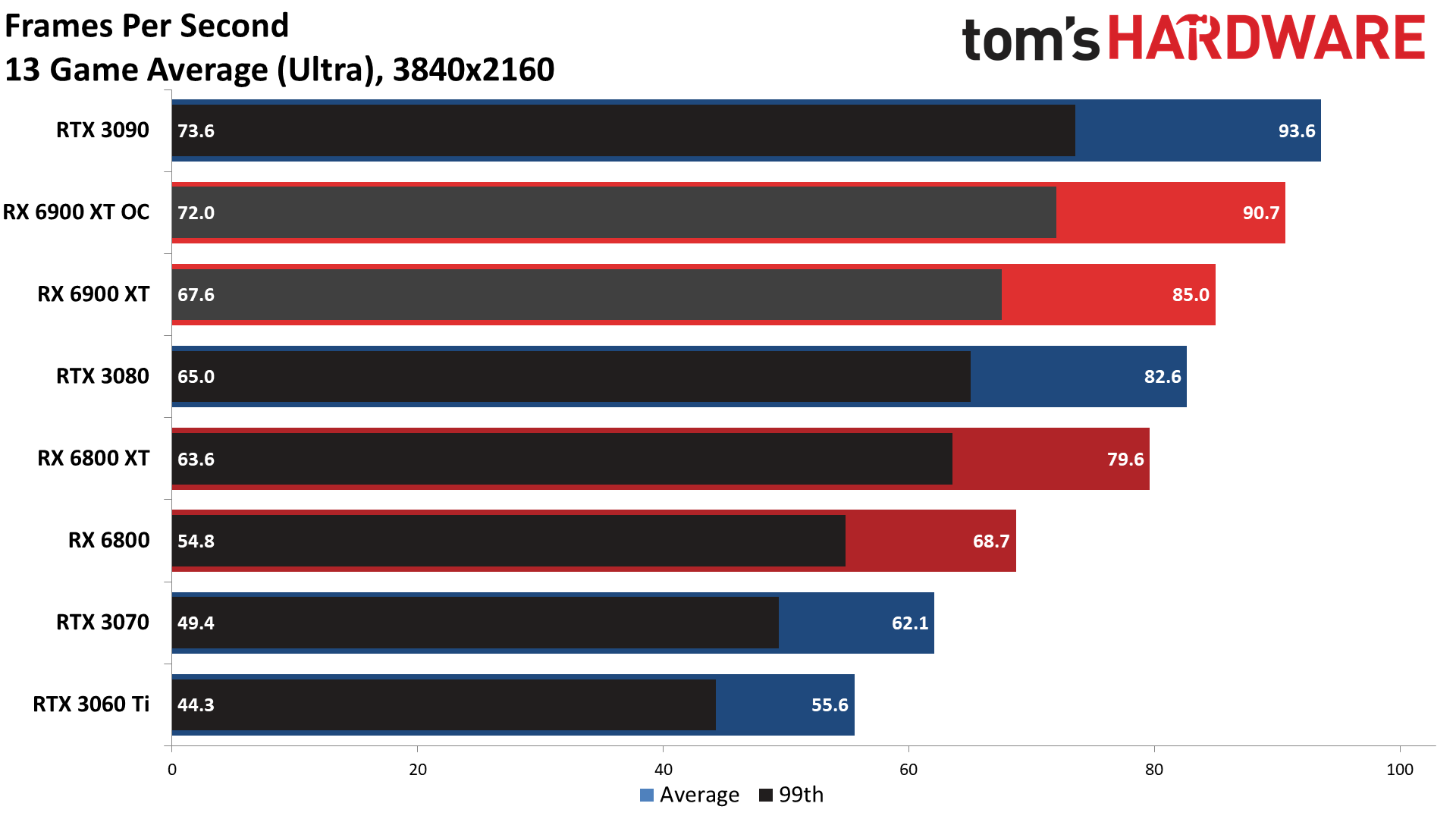
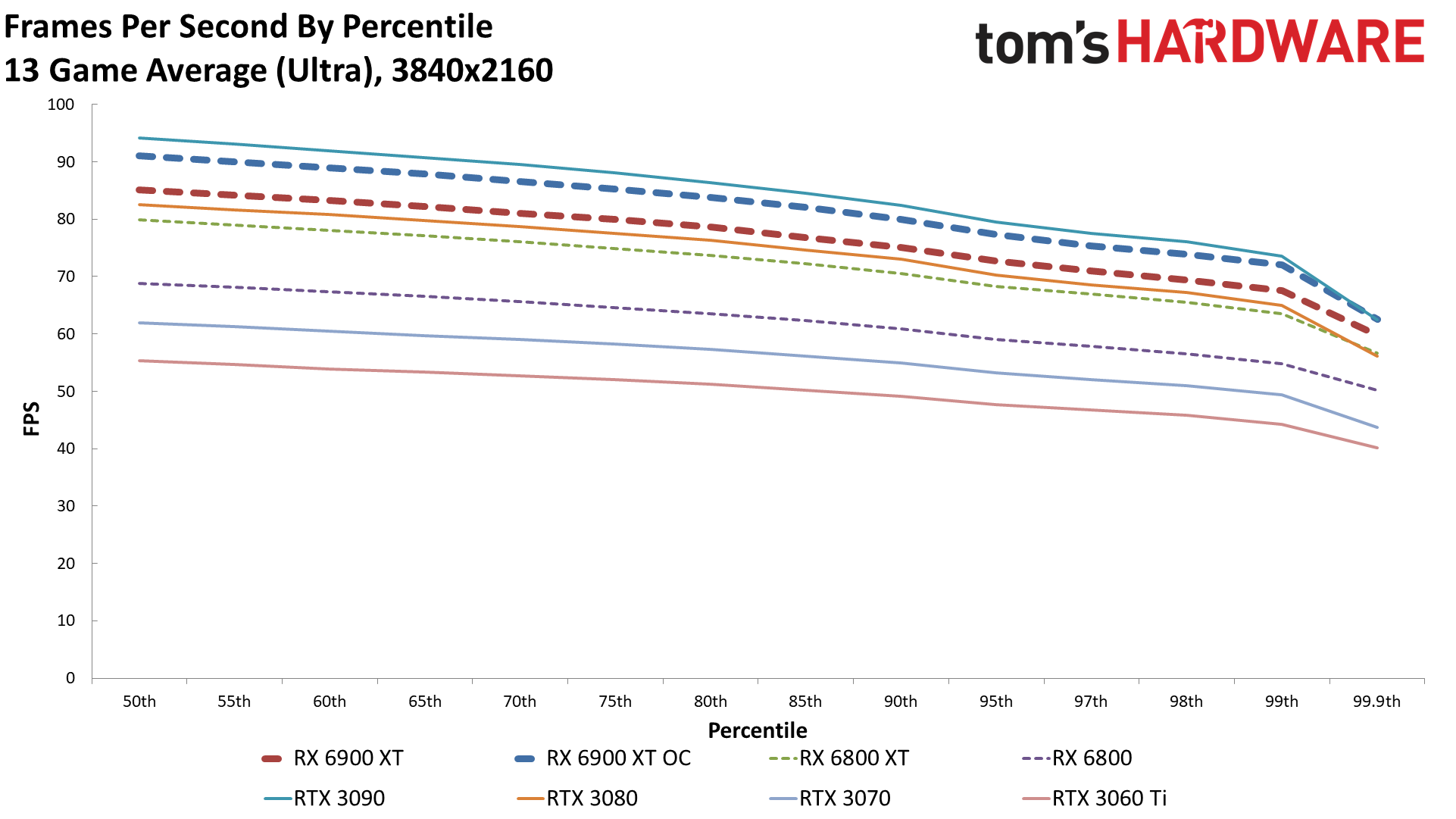
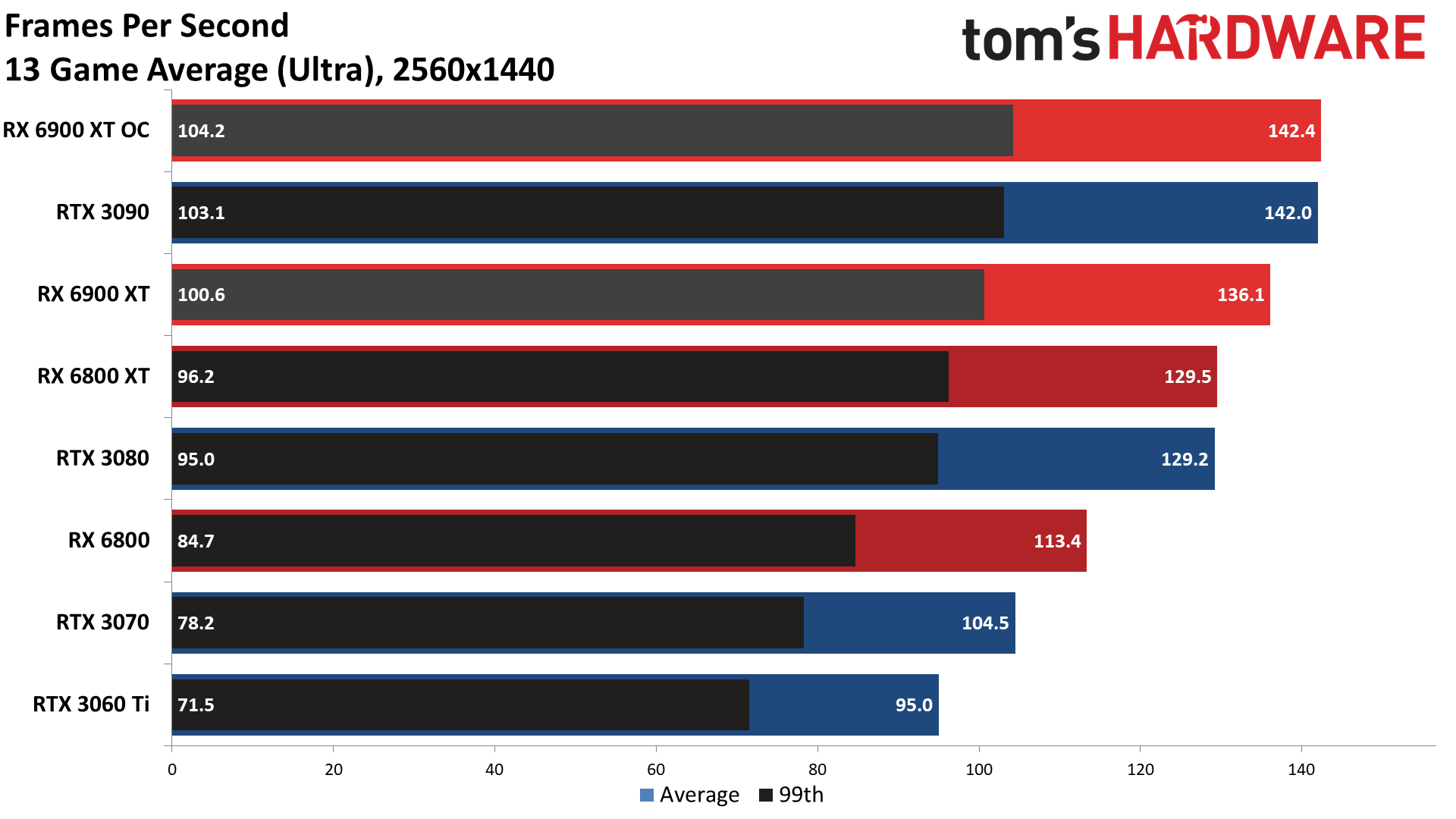
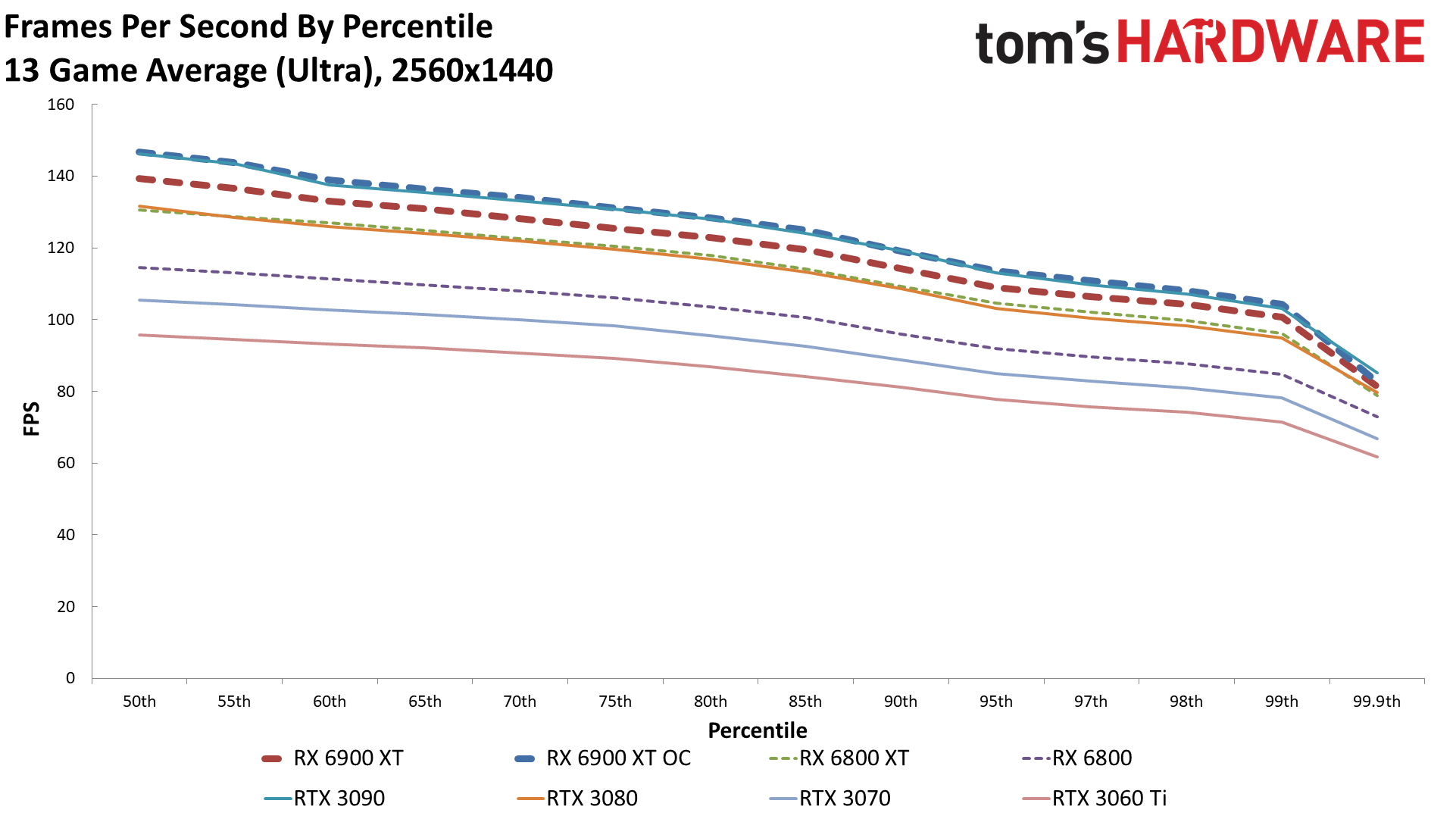
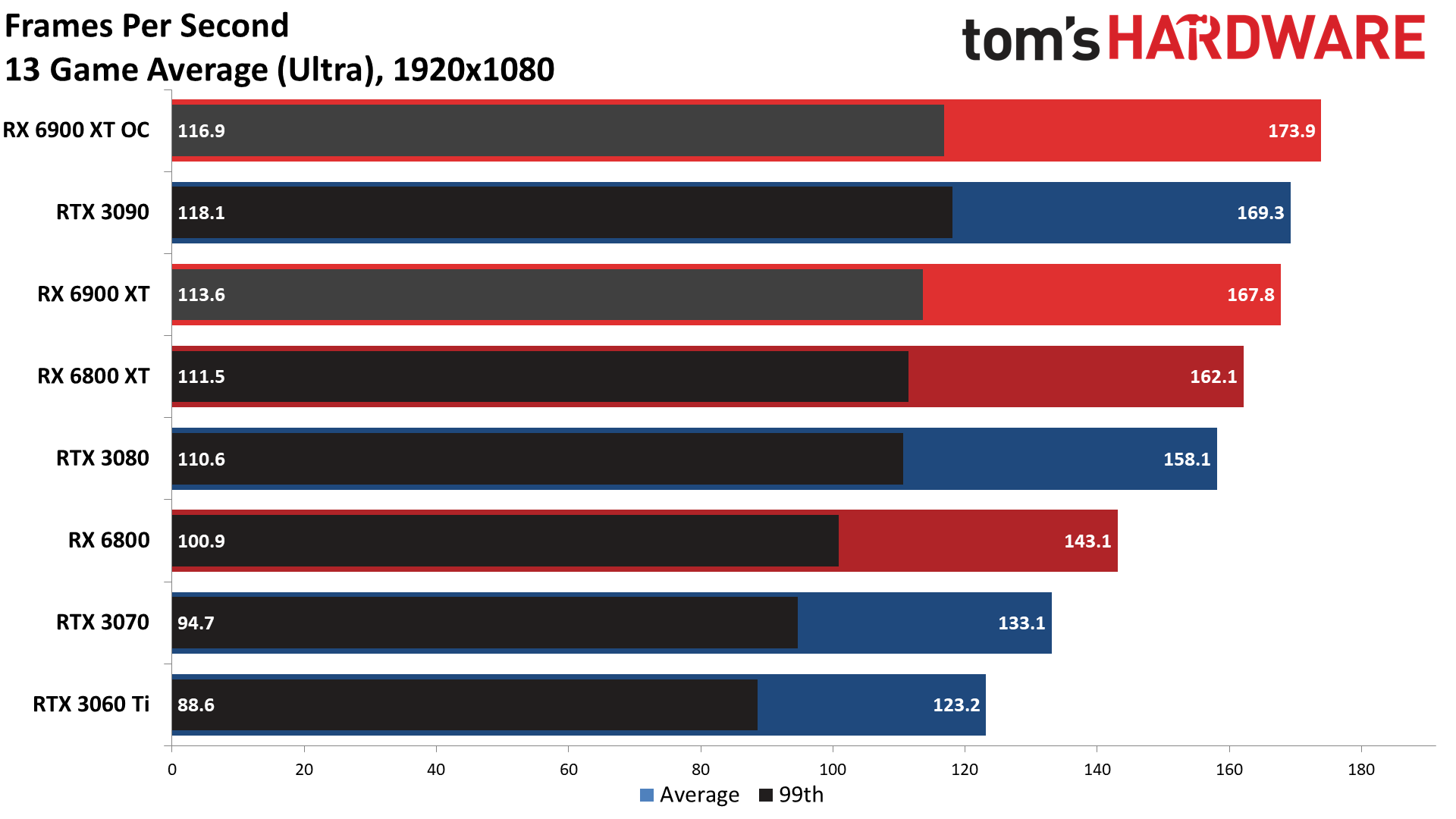
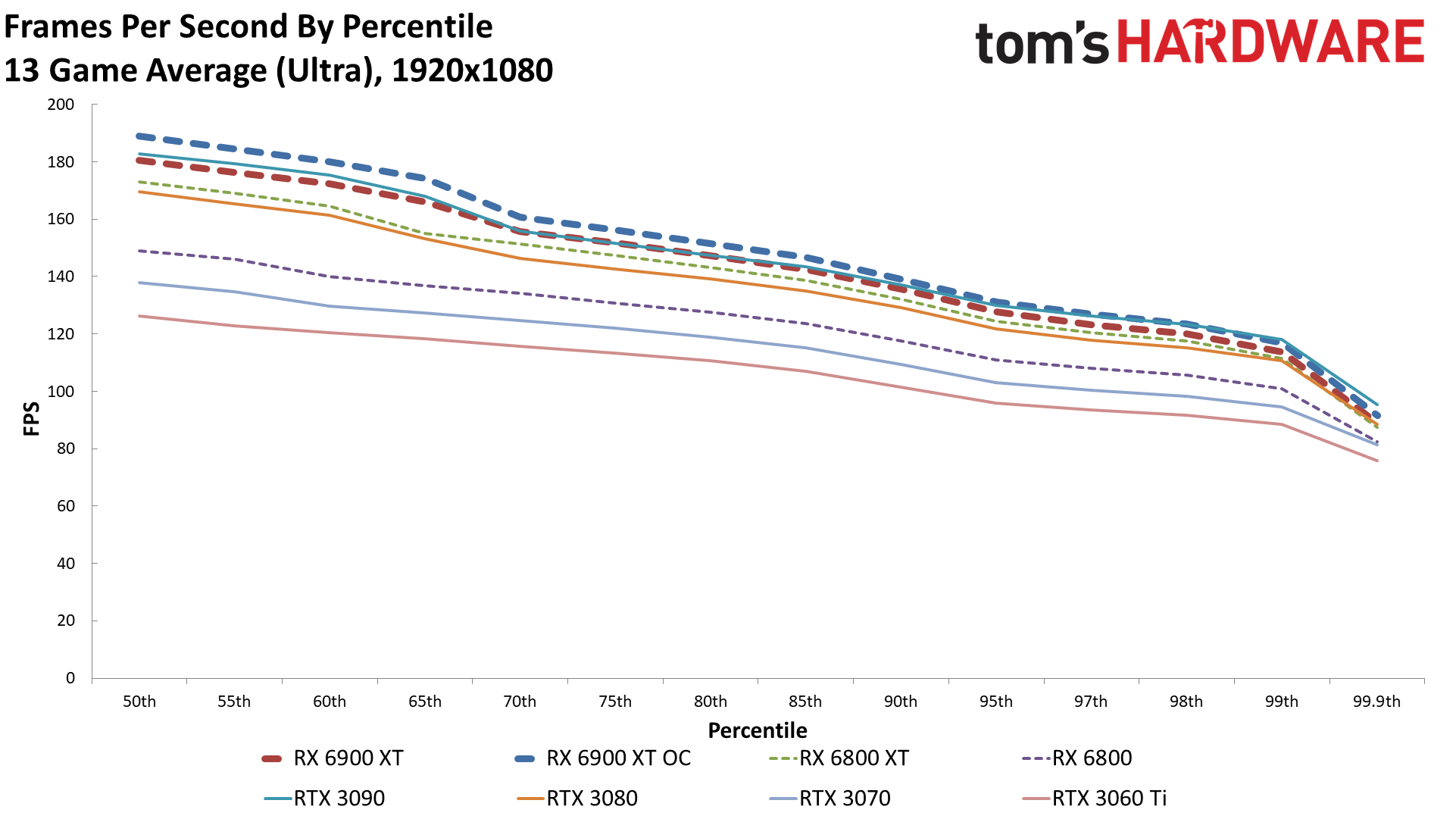
We've trimmed things down to just the latest generation Ampere and RDNA2 GPUs, though you can refer to our other reviews and GPU hierarchy for additional results. Given the specs, the RX 6900 XT performs just as we expected. It's generally around 5 percent (give or take 2 percent) faster than the RX 6800 XT. The drivers used for testing the RX 6900 XT are slightly newer as well and seem to have helped boost performance even more than the expected amount in a few games (Horizon Zero Dawn, specifically).
Overall, across the entire test suite, the RX 6900 XT is slightly faster than the RTX 3080, and it can beat the 3090 in a few cases. There are games where it falls behind, however, especially if a game supports ray tracing. How important is that? You'll have to decide. We generally like the RT effects in single player games but would leave them off in multiplayer where the fps drop is tough to take.
Get Tom's Hardware's best news and in-depth reviews, straight to your inbox.
From a value perspective, of course, the 6900 XT doesn't make any sense. Would you pay hundreds of dollars extra for five percent more performance with otherwise equivalent features and design? We wouldn't recommend that. Unless you really want that custom mouse pad. Or maybe if you use professional software where the boost in performance makes it worth your while (see below).
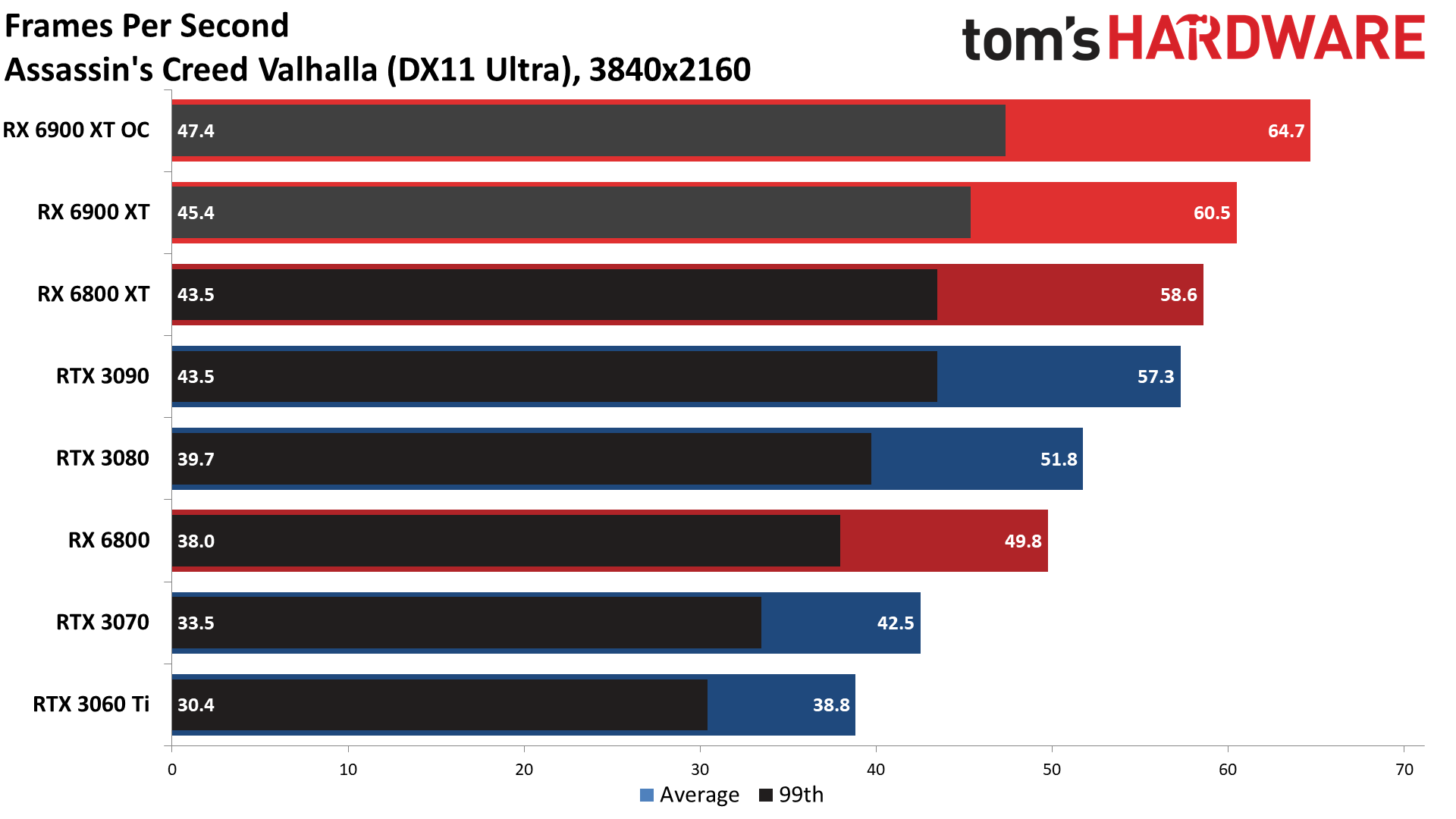
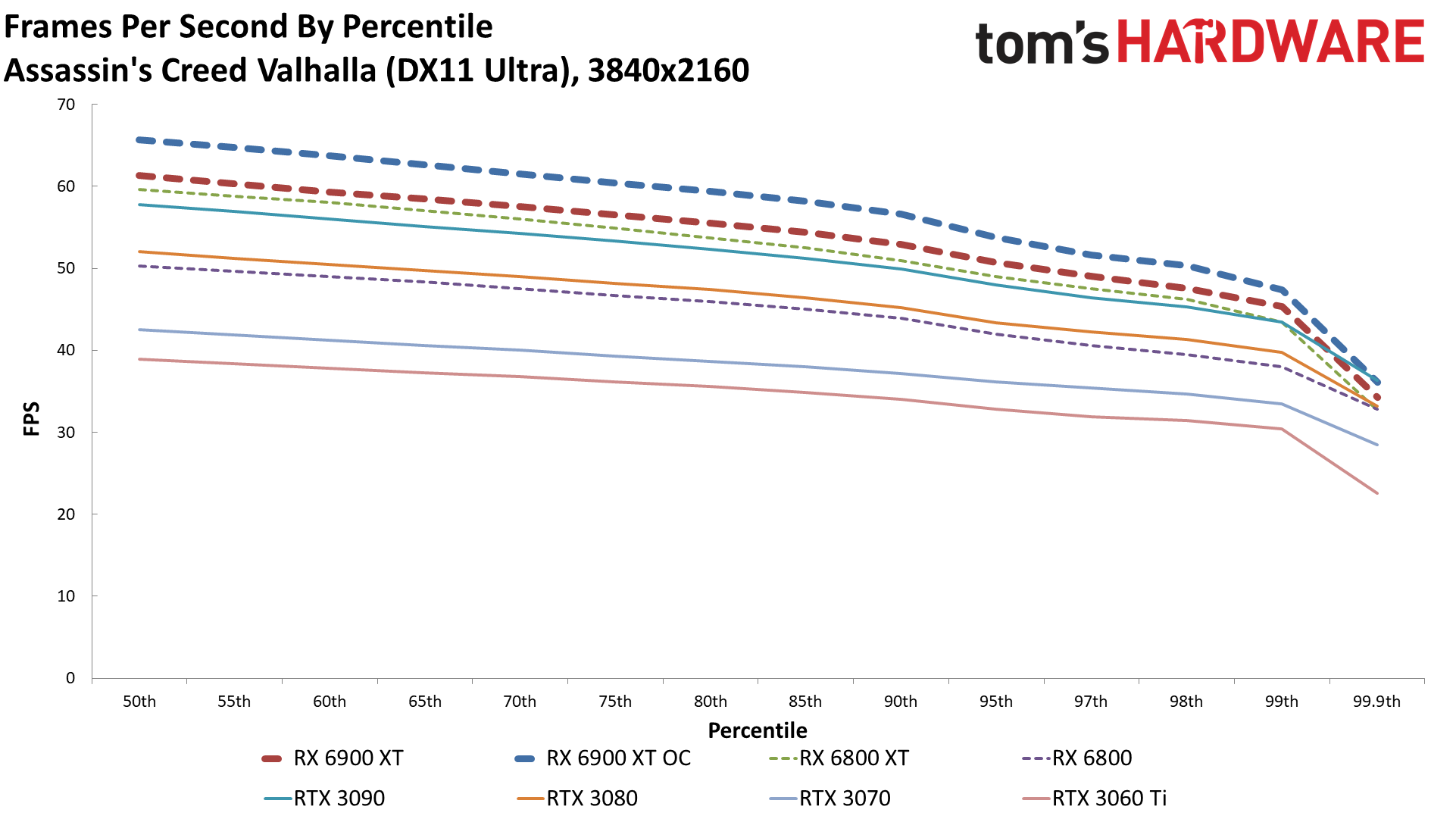
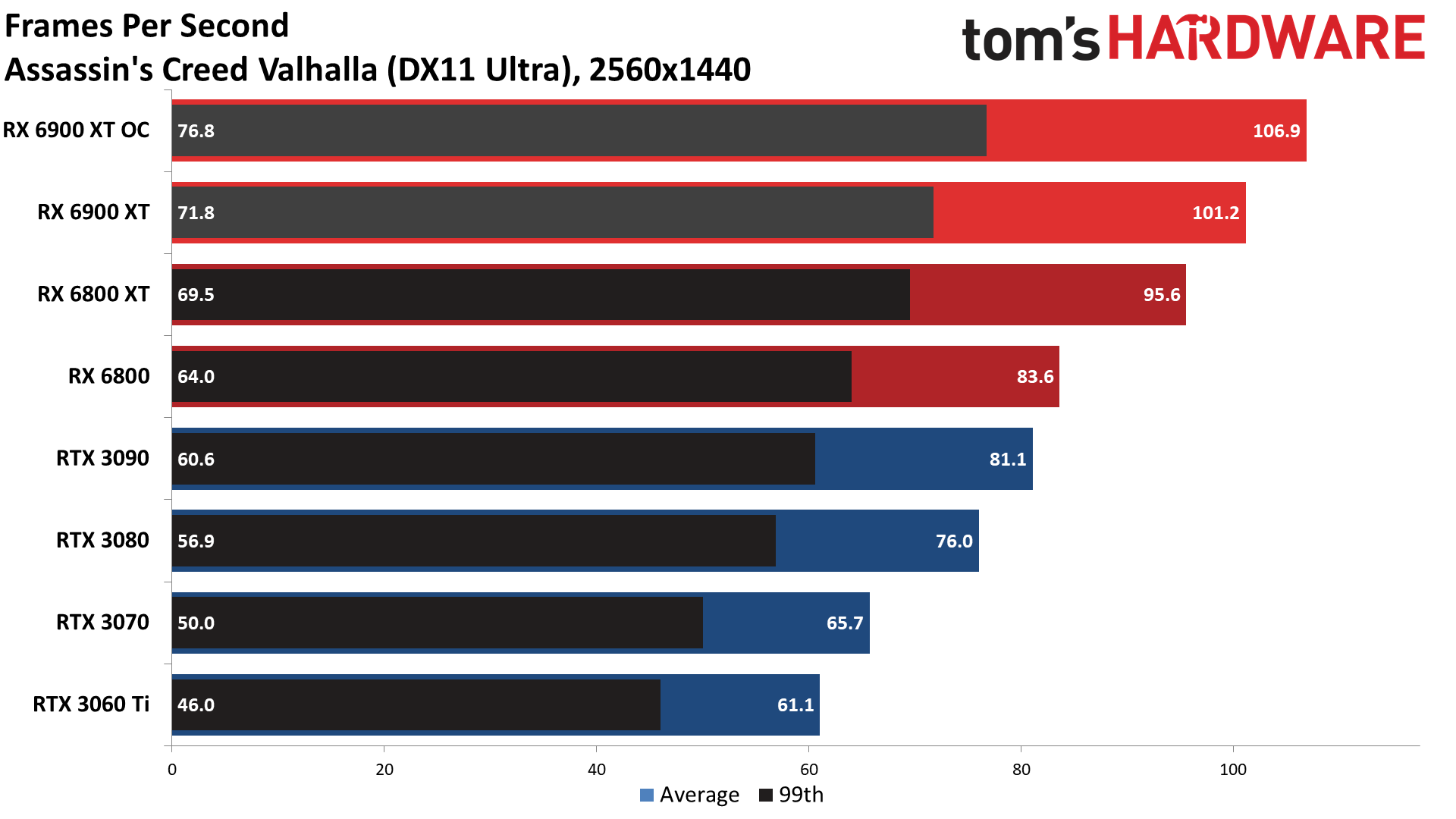
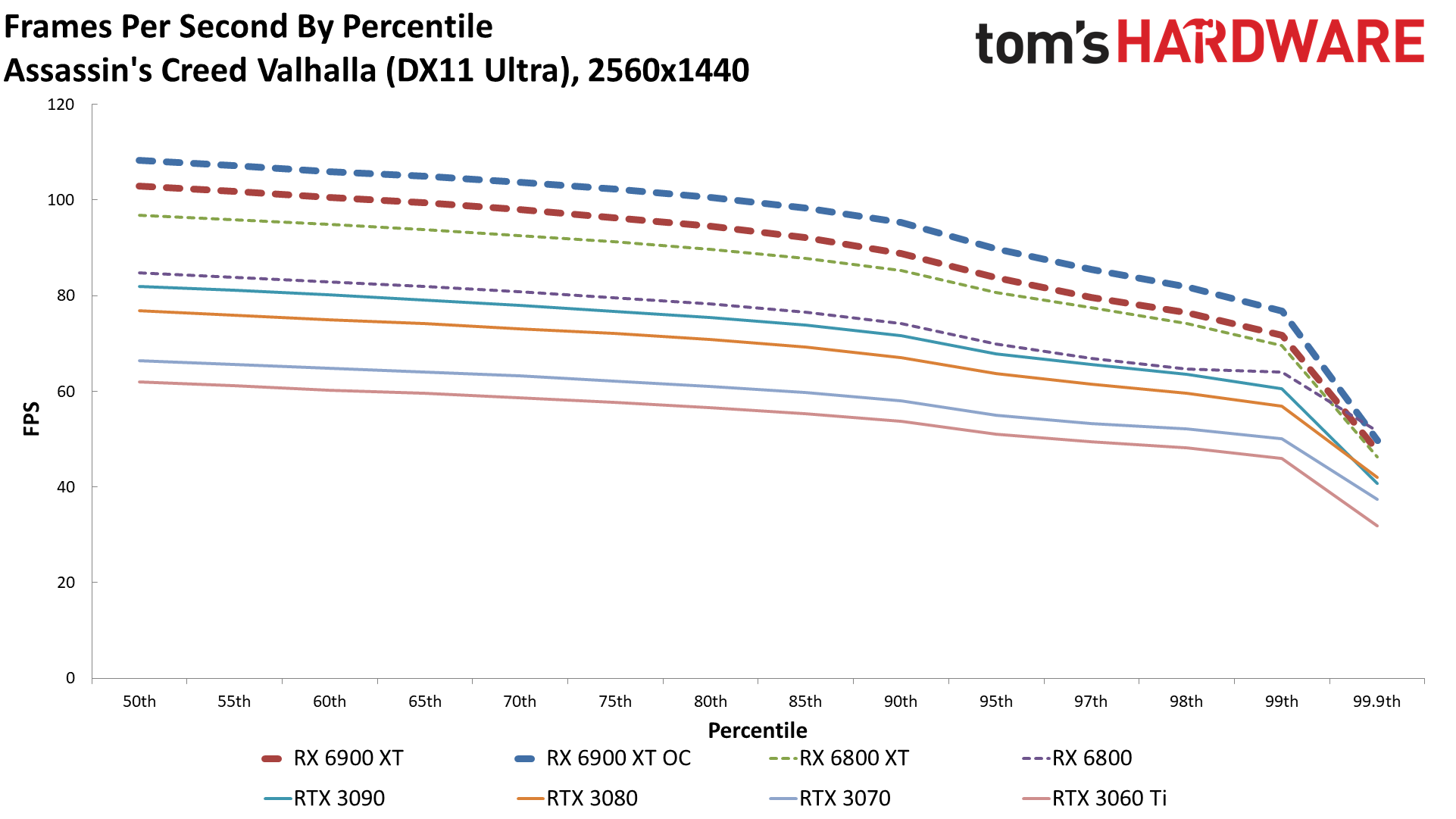
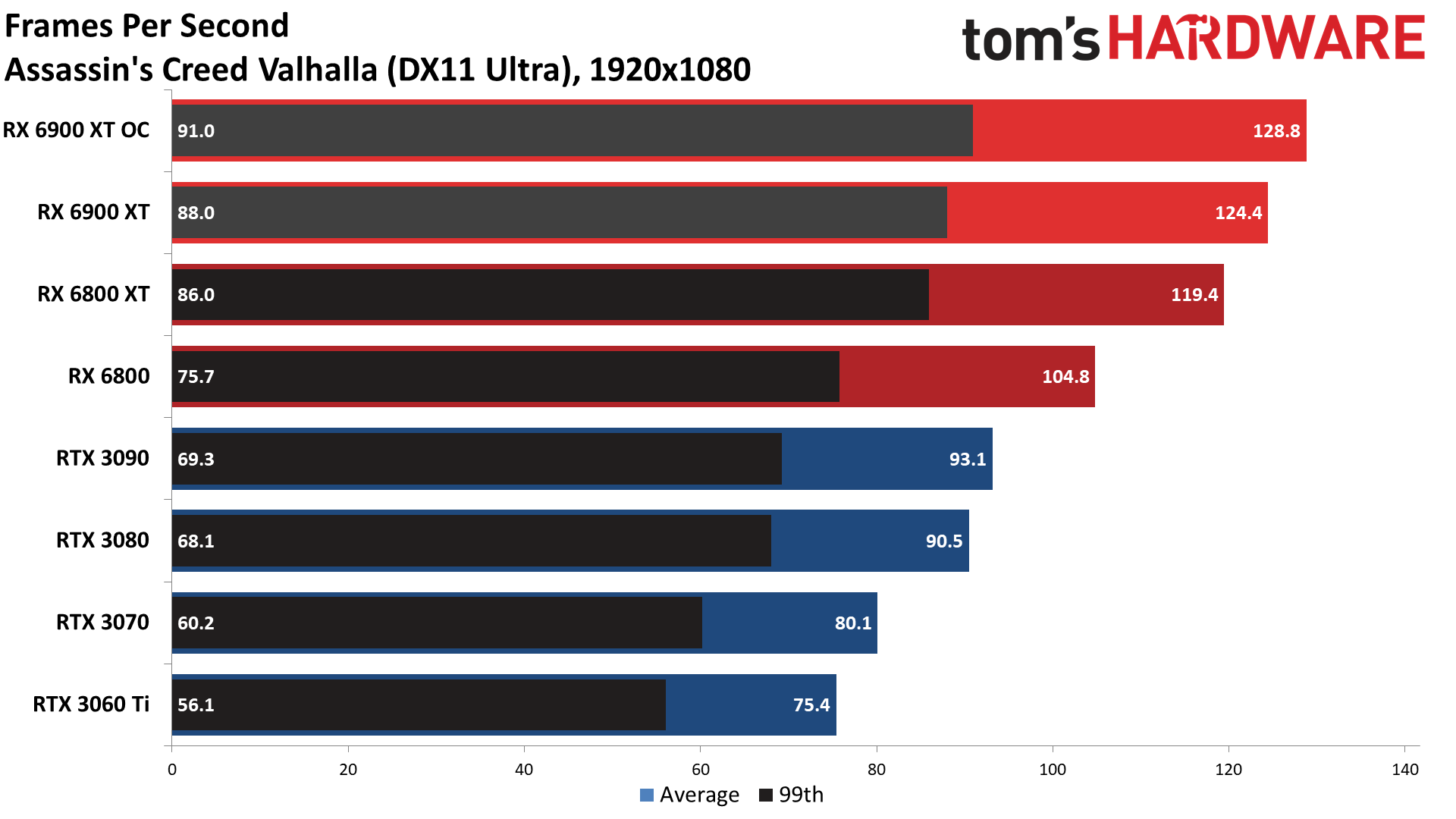
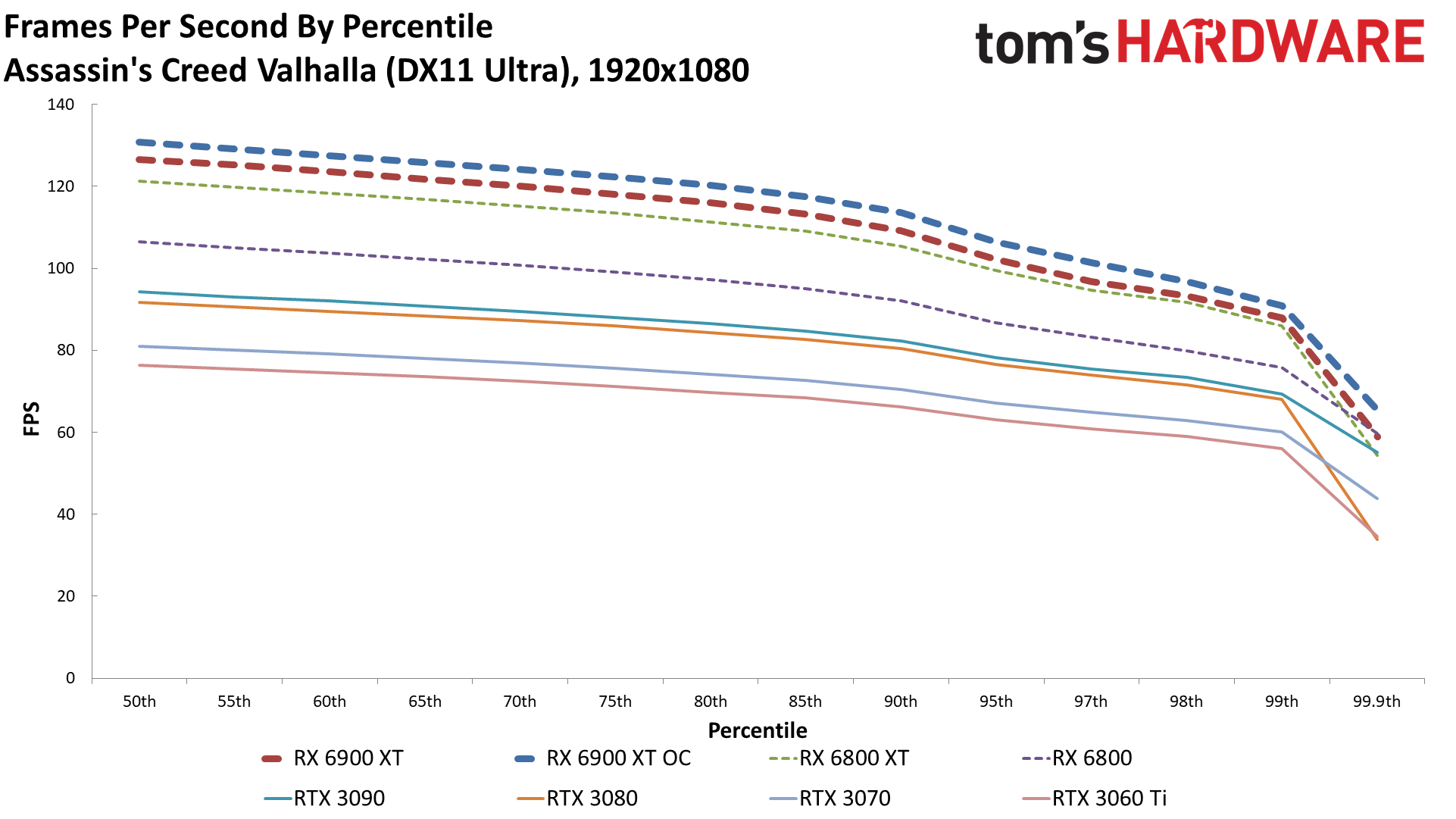
We'll go through the individual gaming results in alphabetical order, which means Assassin's Creed Valhalla is up first. As a recent release promoted by AMD, it's perhaps not too surprising to see the RX 6900 XT at the top of the charts. Still, that's a significant lead for AMD at 1440p and 1080p. We're not sure what exactly is going on within the game code that would make it favor AMD's architecture this much, but as a DX11 game, it's entirely possible Nvidia will have updated drivers that improve performance with RTX cards. For now, AMD wins this one easily.
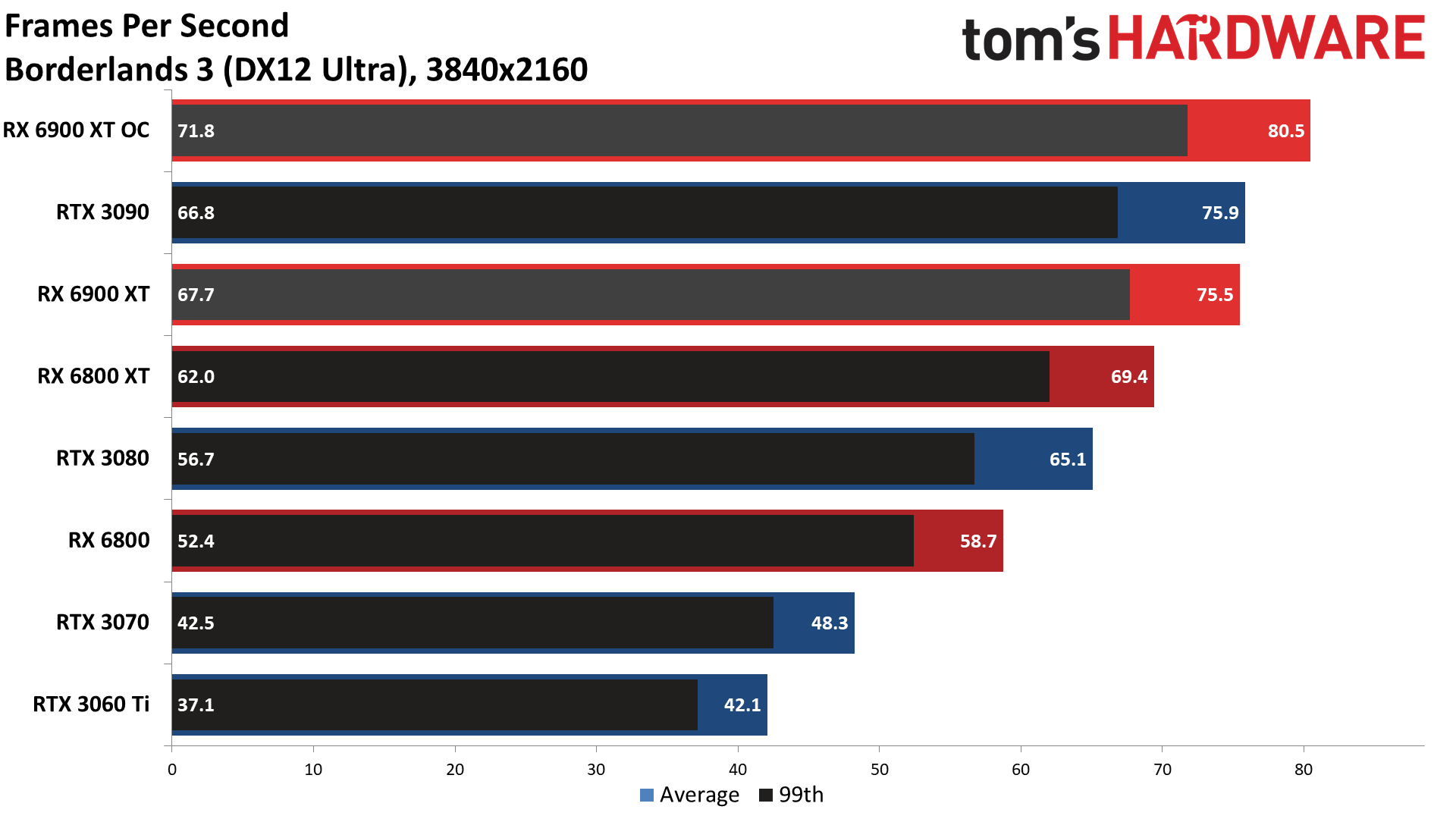
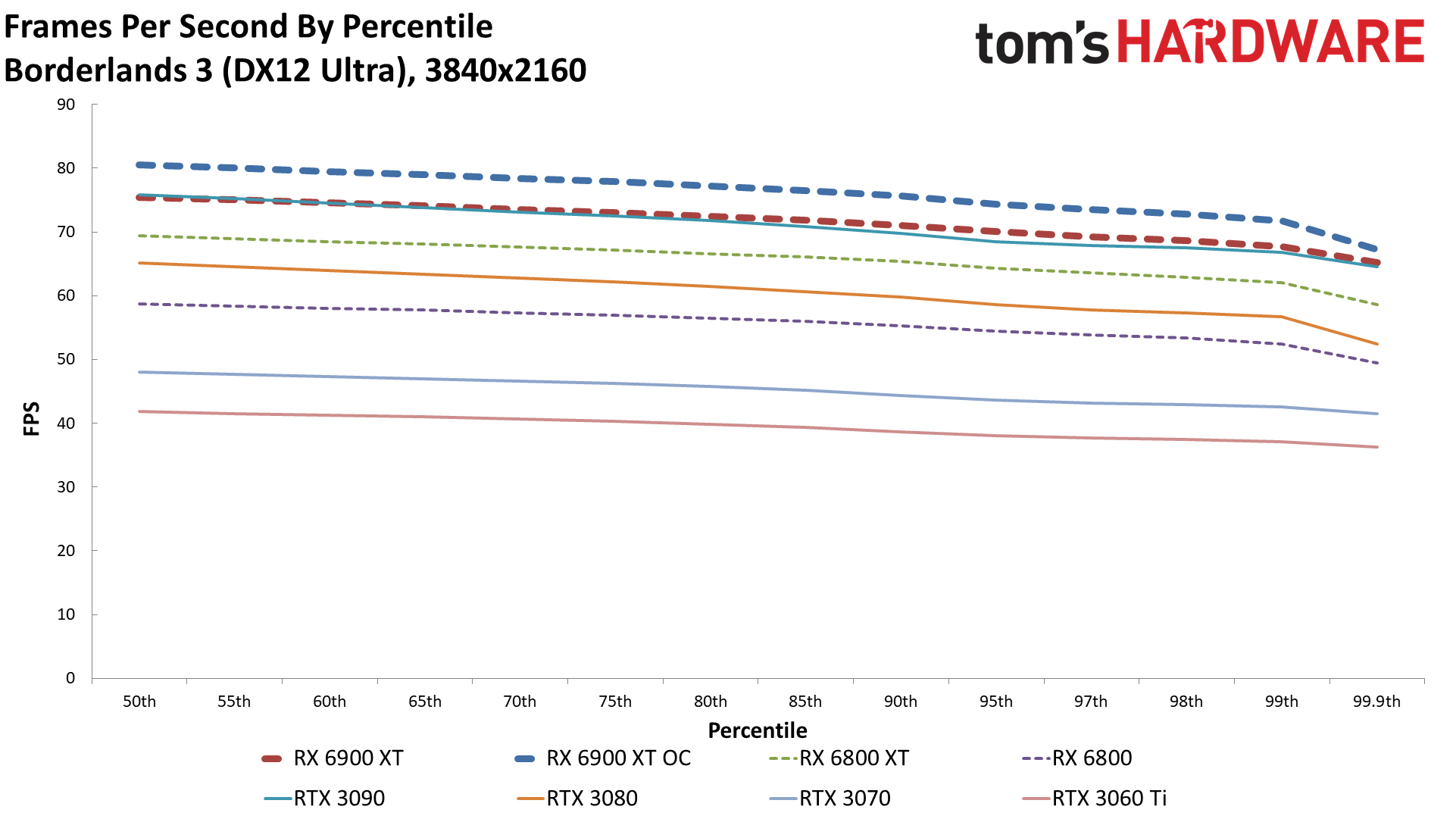
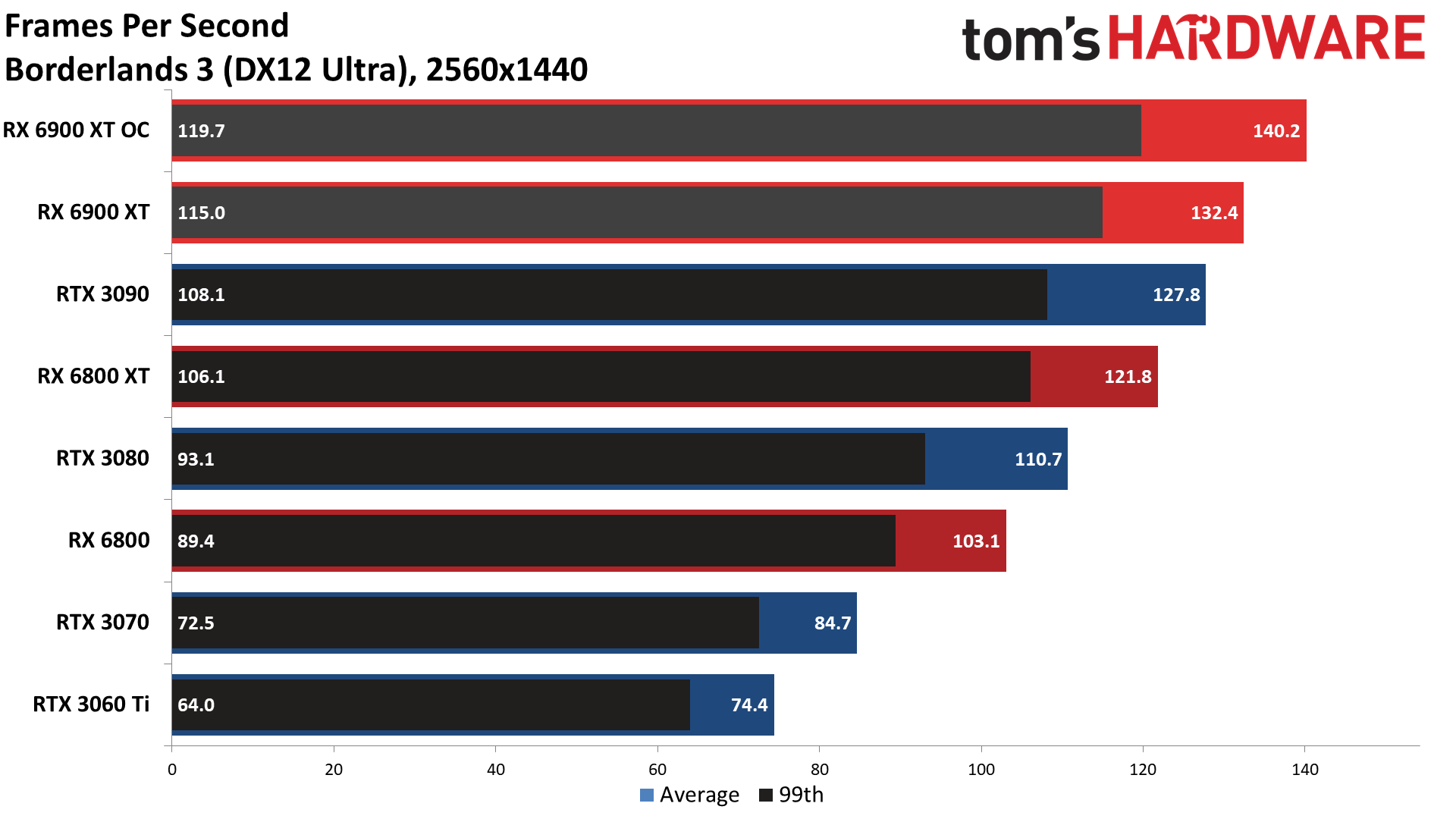
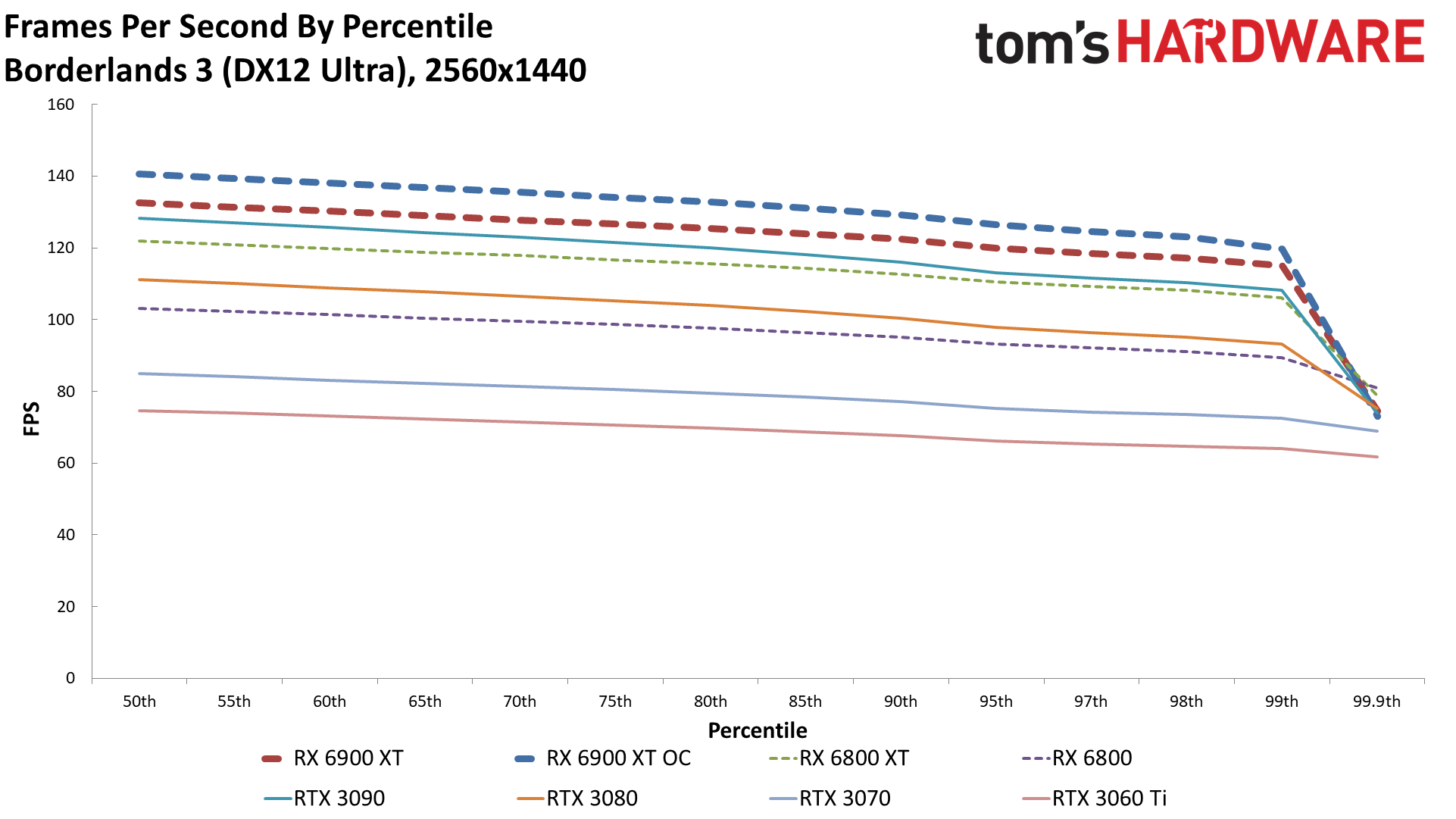
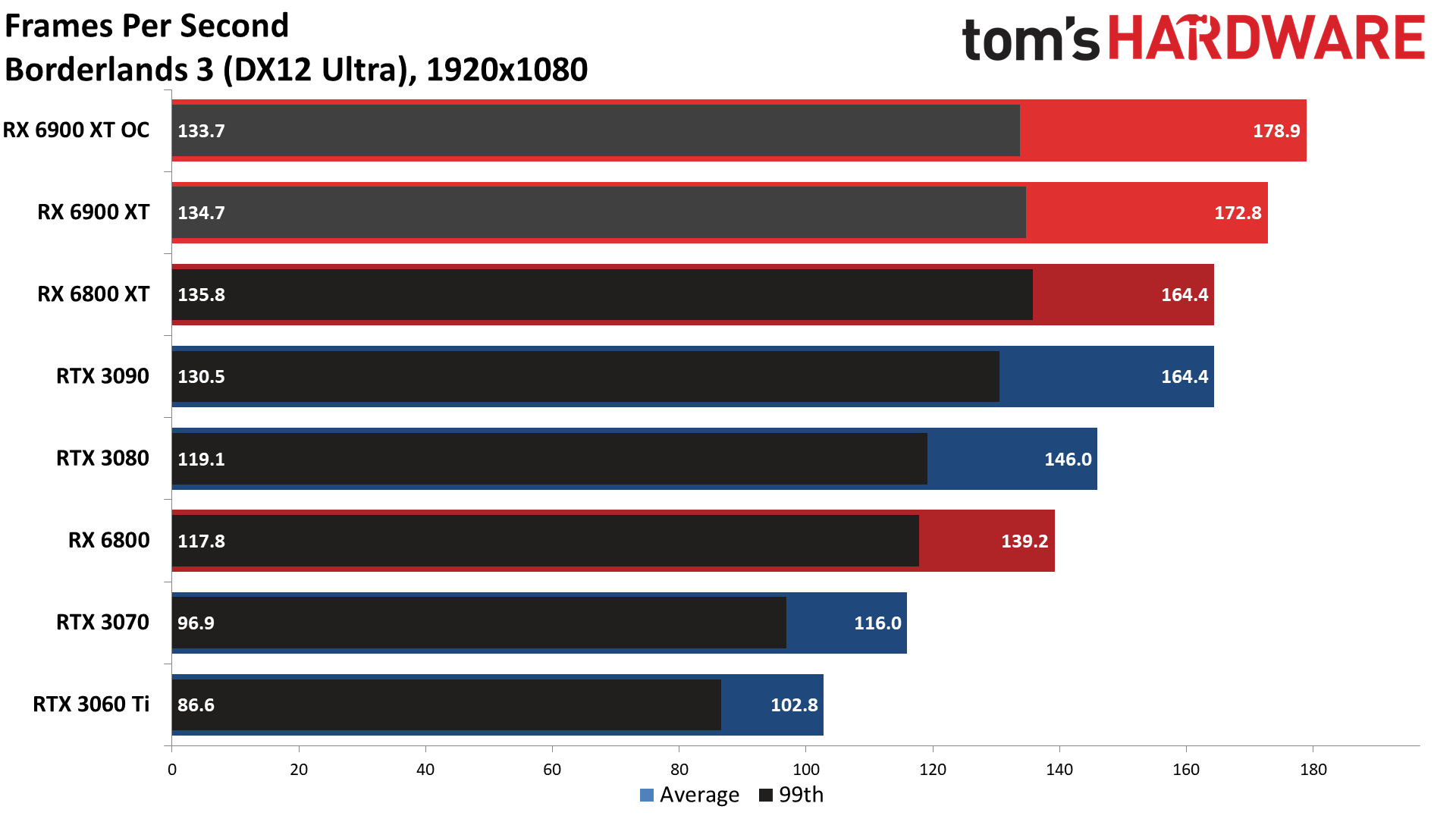
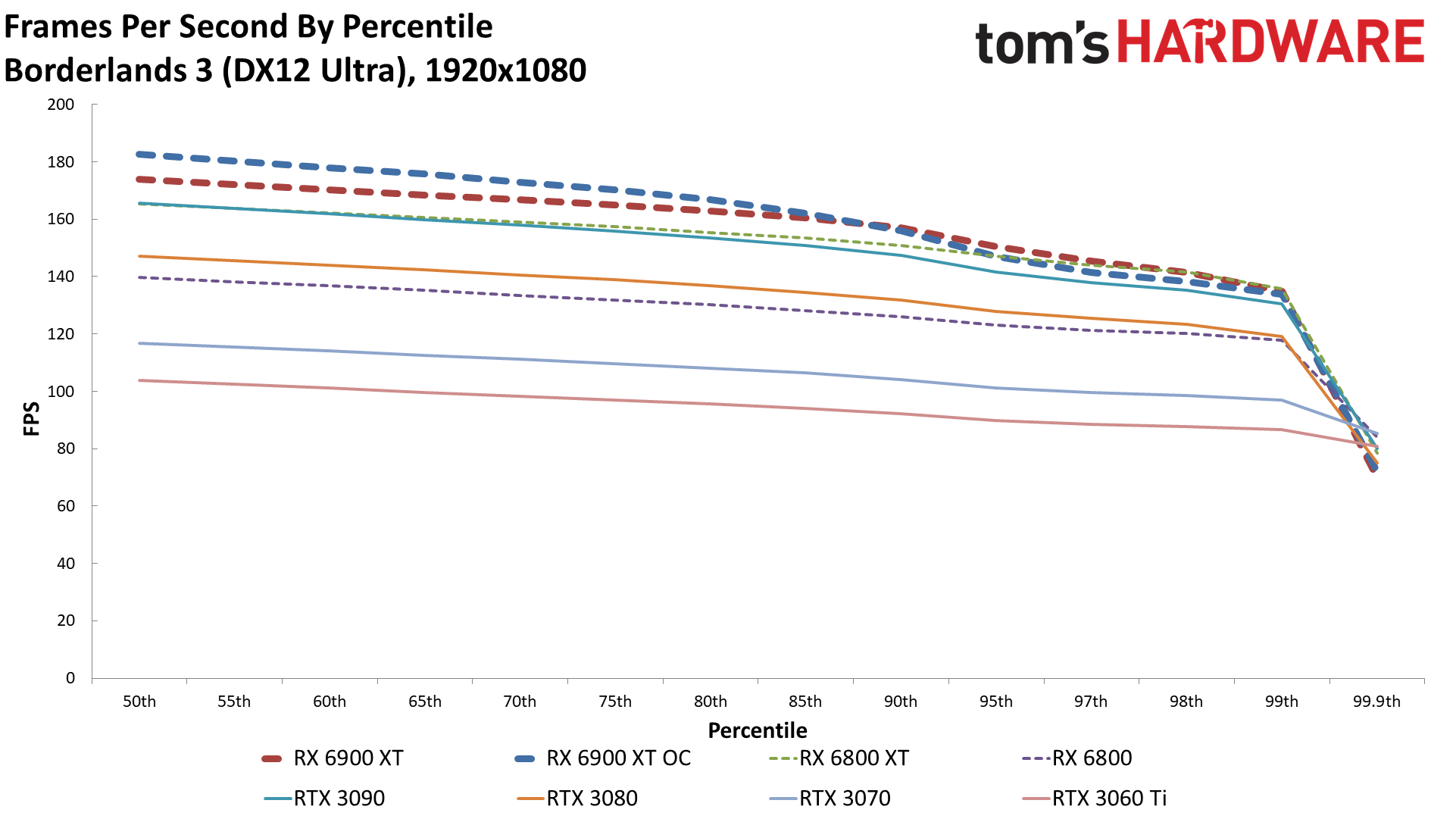
Borderlands 3 is another AMD promotional game, and the 6900 XT basically ties the RTX 3090 at 4K ultra. Dropping down to 1440p and 1080p, it even comes out ahead of the top Nvidia chip. We see a similar trend down through the other GPUs, with the 6800 XT leading the 3080, and the 6800 beating the RTX 3070. If BL3 is a game you care about, AMD takes this one as well.
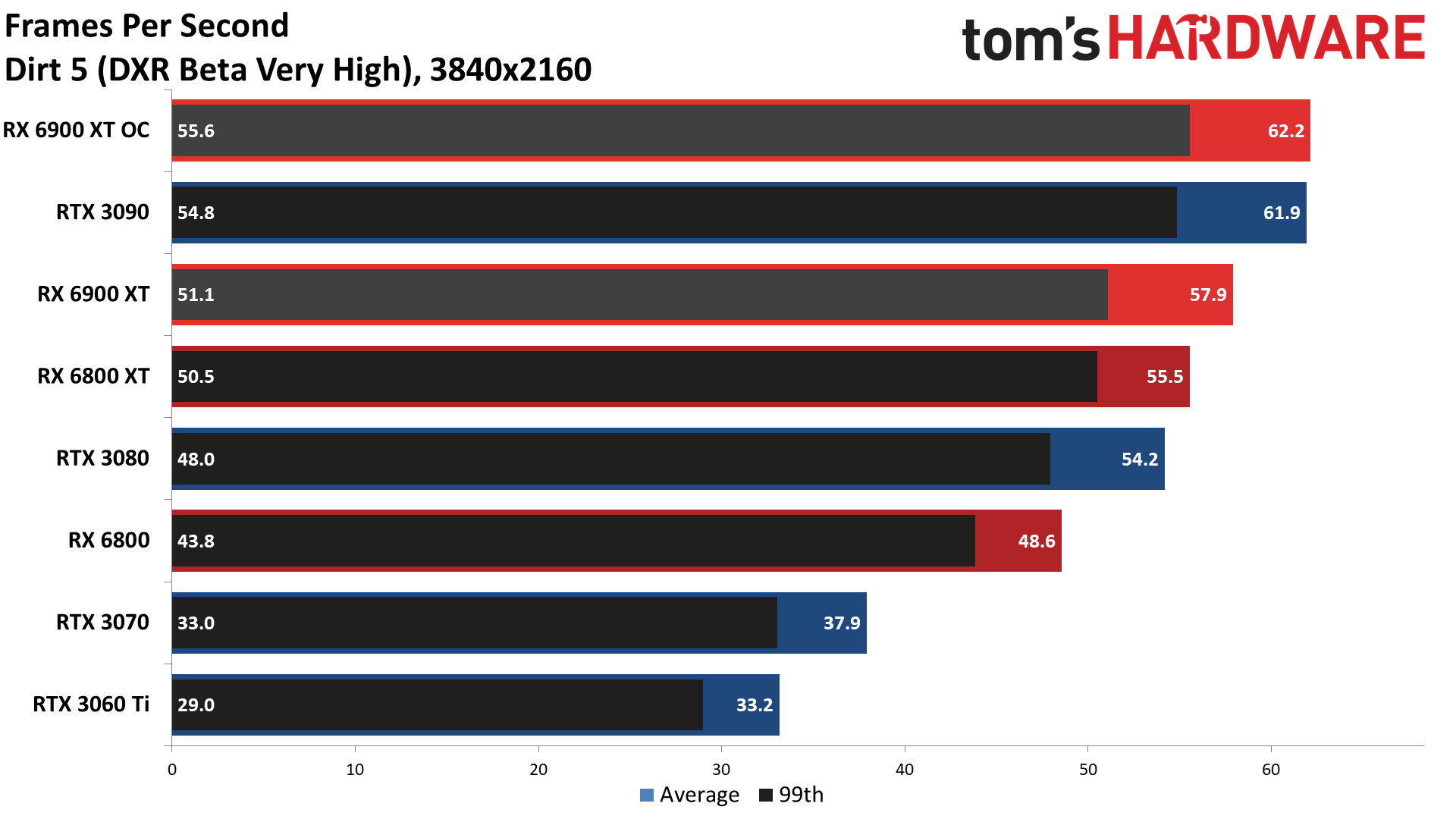
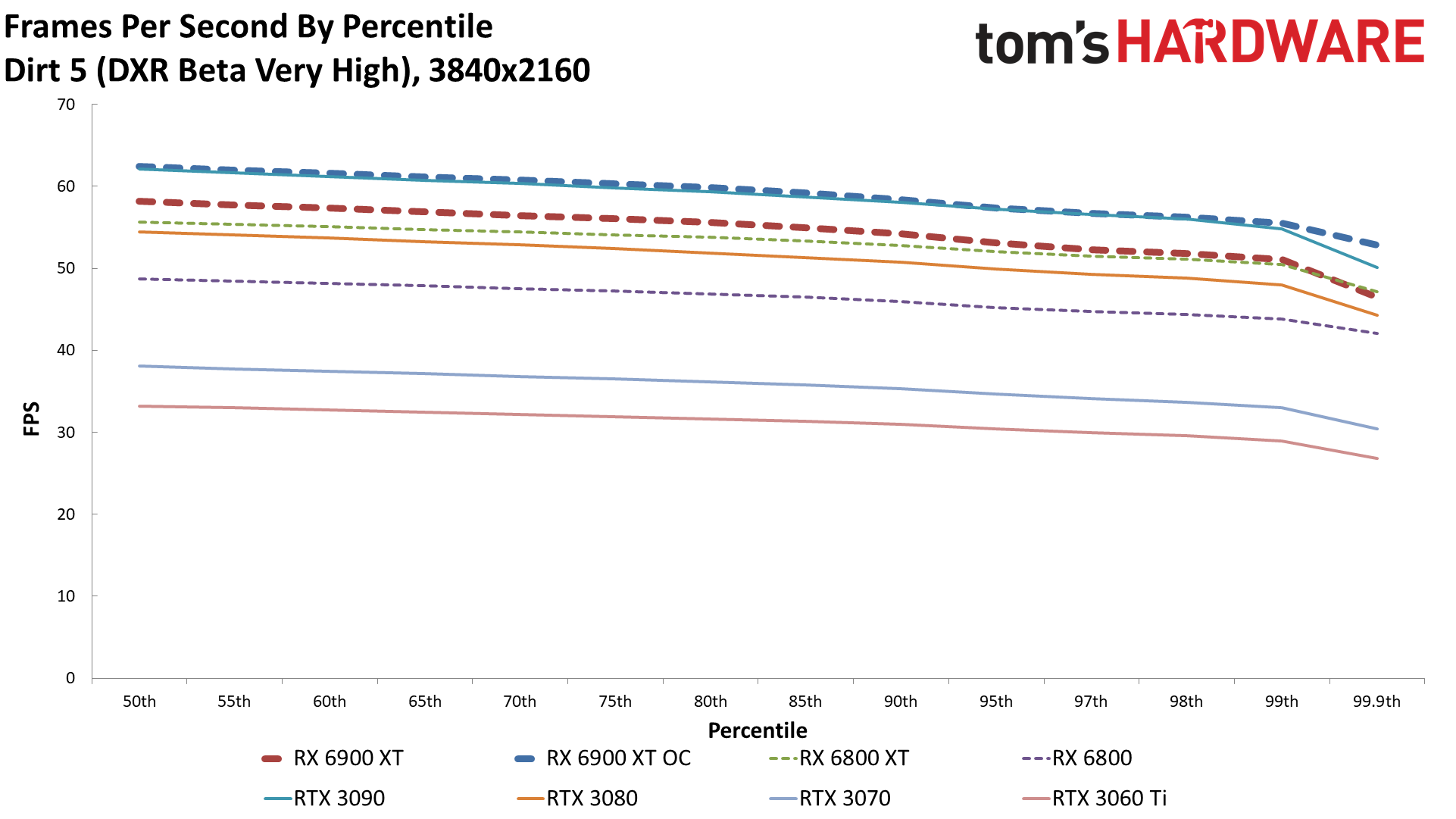
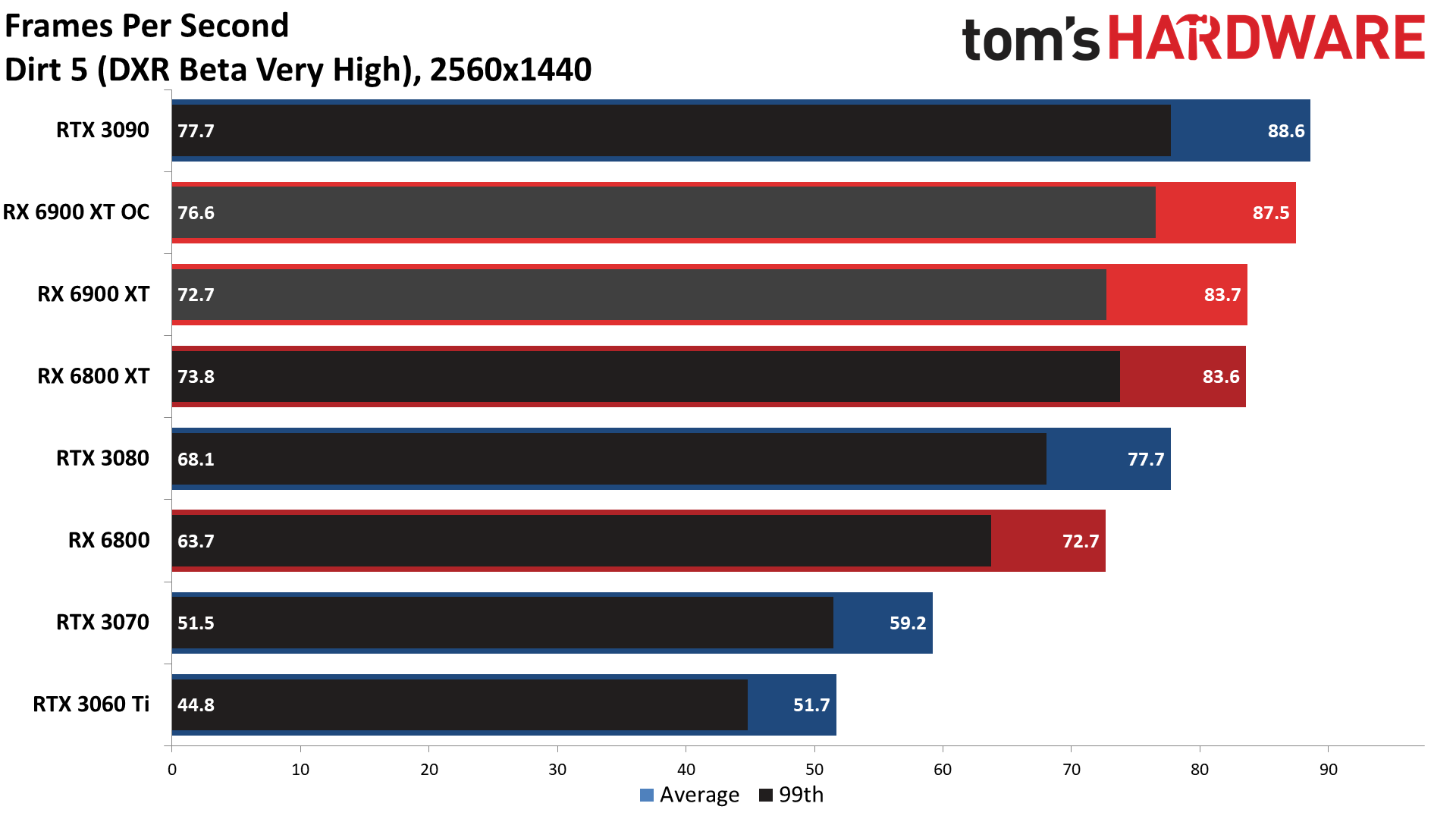
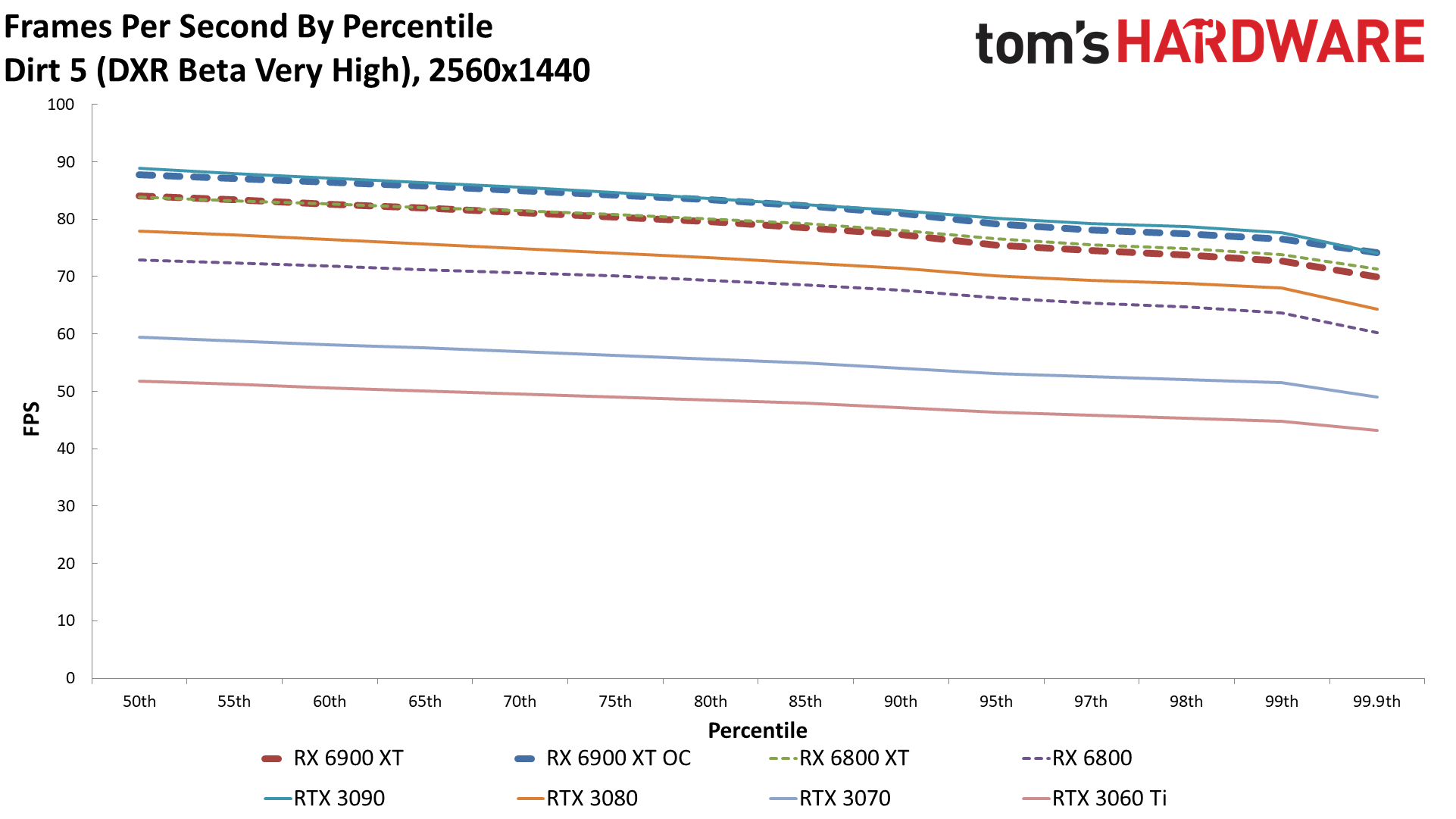
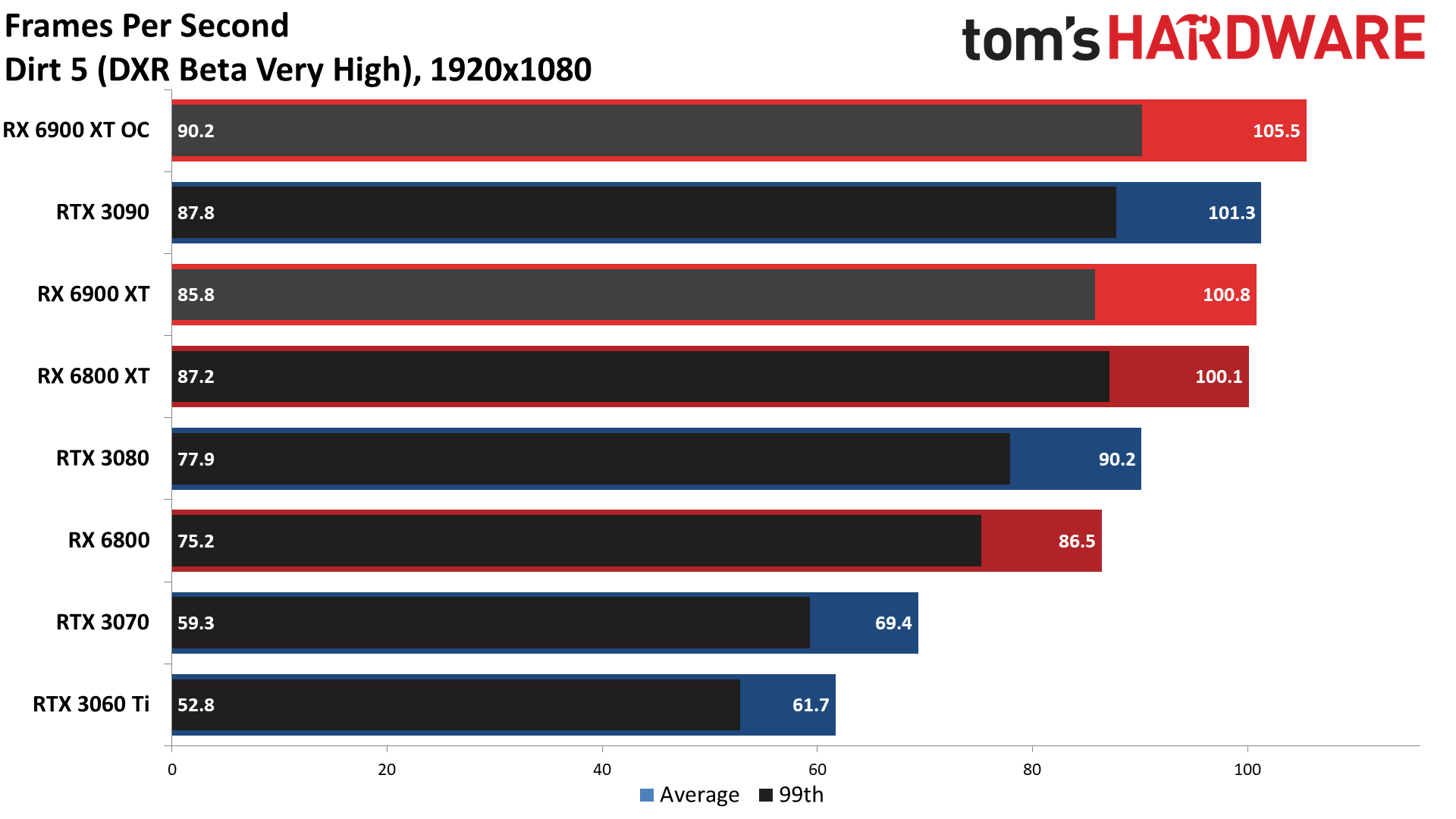
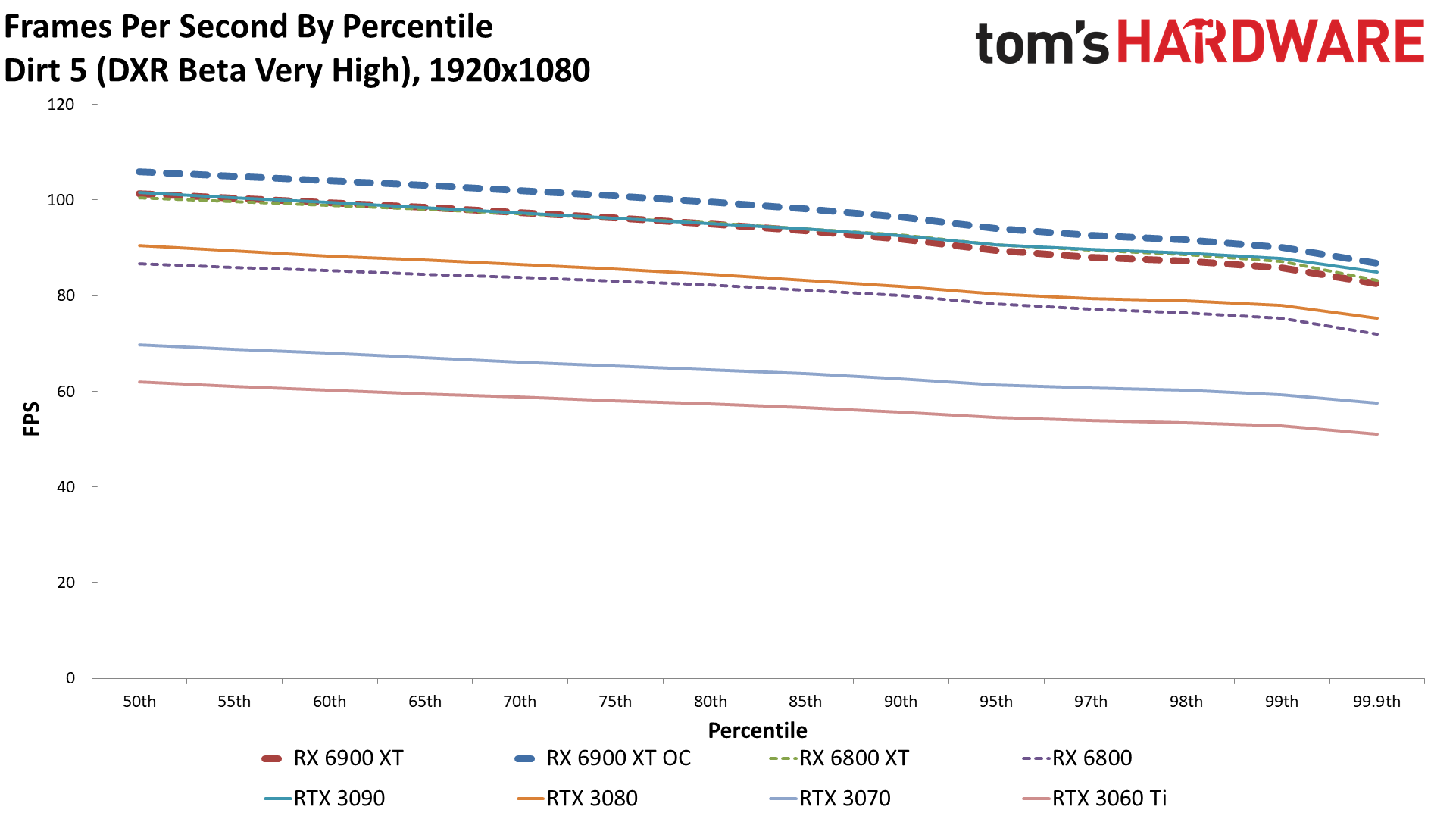
A huge caveat here: Dirt 5 is an AMD promotional game, and we're using a beta / early access DXR patch. Given what we'll see below, either it's possible for game developers to do ray tracing in a way that dramatically favors AMD, or — more likely — the DXR implementation is very suboptimal on Nvidia right now. There are only three games currently being promoted by AMD that feature ray tracing effects, and two of those won't run on Nvidia GPUs right now, so again, these results aren't perhaps the best.
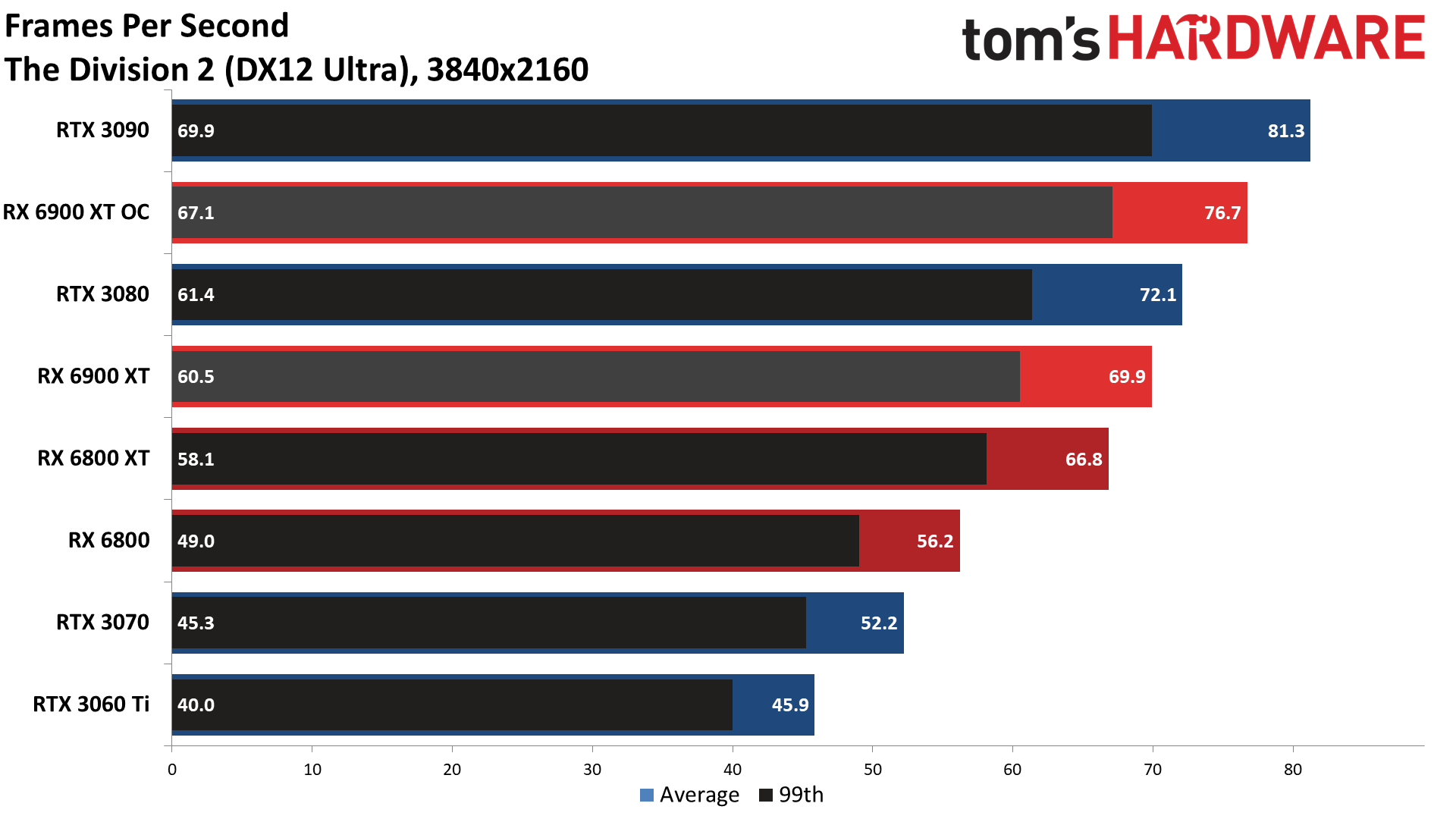
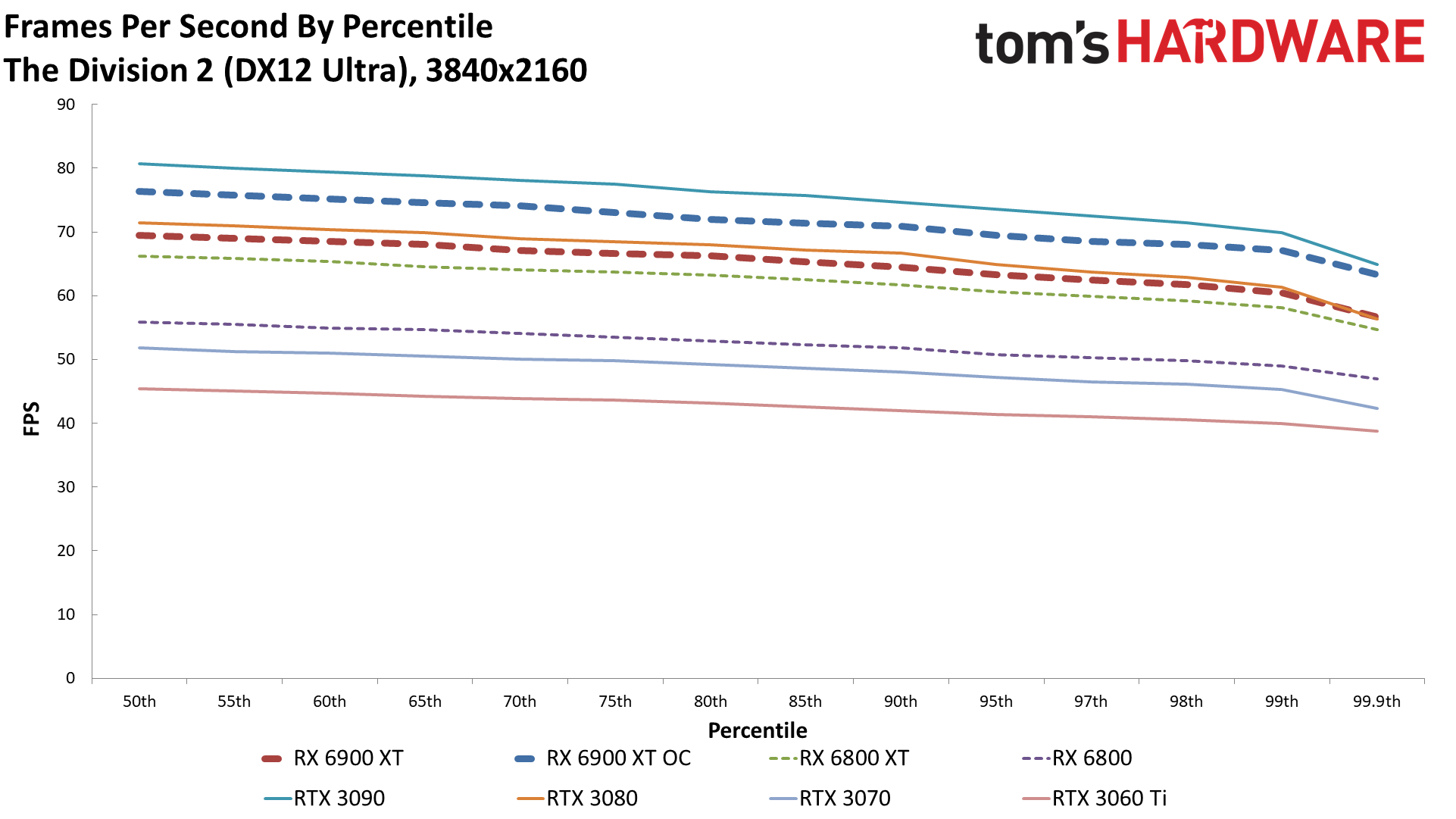
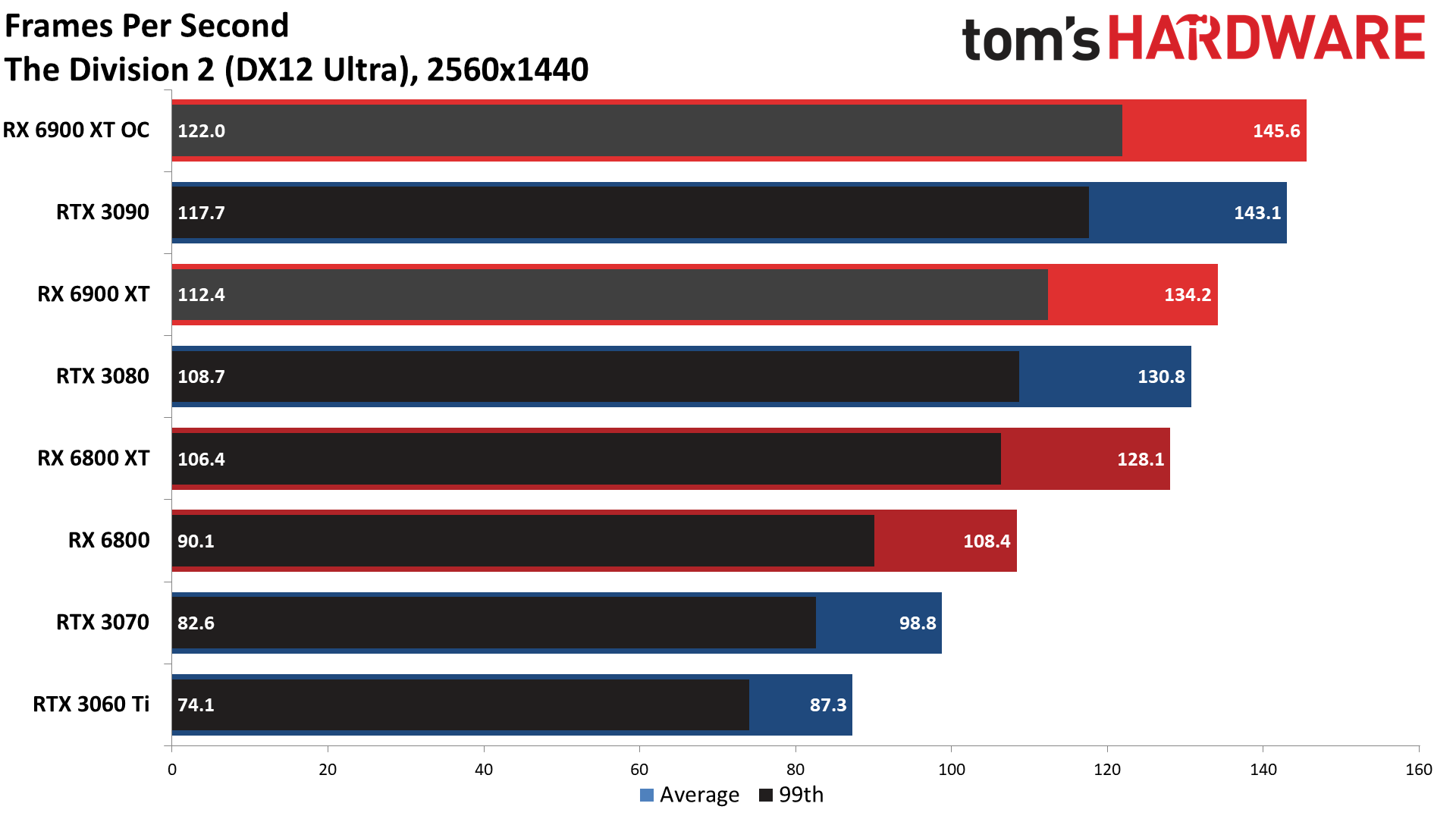
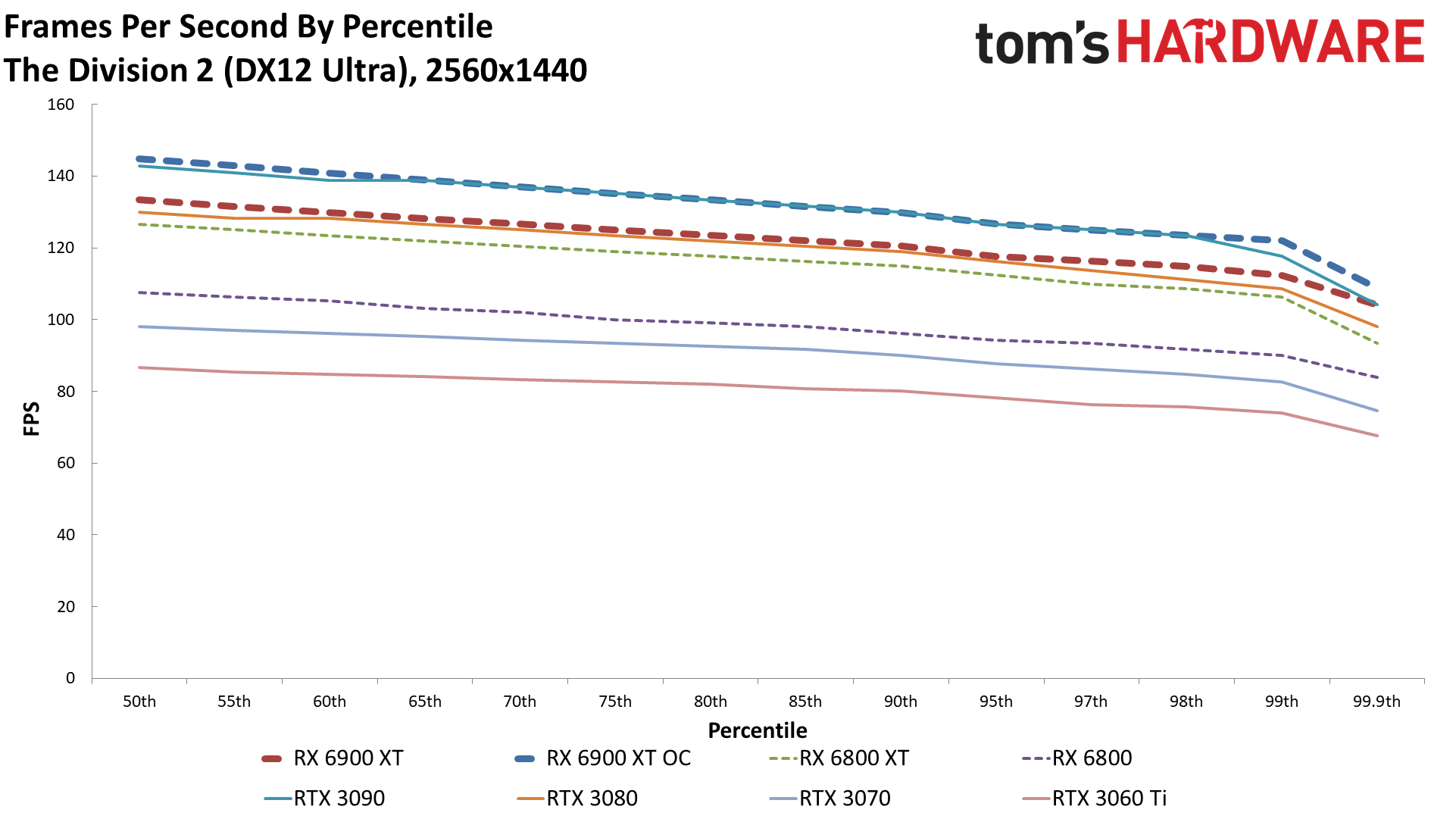
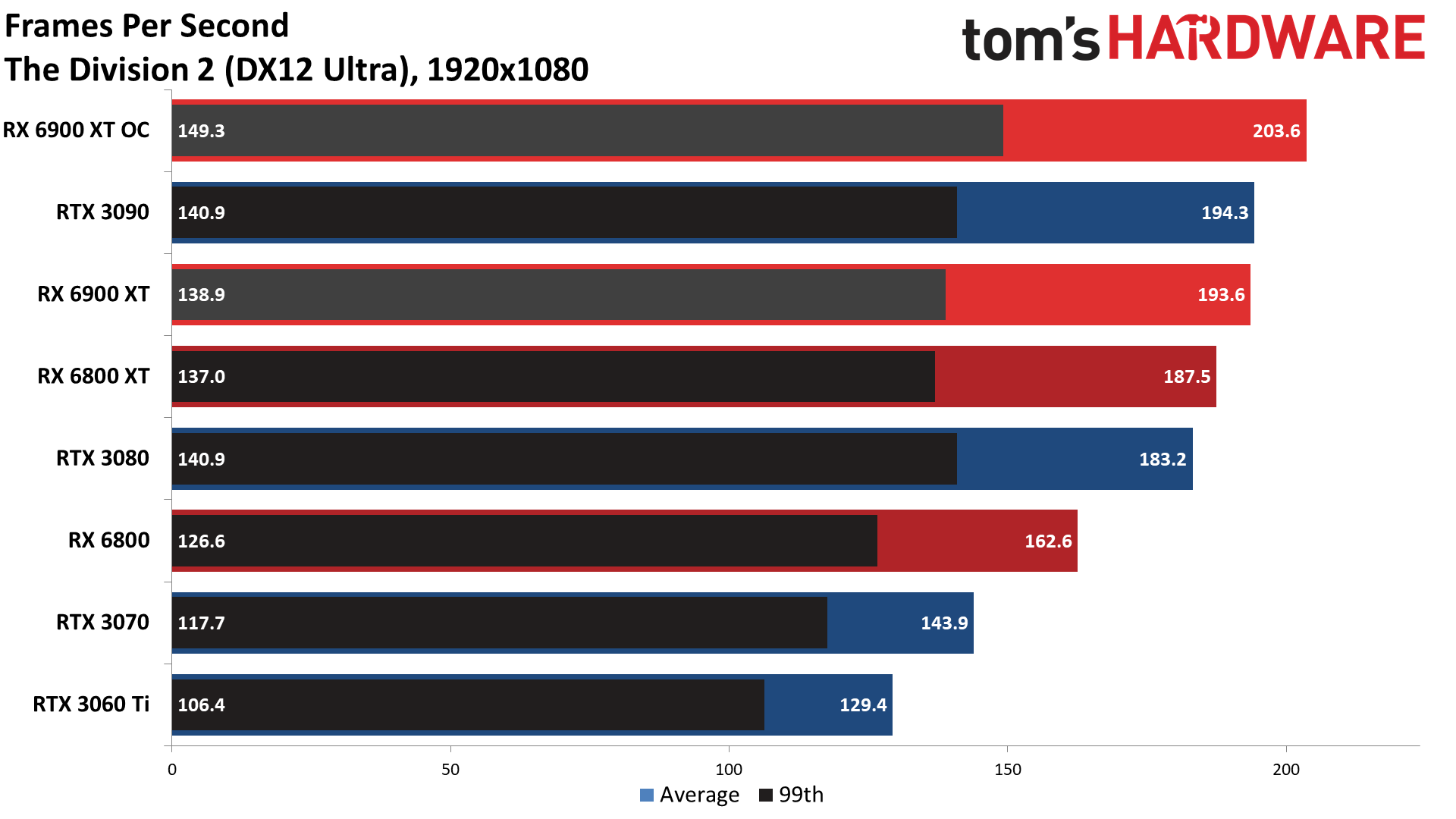

Even though this is yet another AMD promoted game, The Division 2 has been around a while and doesn't actually favor Team Red with the latest GPUs. Both the RTX 3080 and 3090 come out ahead of the 6900 XT at 4K ultra, though the gap narrows as resolution shrinks thanks to CPU bottlenecks. All of the top GPUs can do 60+ fps at 4K ultra as well, and over 120 fps at 1440p ultra.
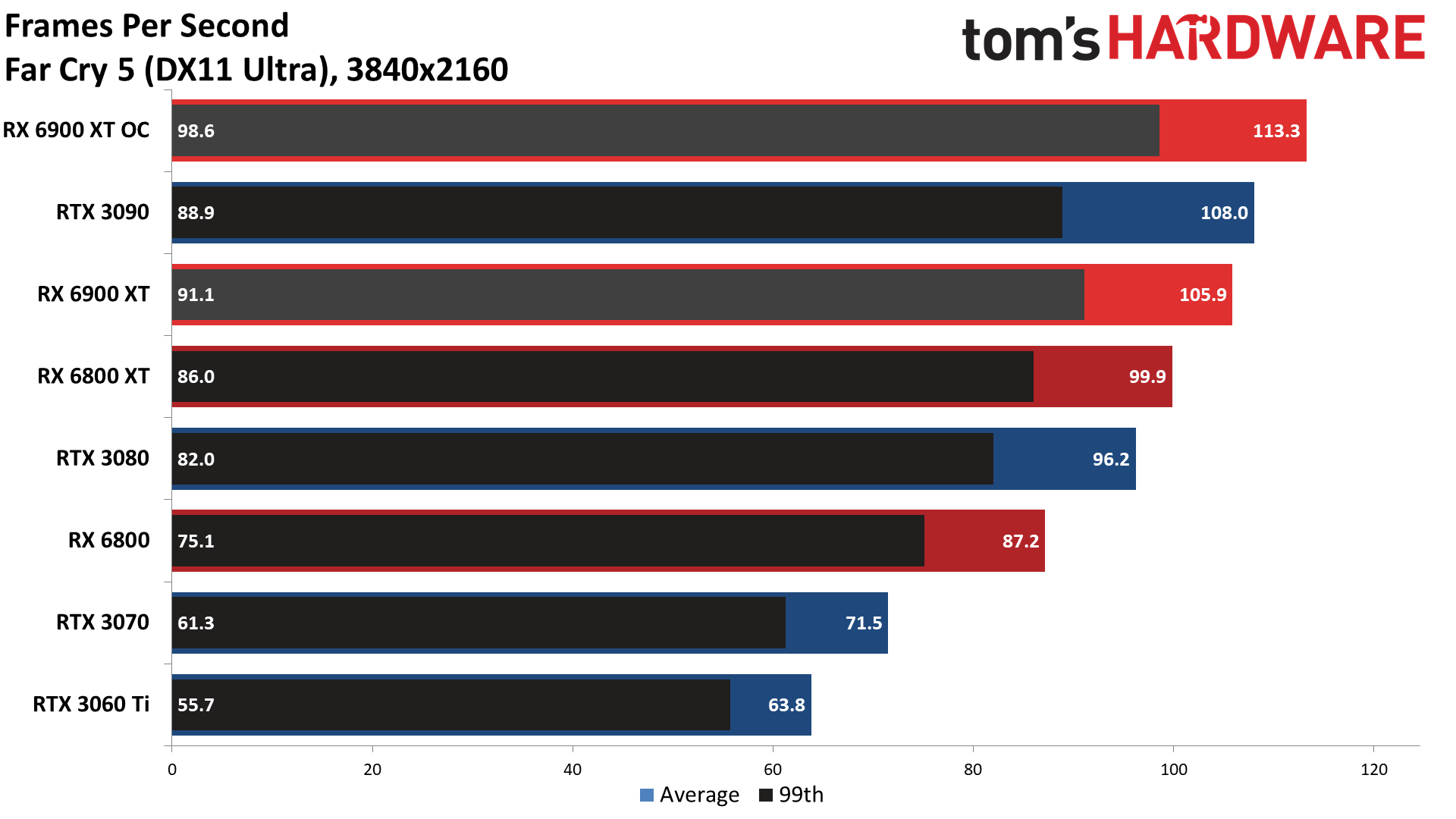
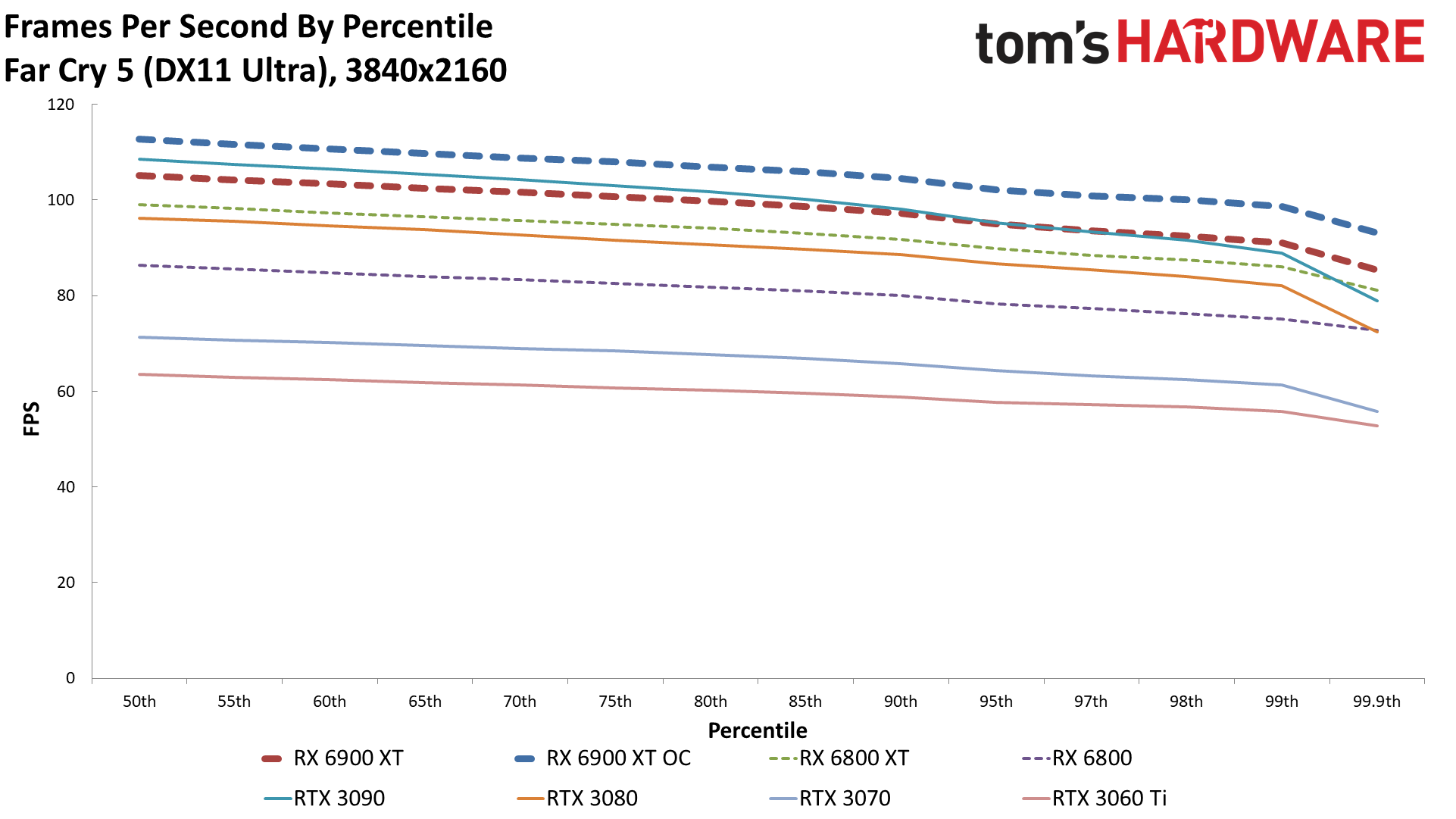
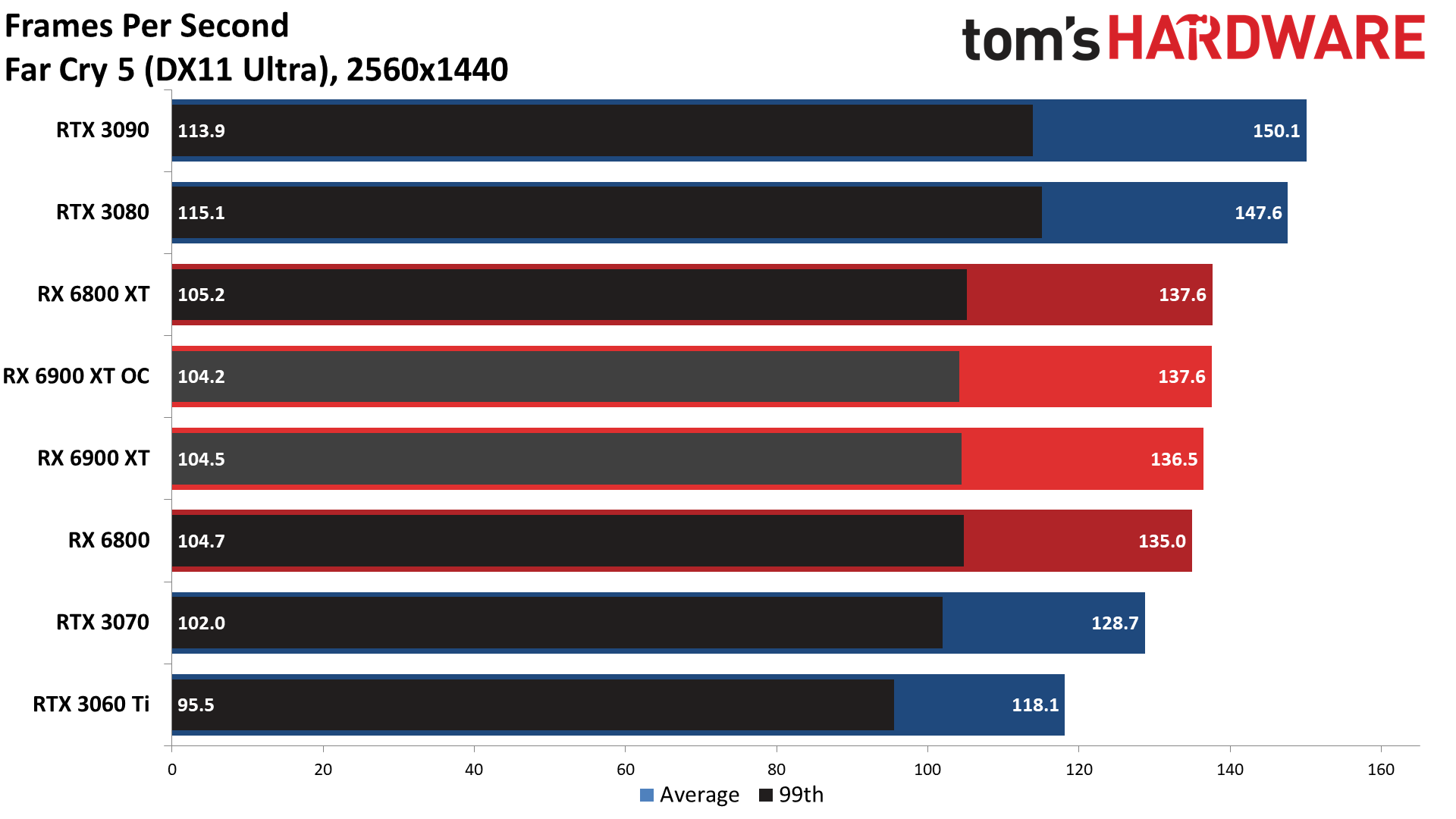
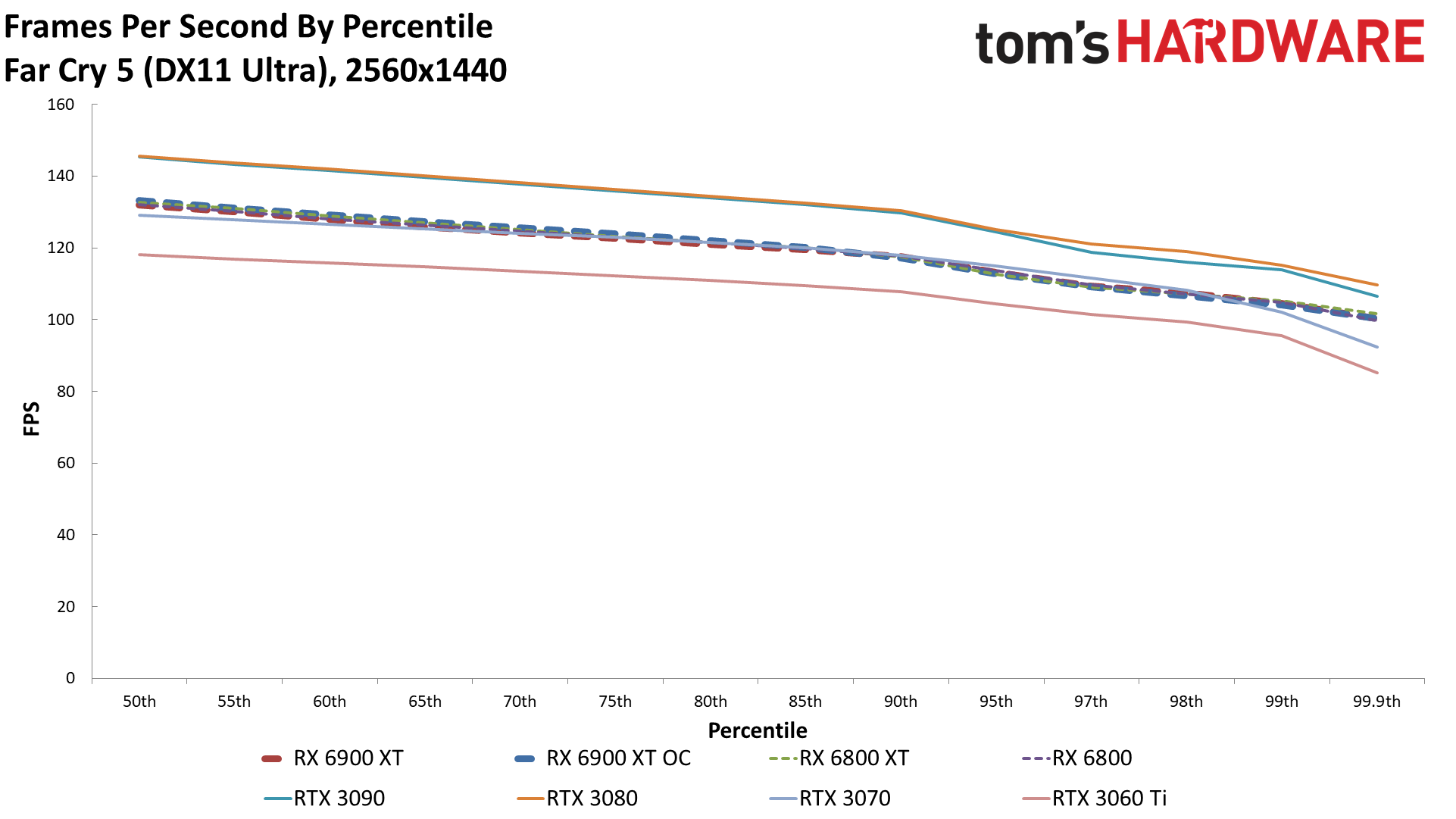
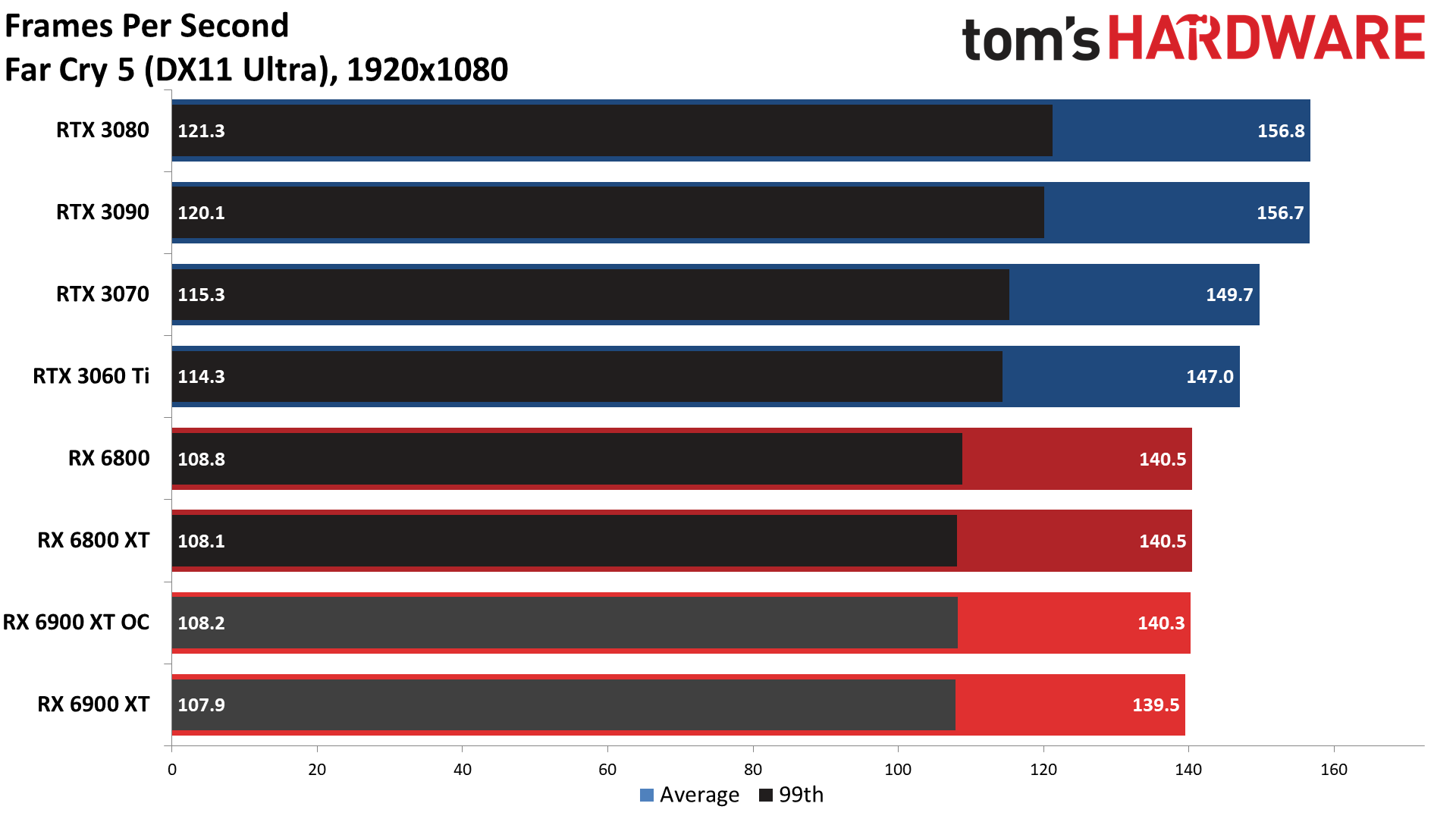
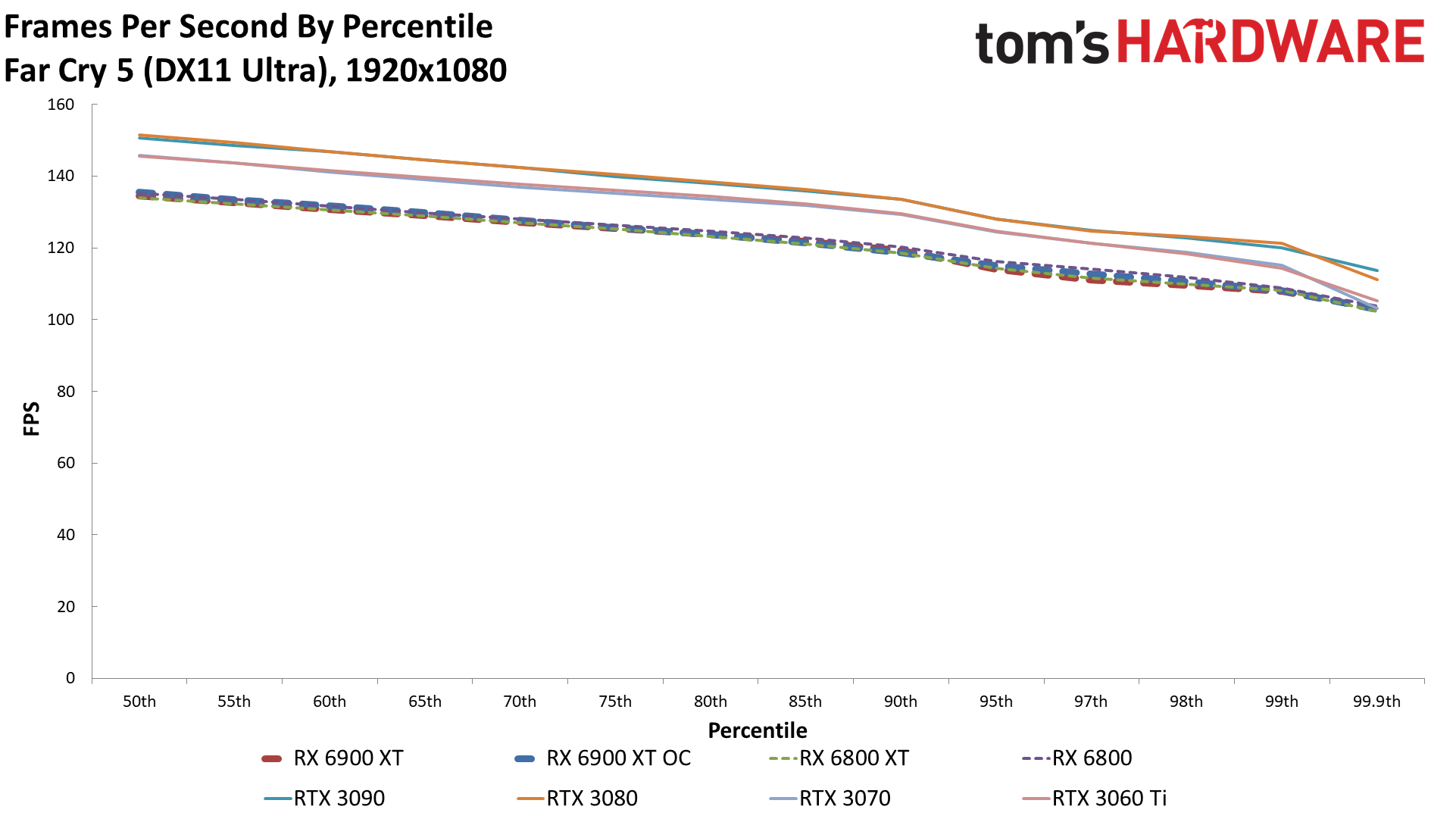
Far Cry 5 puts the 6900 XT and 6800 XT between the 3090 and 3080 at 4K, while CPU limits become a factor at 1440p and 1080p. Even though this is yet another game originally promoted by AMD, Nvidia delivers higher fps at CPU-limited resolutions right now. Given this is one of the oldest games in our test suite, we wouldn't put too much emphasis on FC5 — we'll be looking at replacing it with Far Cry 6 when it comes out.
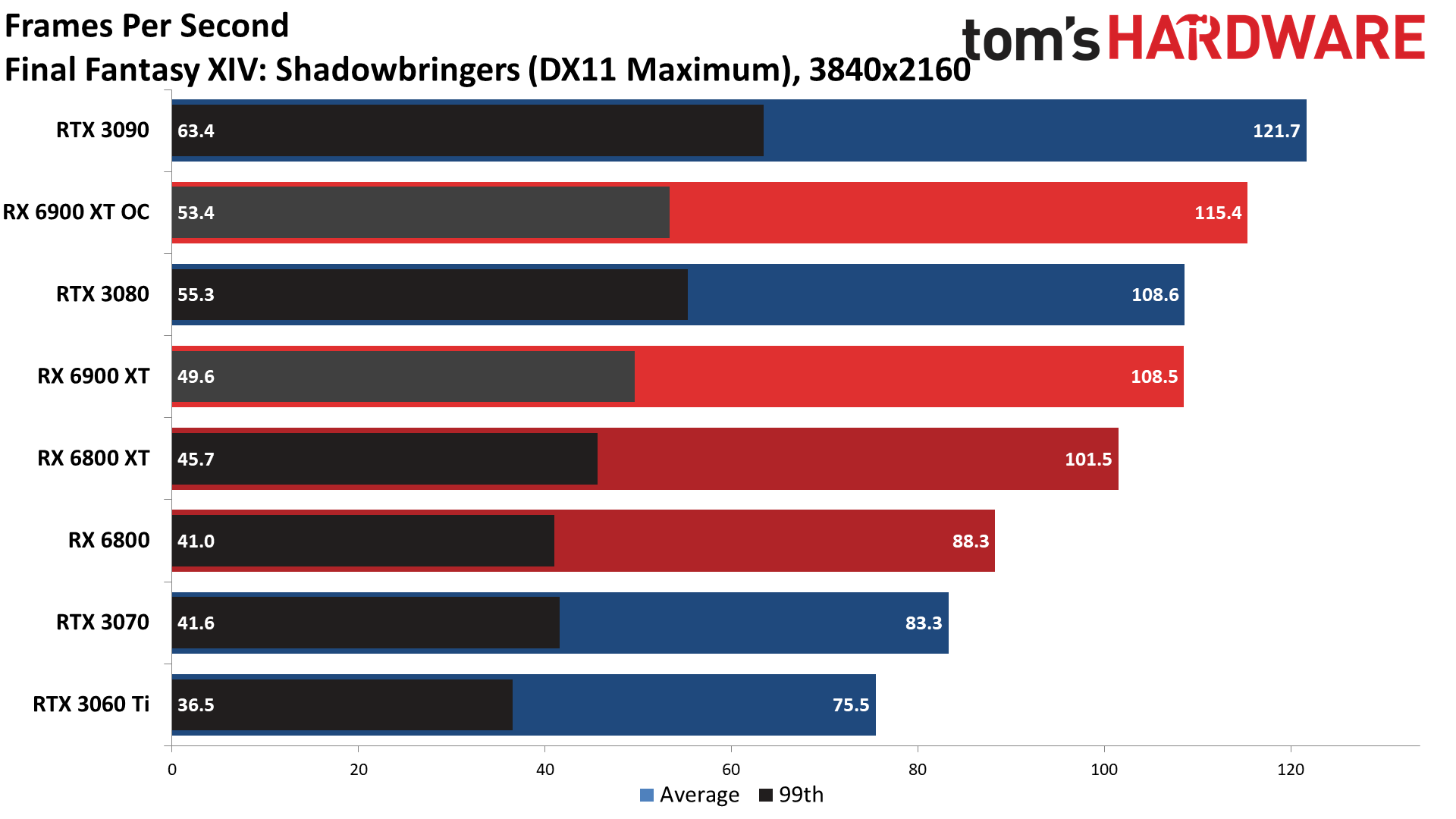
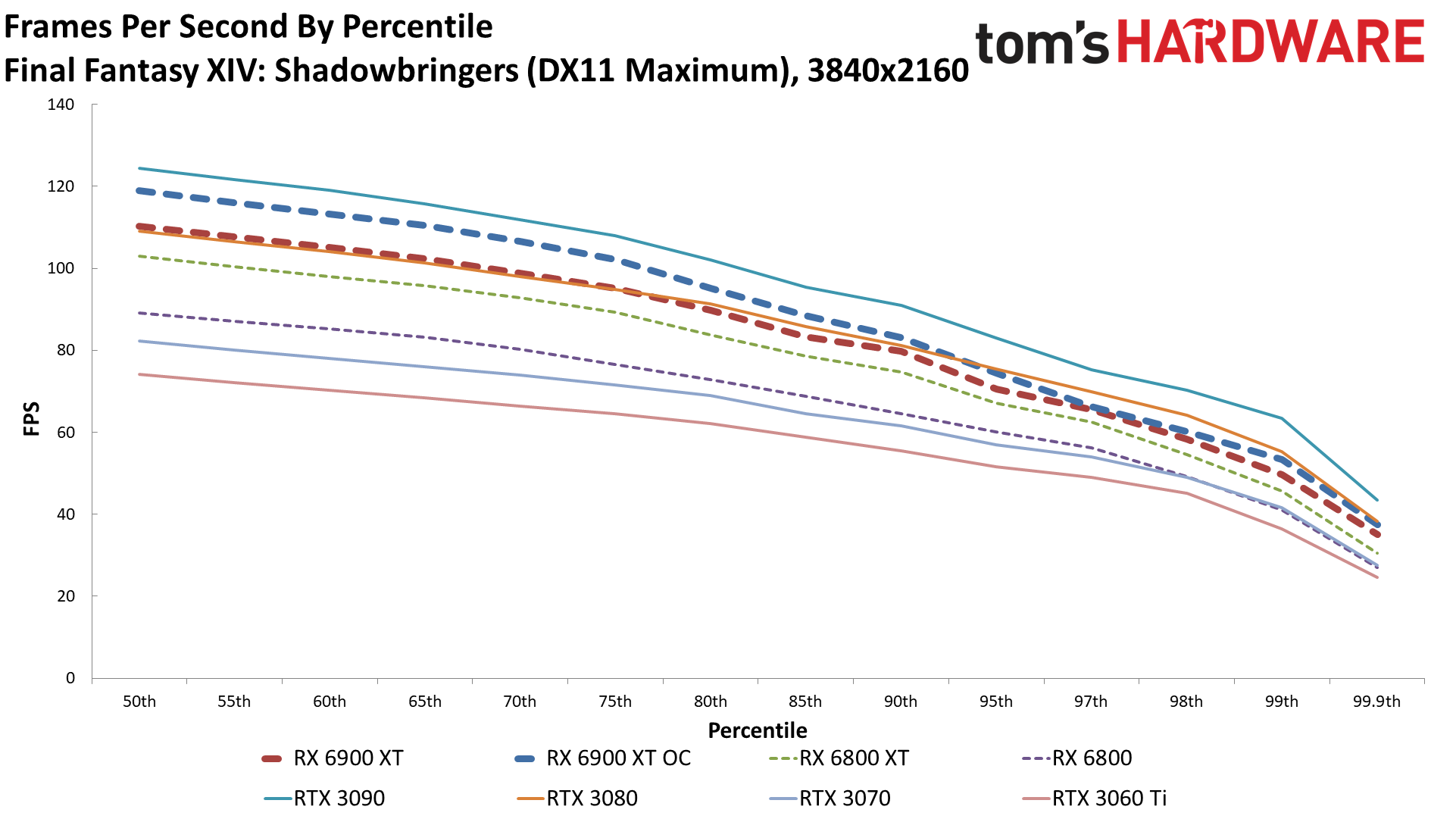
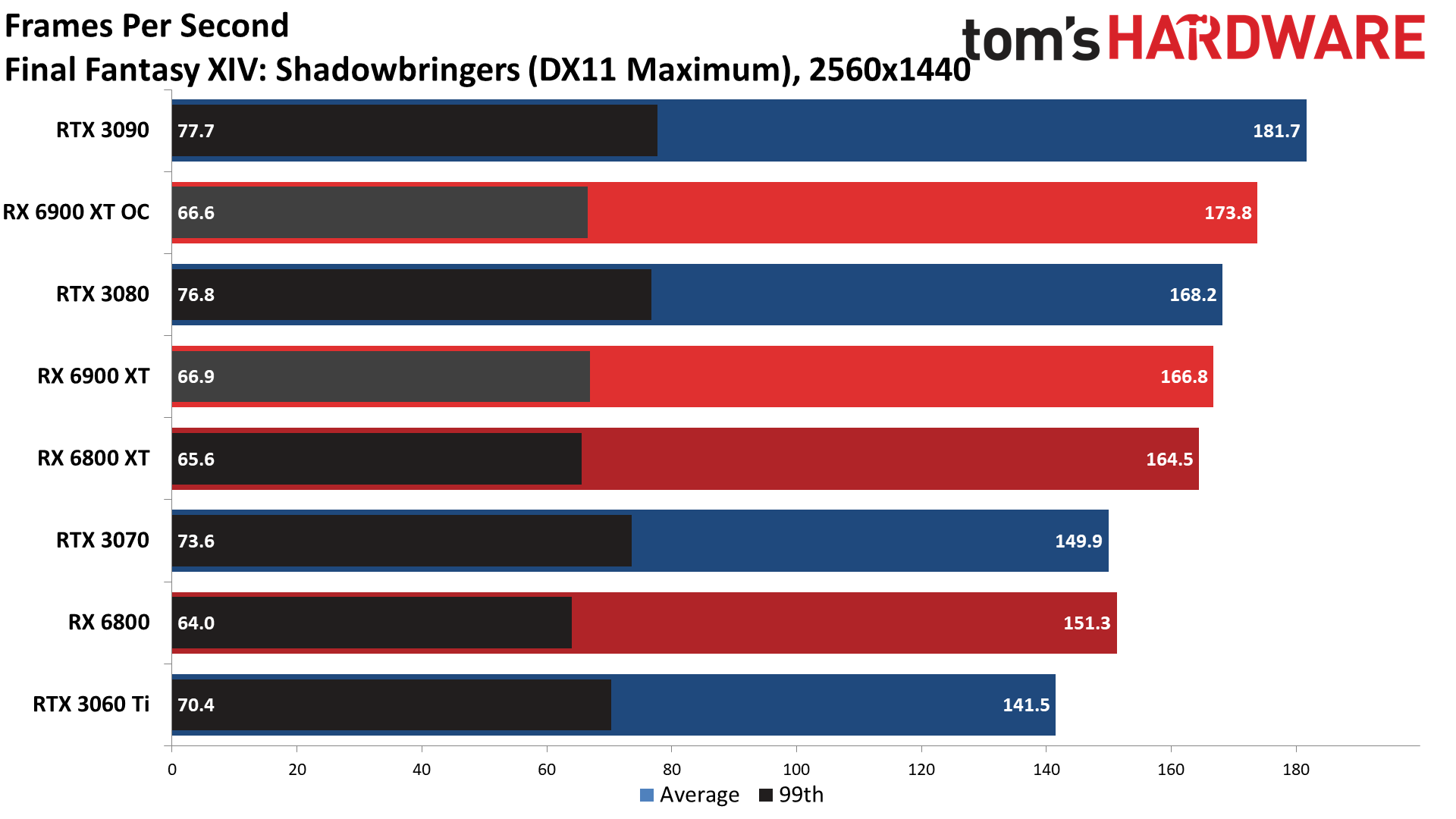
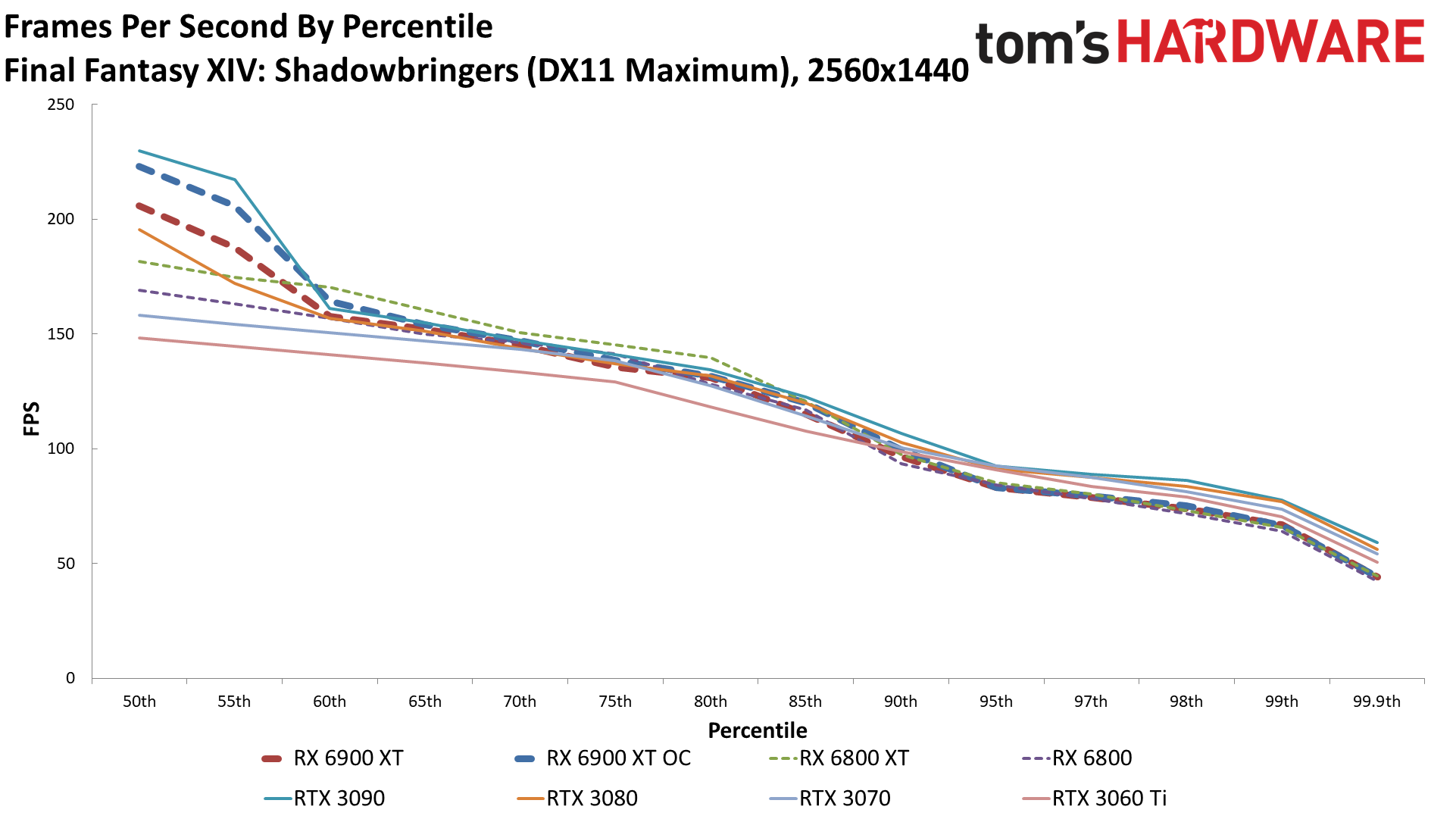
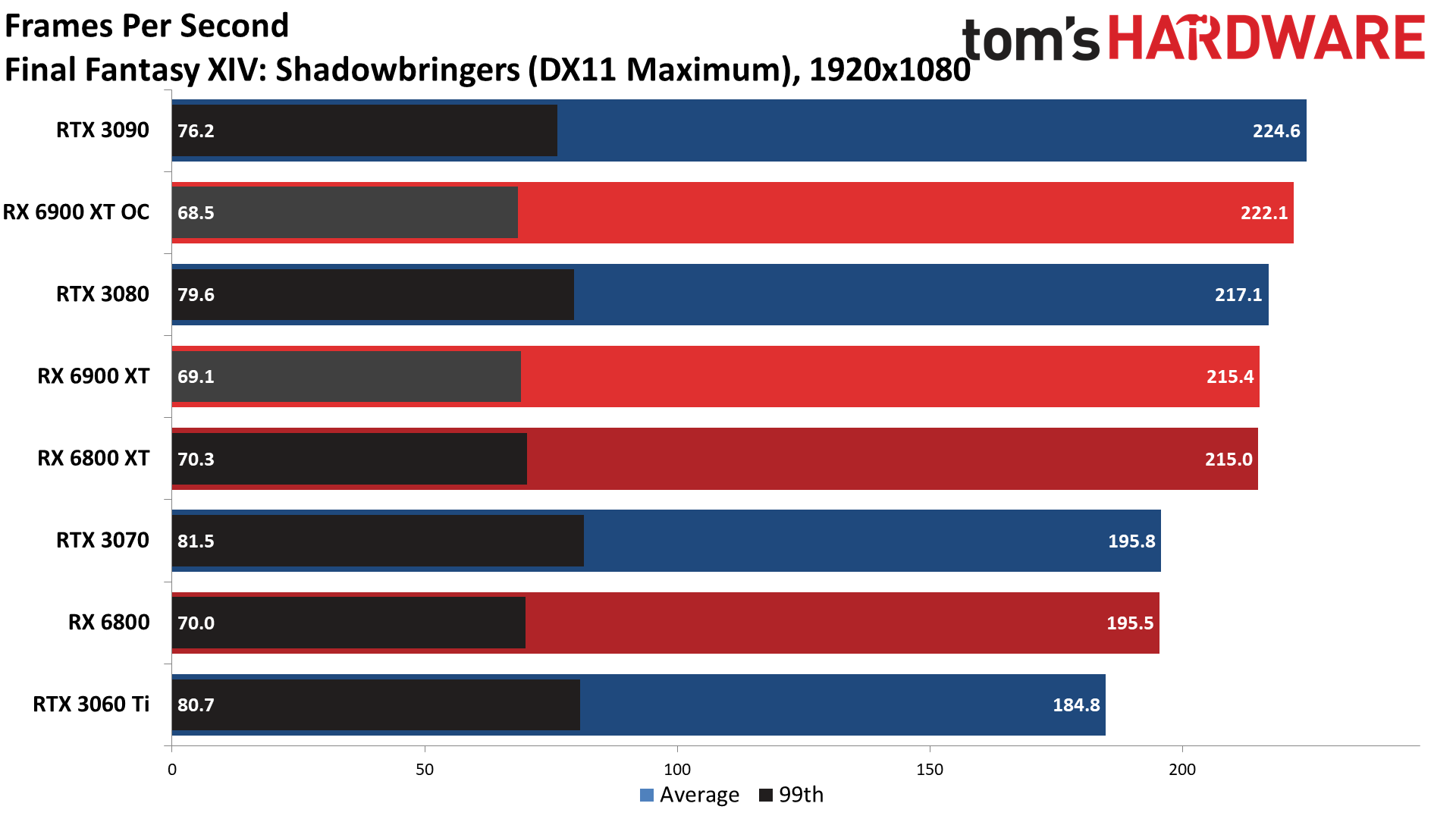
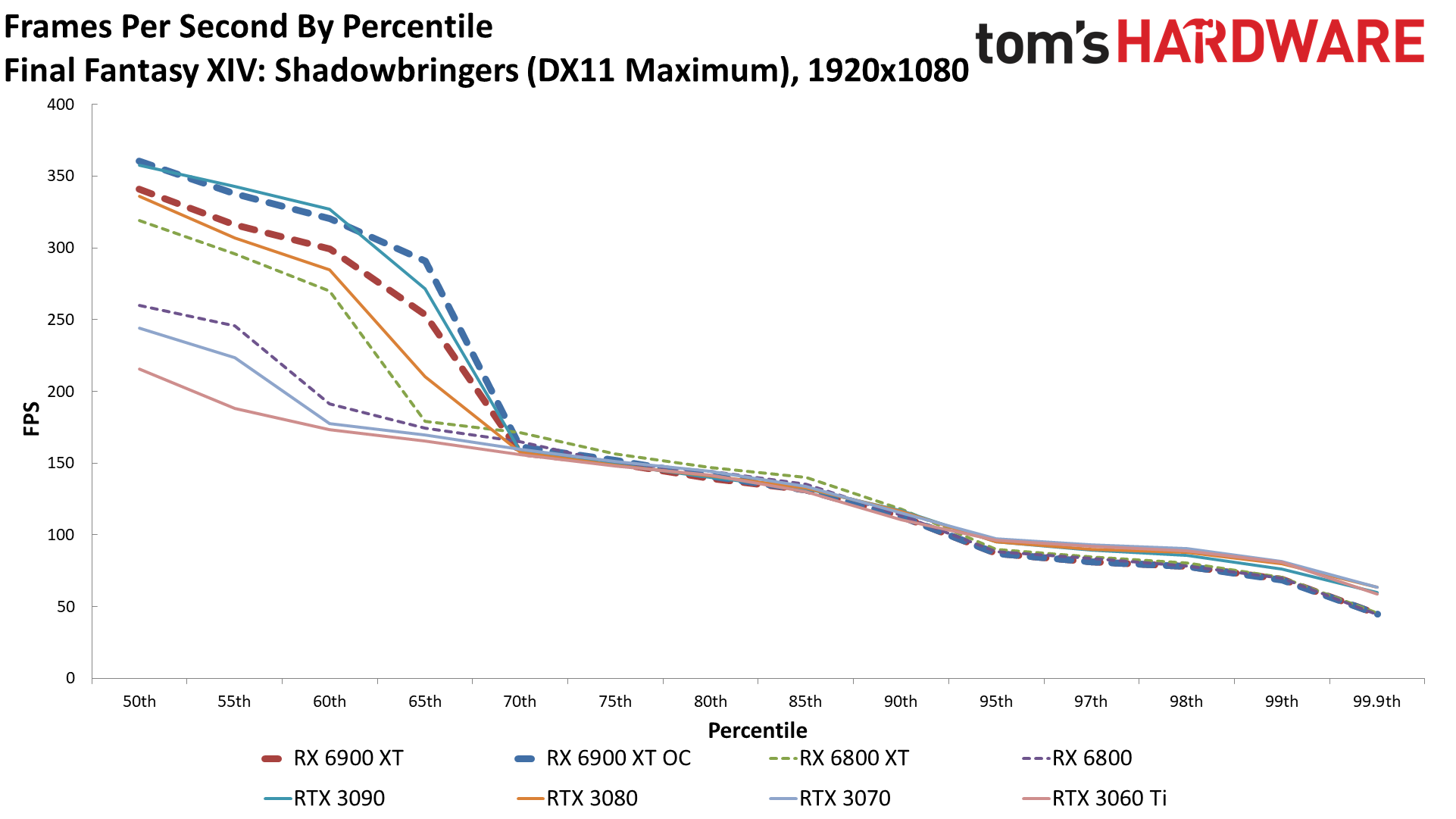
Final Fantasy XIV is our first Nvidia promoted game, or at least a game that specifically makes use of some Nvidia GameWorks libraries. Nvidia's 3090 and 3080 take the top two spots across all three resolutions, though the biggest lead is still only 12 percent at 4K. With 4K fps in the triple digits and 1440p easily breaking 144 fps on the RX 6800 and above, this is another game that's not very representative of the latest releases.
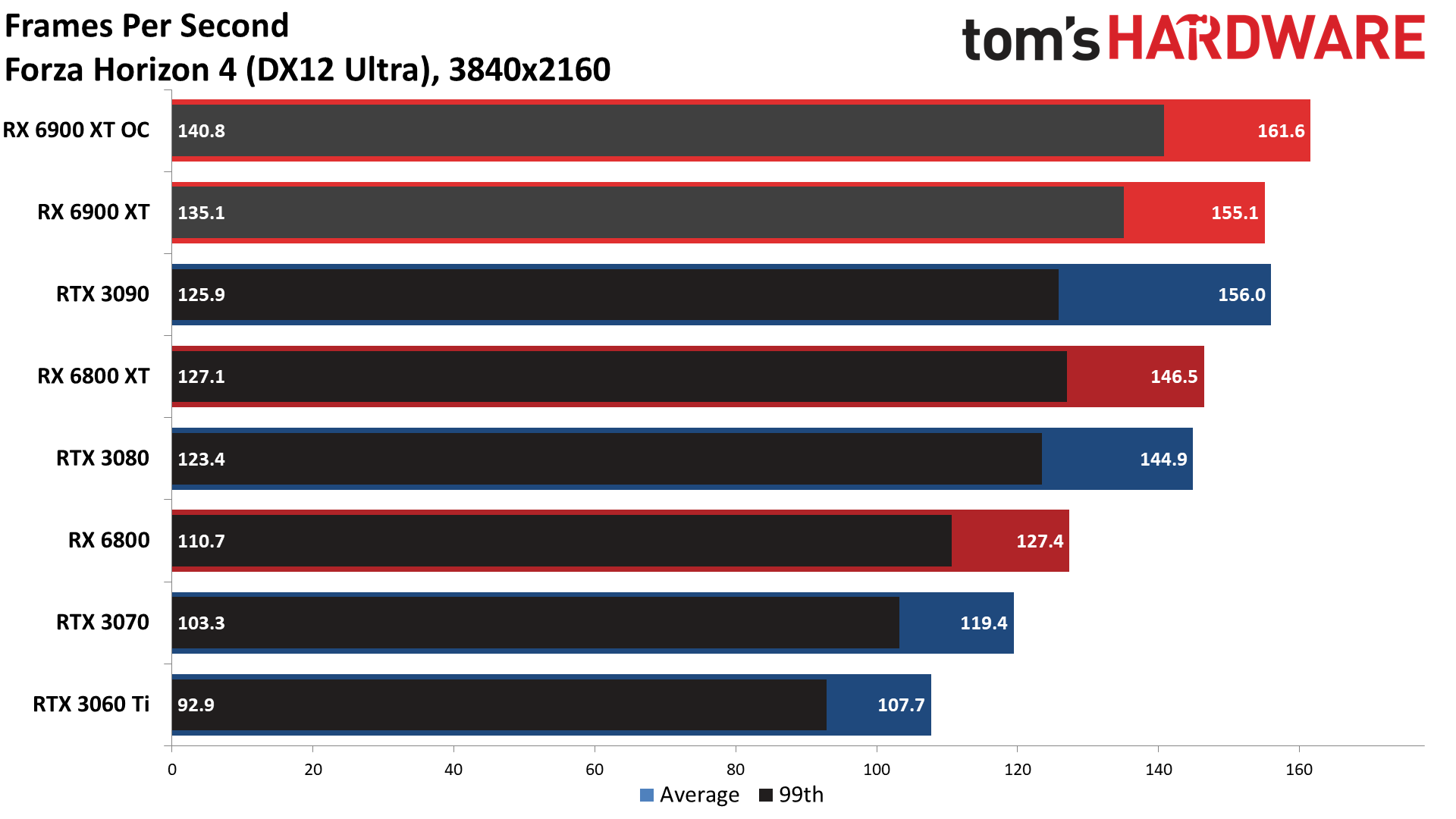
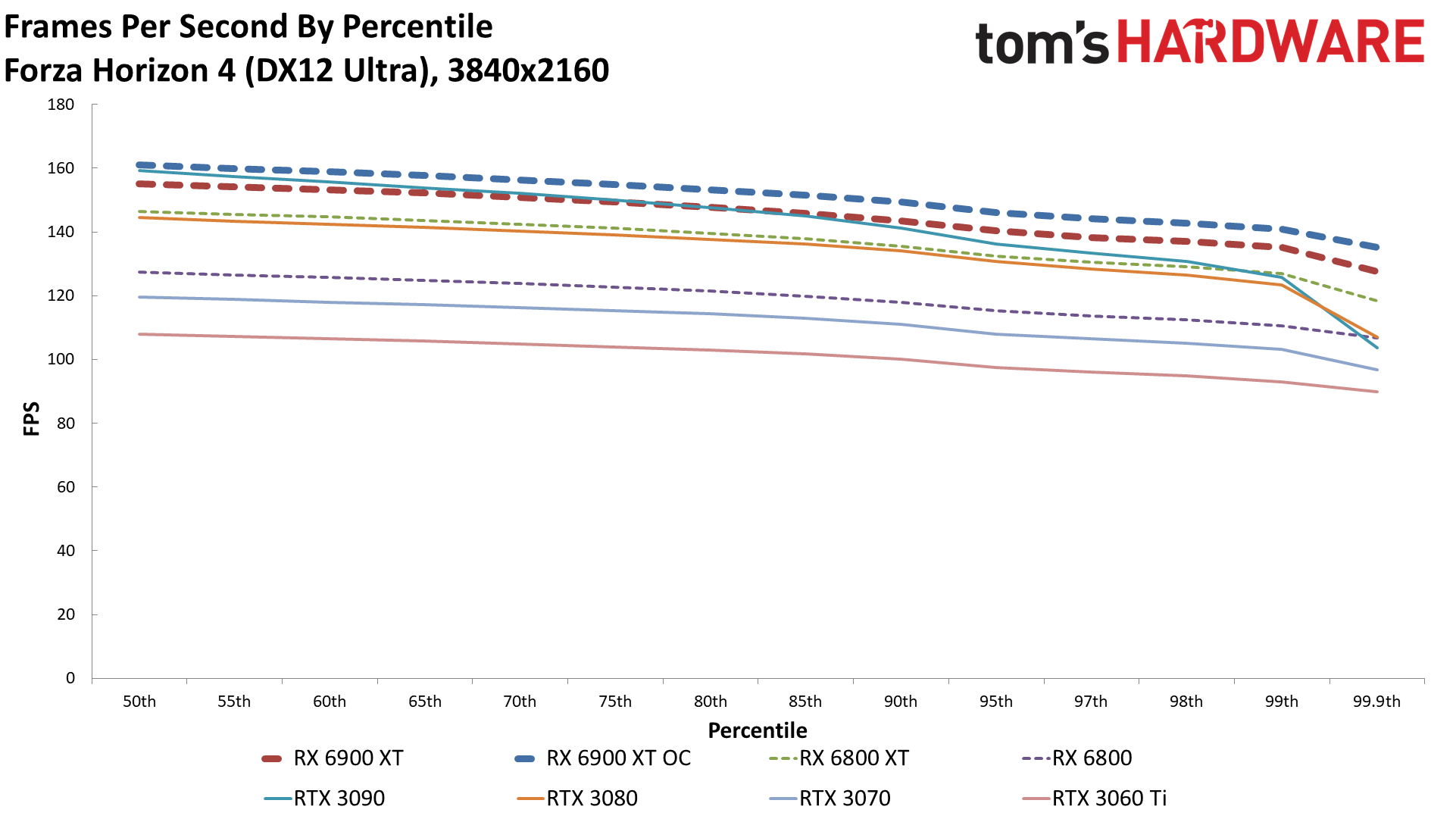
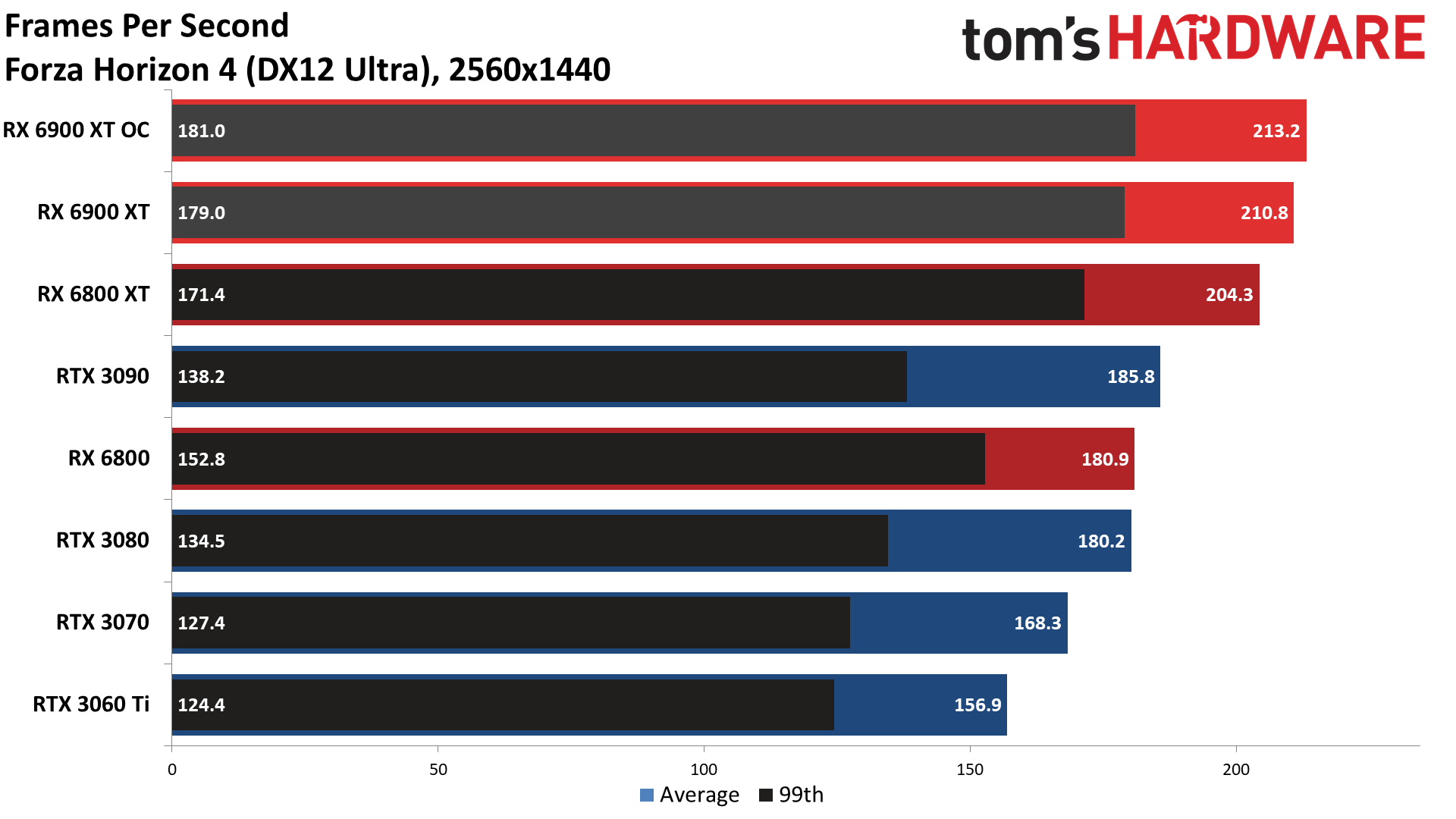
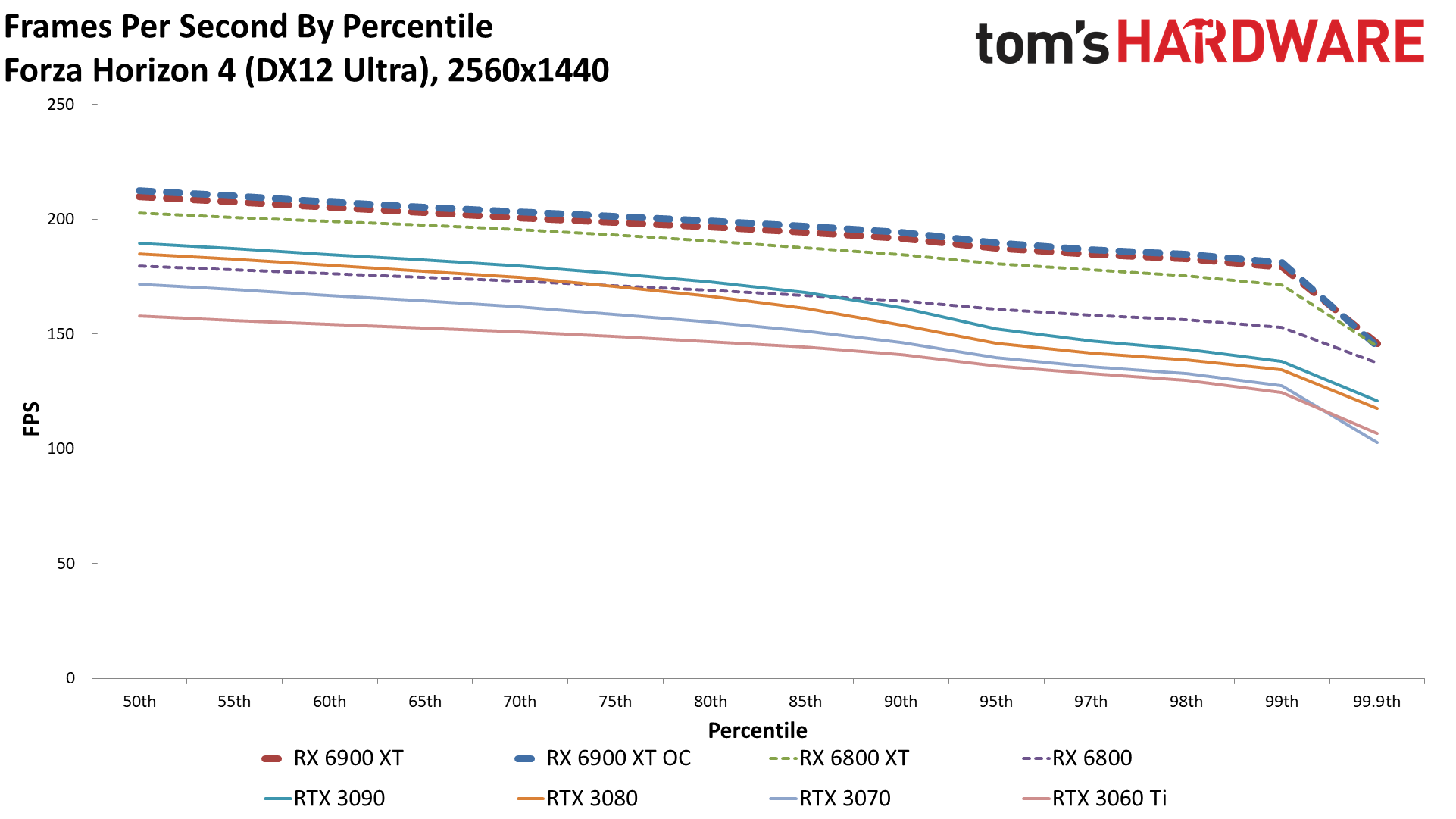
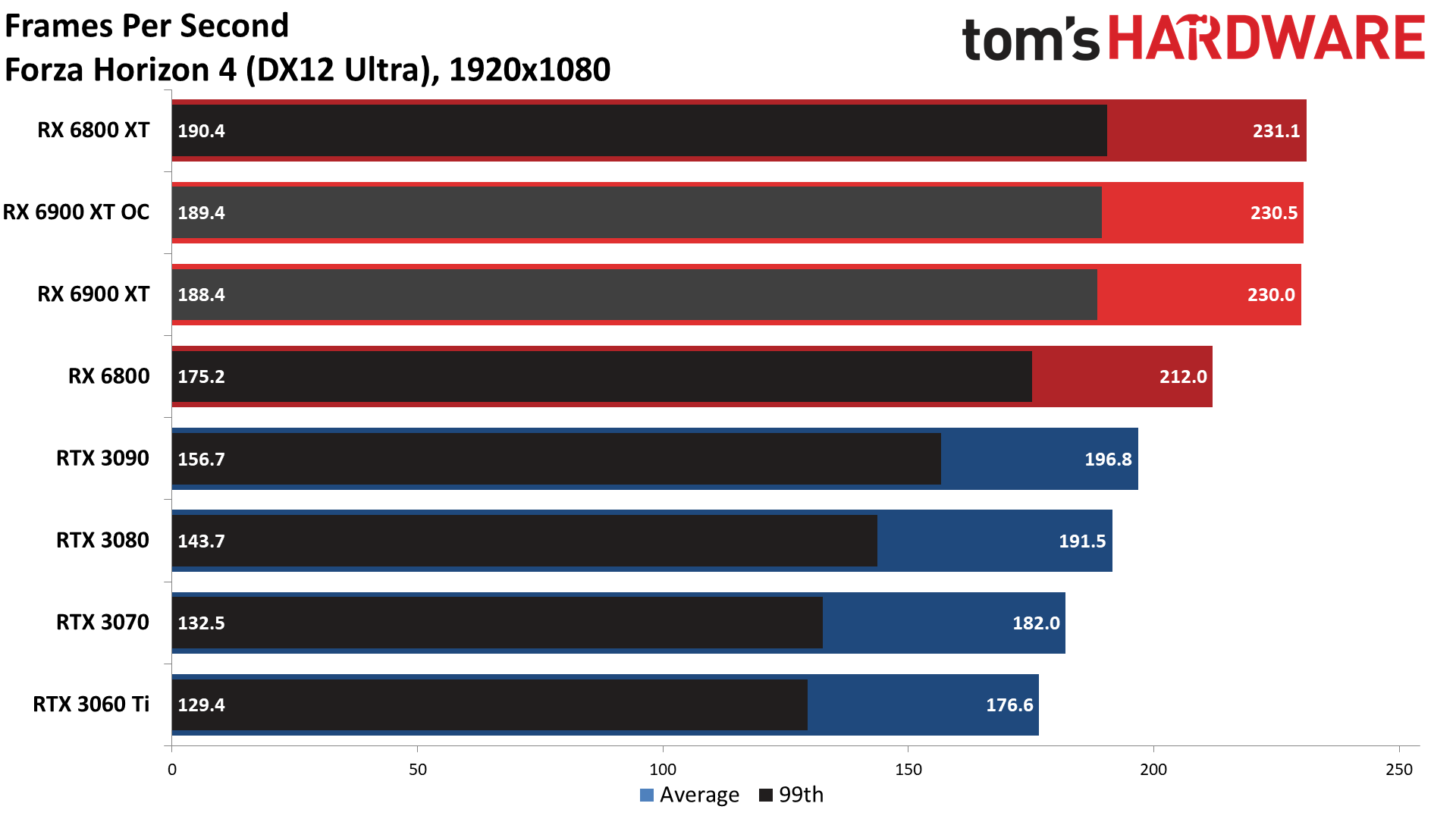
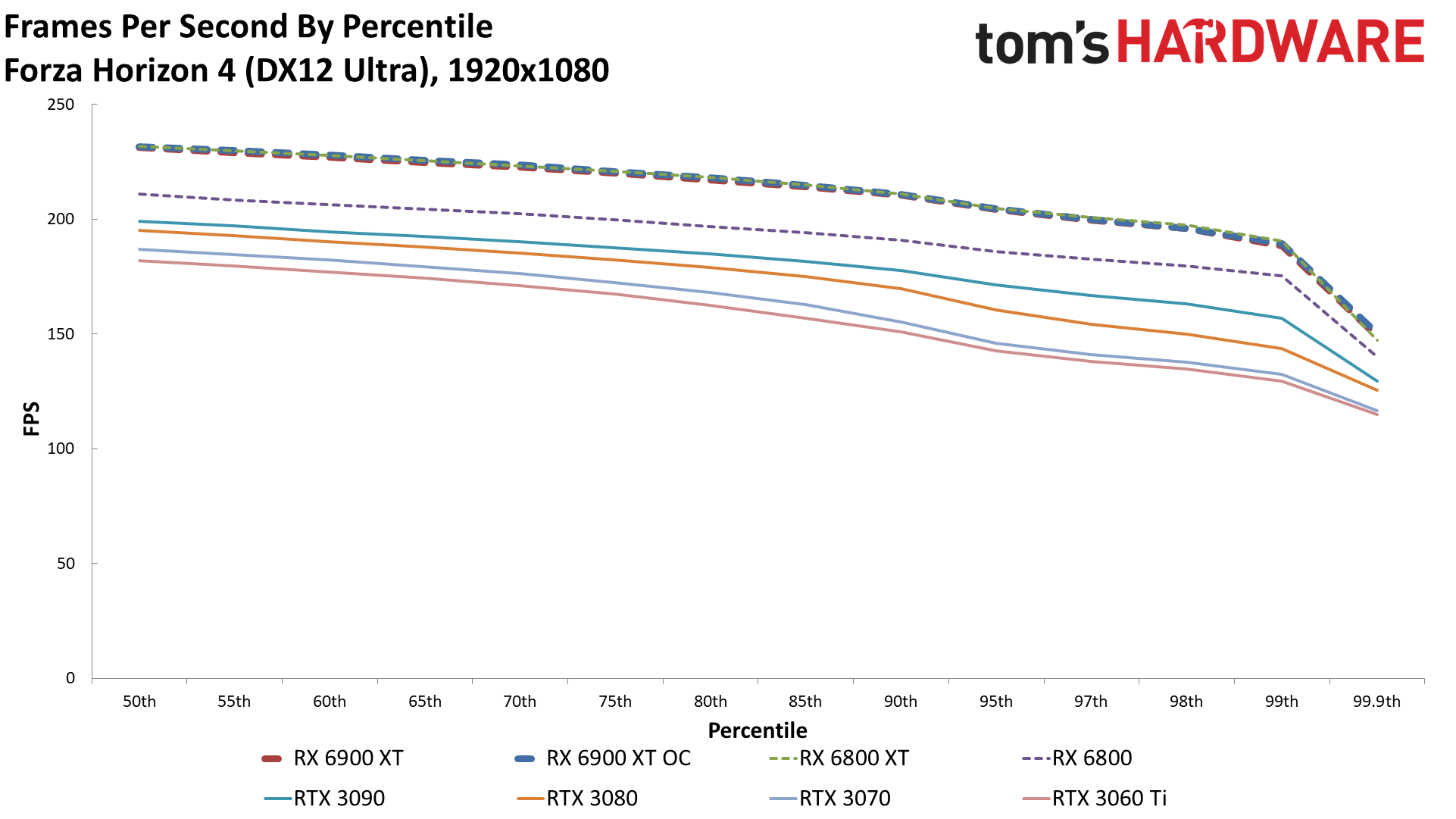
Forza Horizon 4 wasn't promoted by AMD, but it definitely favors AMD GPUs. At 4K ultra, the 3090 technically has a higher average fps, but the minimum fps on the AMD side has enough weight to give AMD the lead. Dropping to 1440p, both the 6900 XT and 6800 XT lead the top Nvidia cards, again with significantly higher minimum fps, and at 1080p, even the RX 6800 tops the RTX 3090. This definitely isn't one of the better showings for the green team.

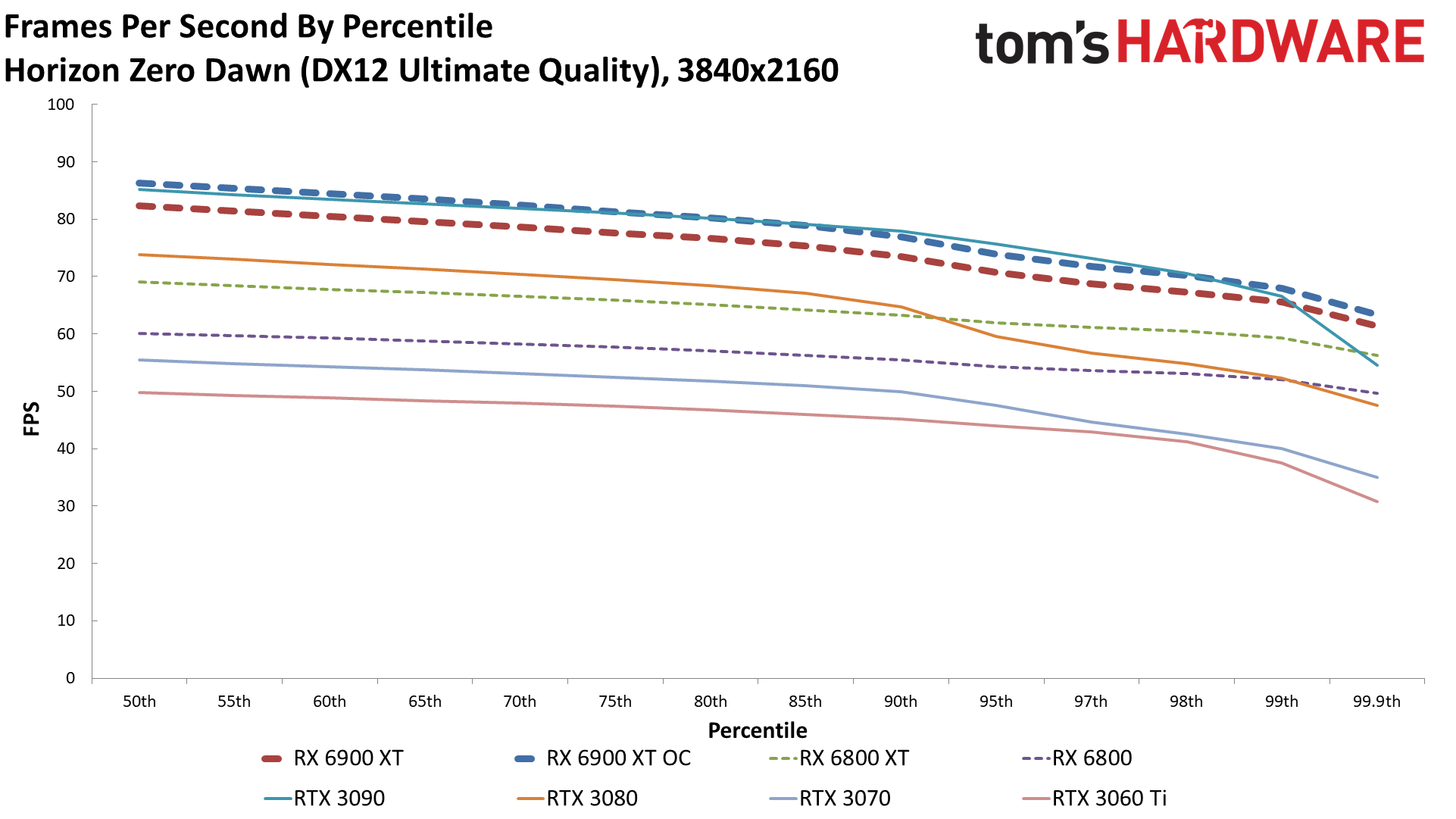
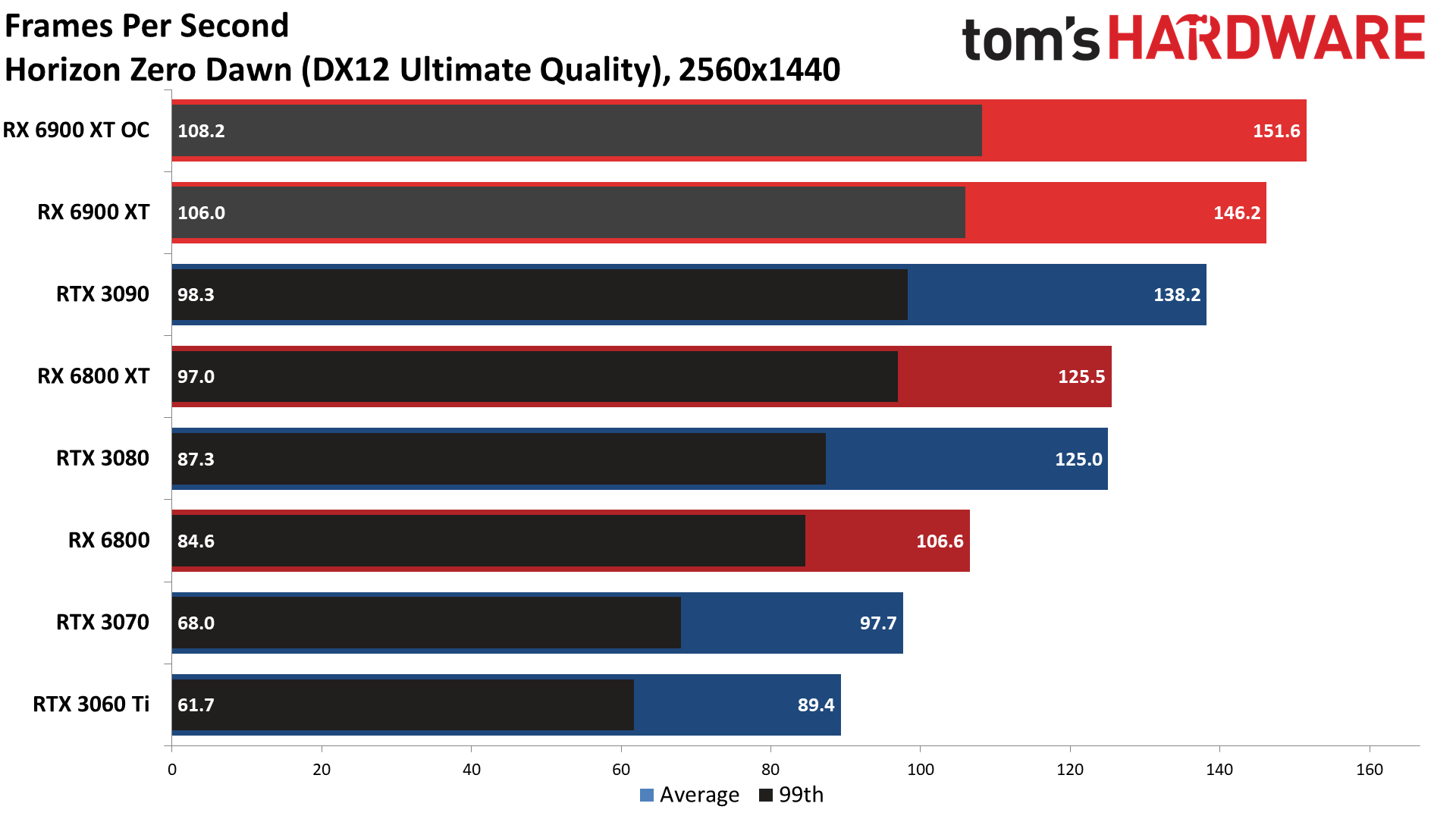
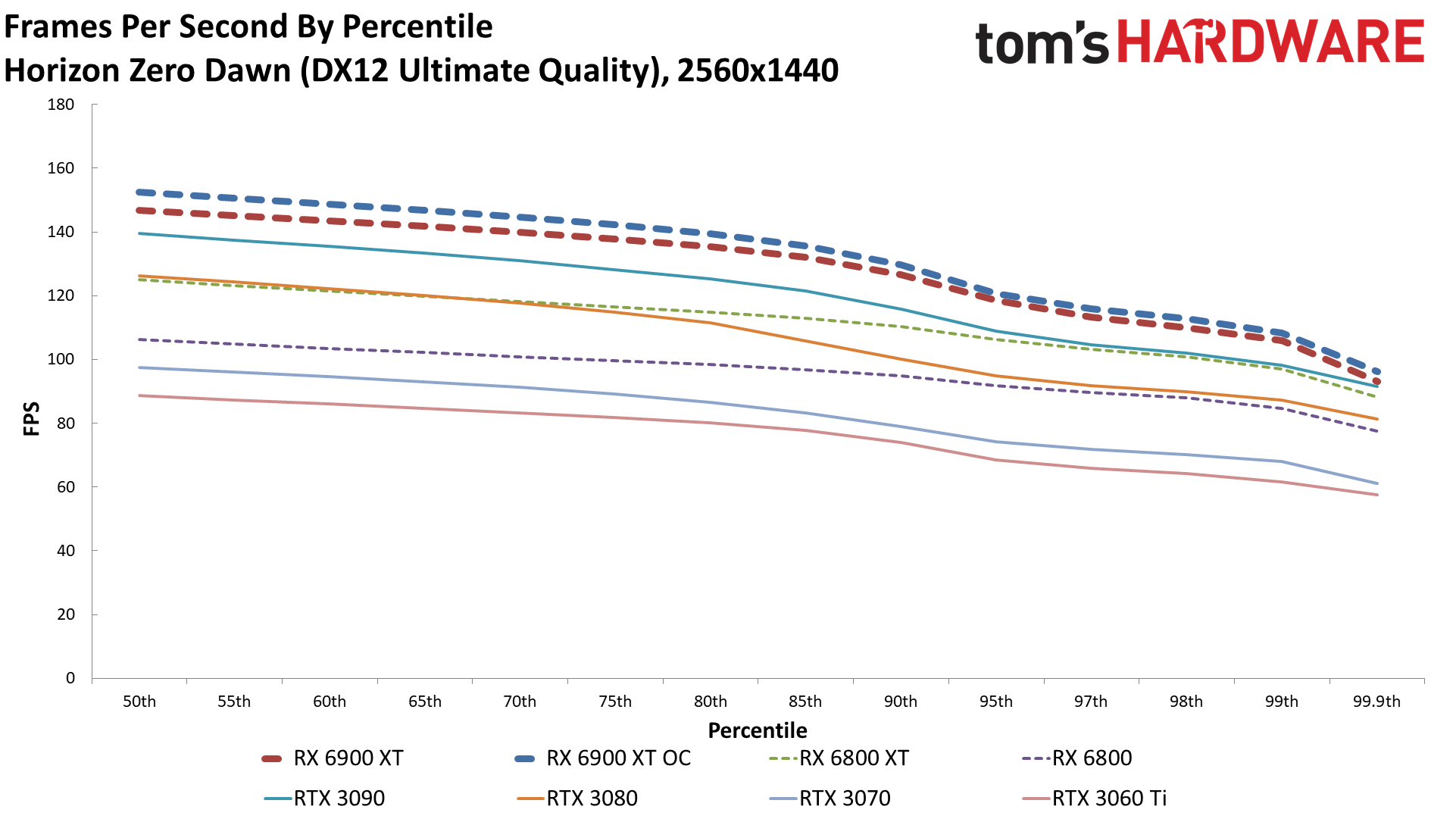
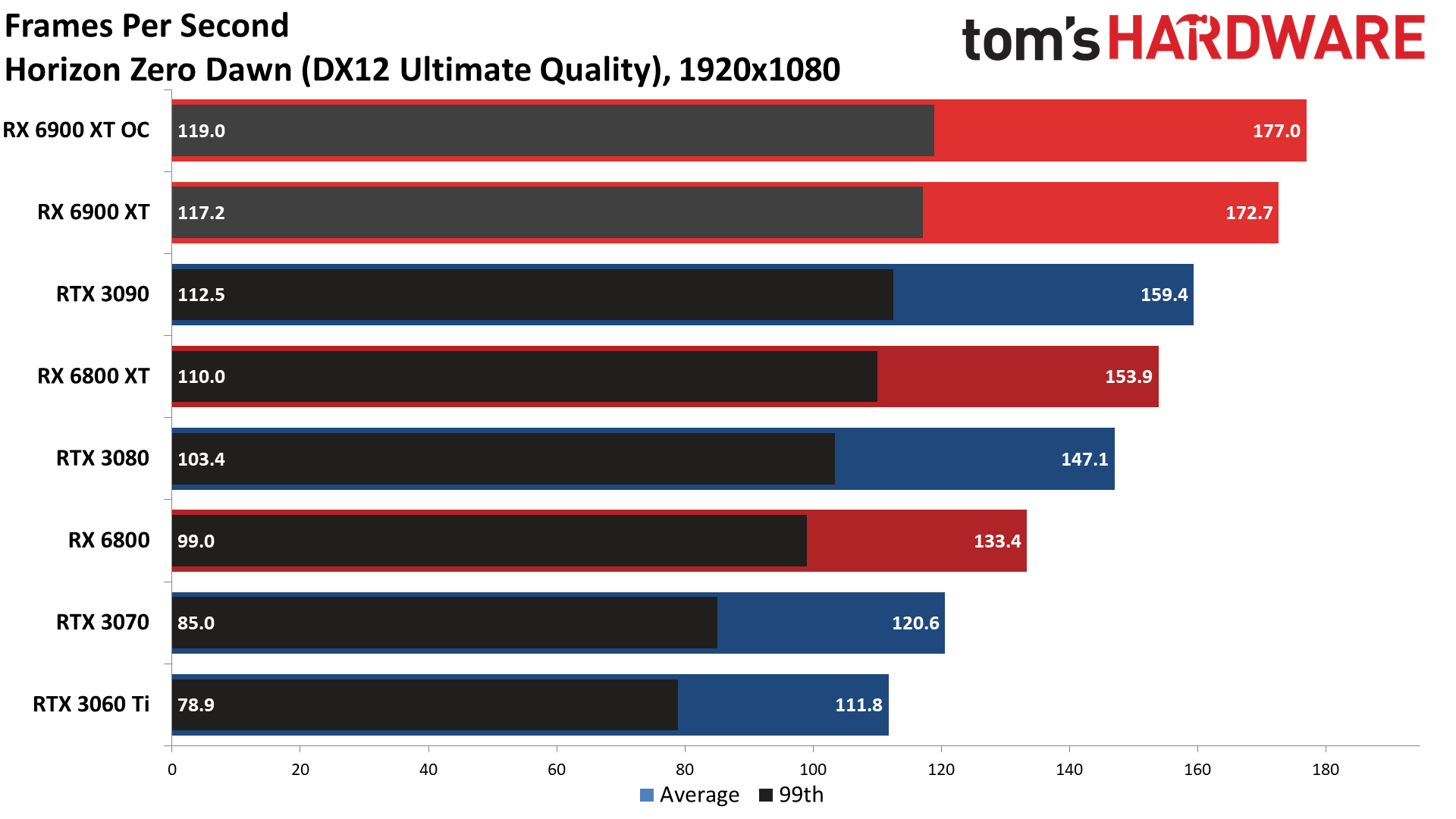
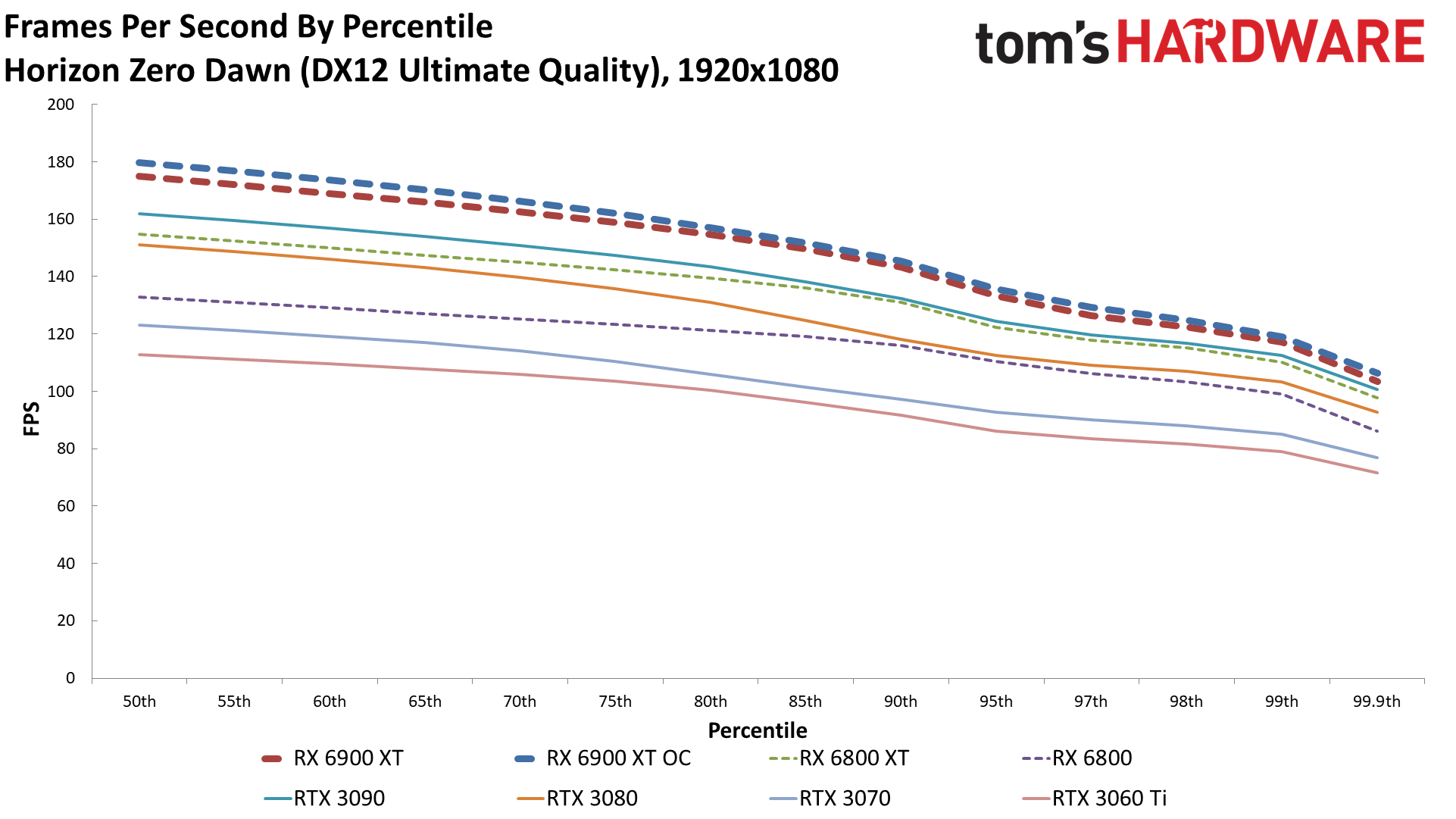
Horizon Zero Dawn is a port from PS4, so potentially the console roots help AMD a bit, plus it's a DX12 engine (the same game engine as Death Stranding). Performance is mostly a tie at 4K, but the 6900 XT pulls away at 1440p and 1080p. This is also the one game where the latest AMD drivers seem to have given RDNA2 a shot in the arm. We didn't get a chance to retest the 6800 XT, but right now, the 6900 XT is nearly 20 percent faster at 4K, and that's far more than the extra shader cores should provide.
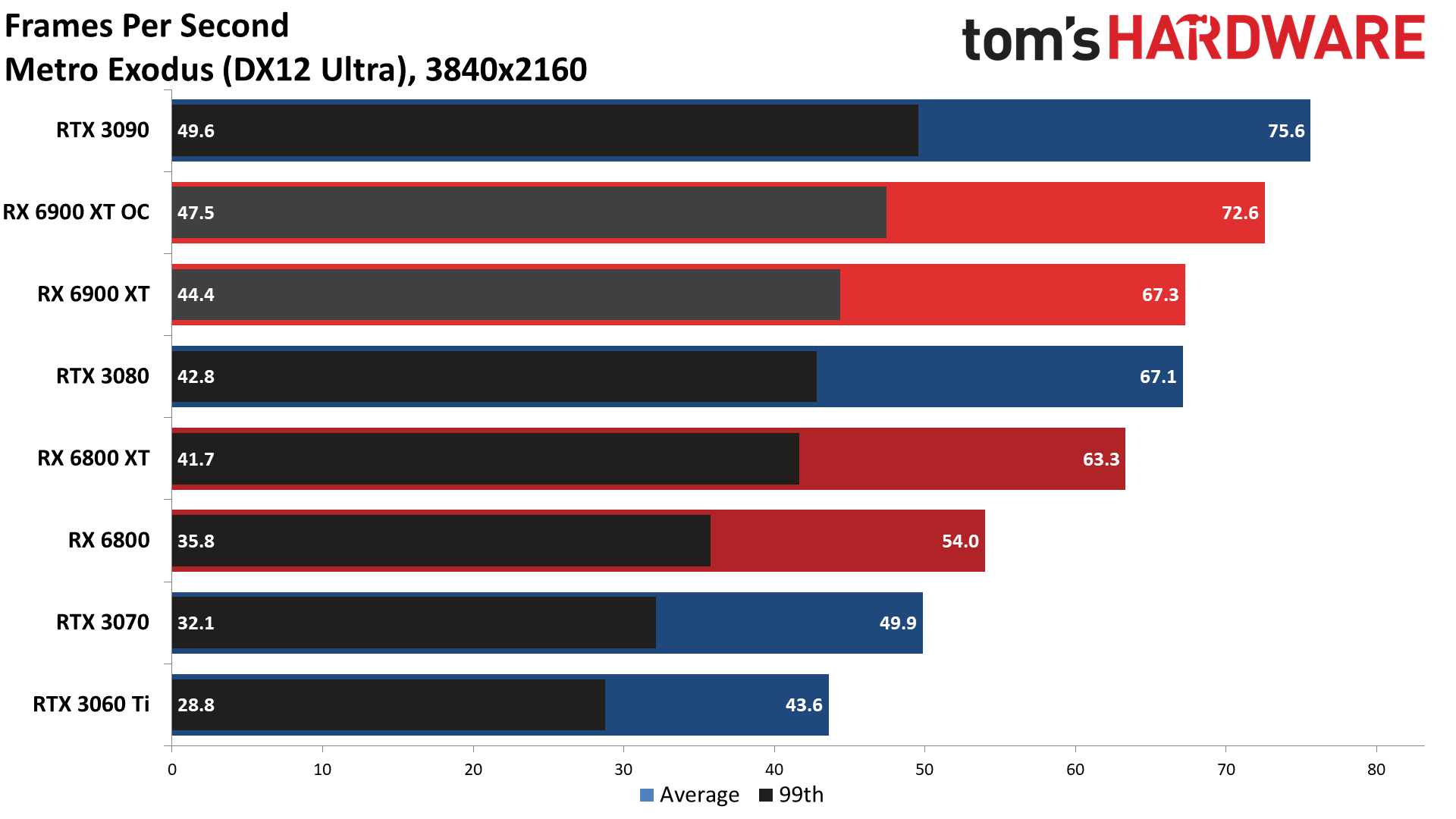
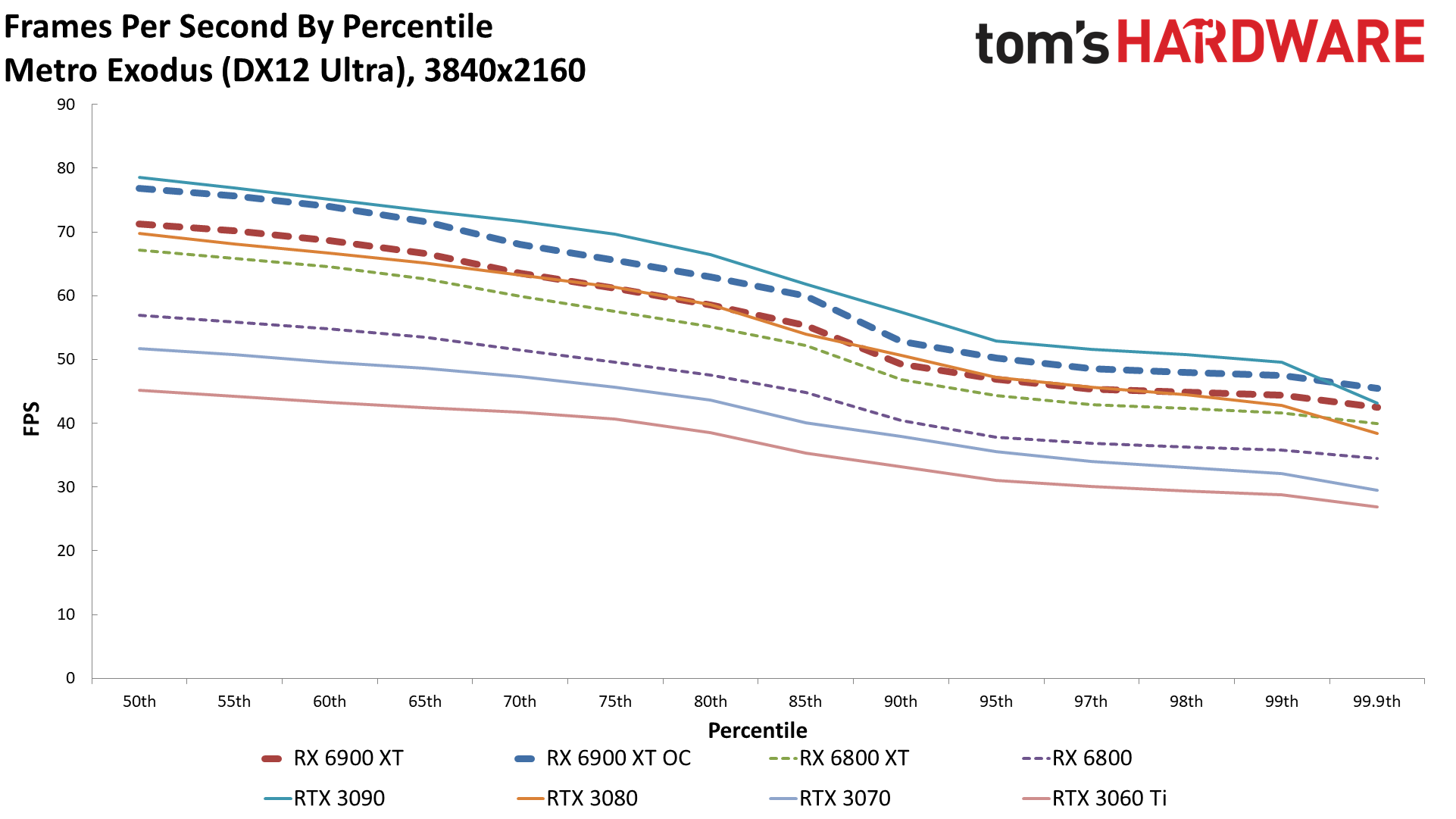
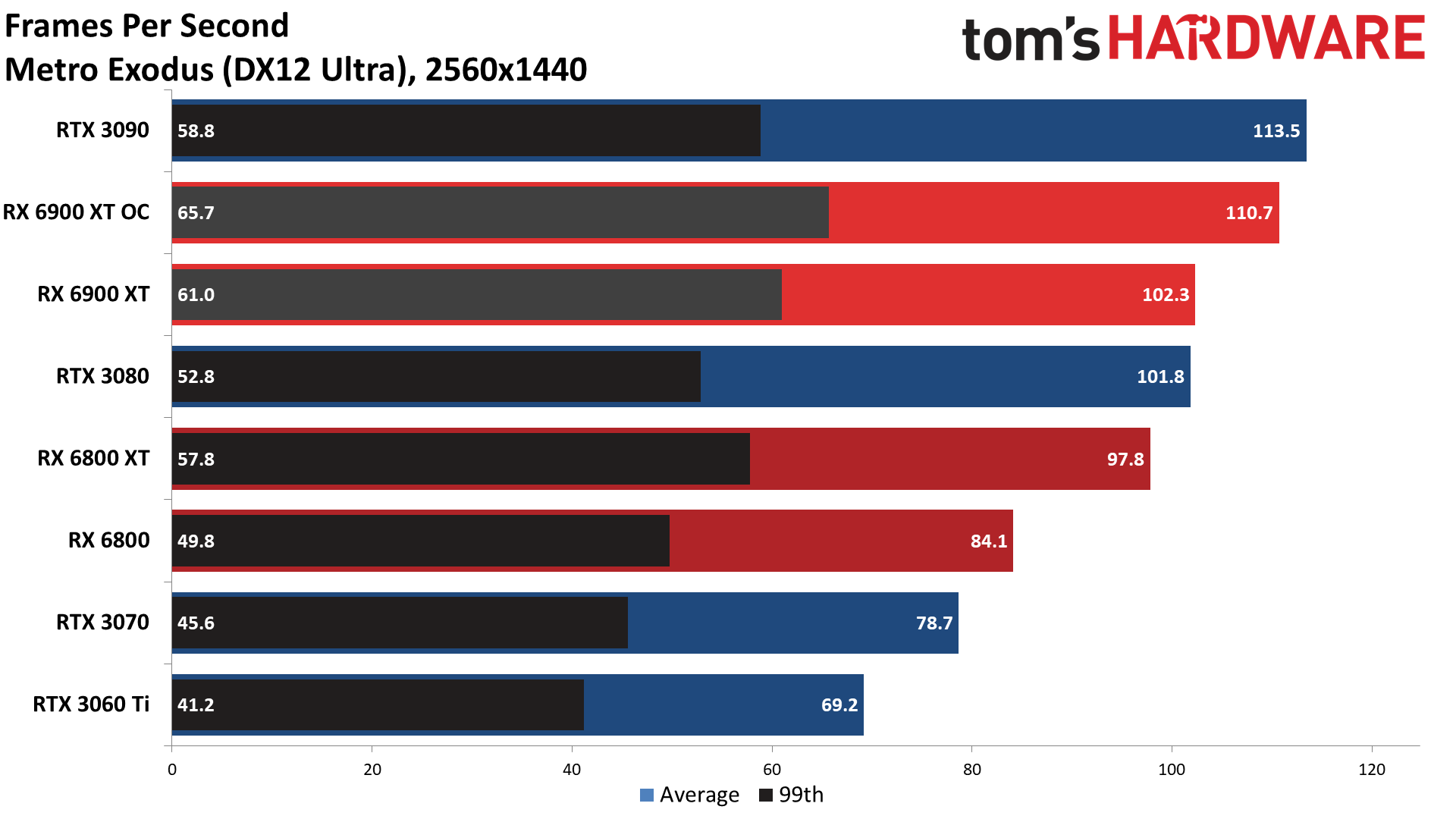
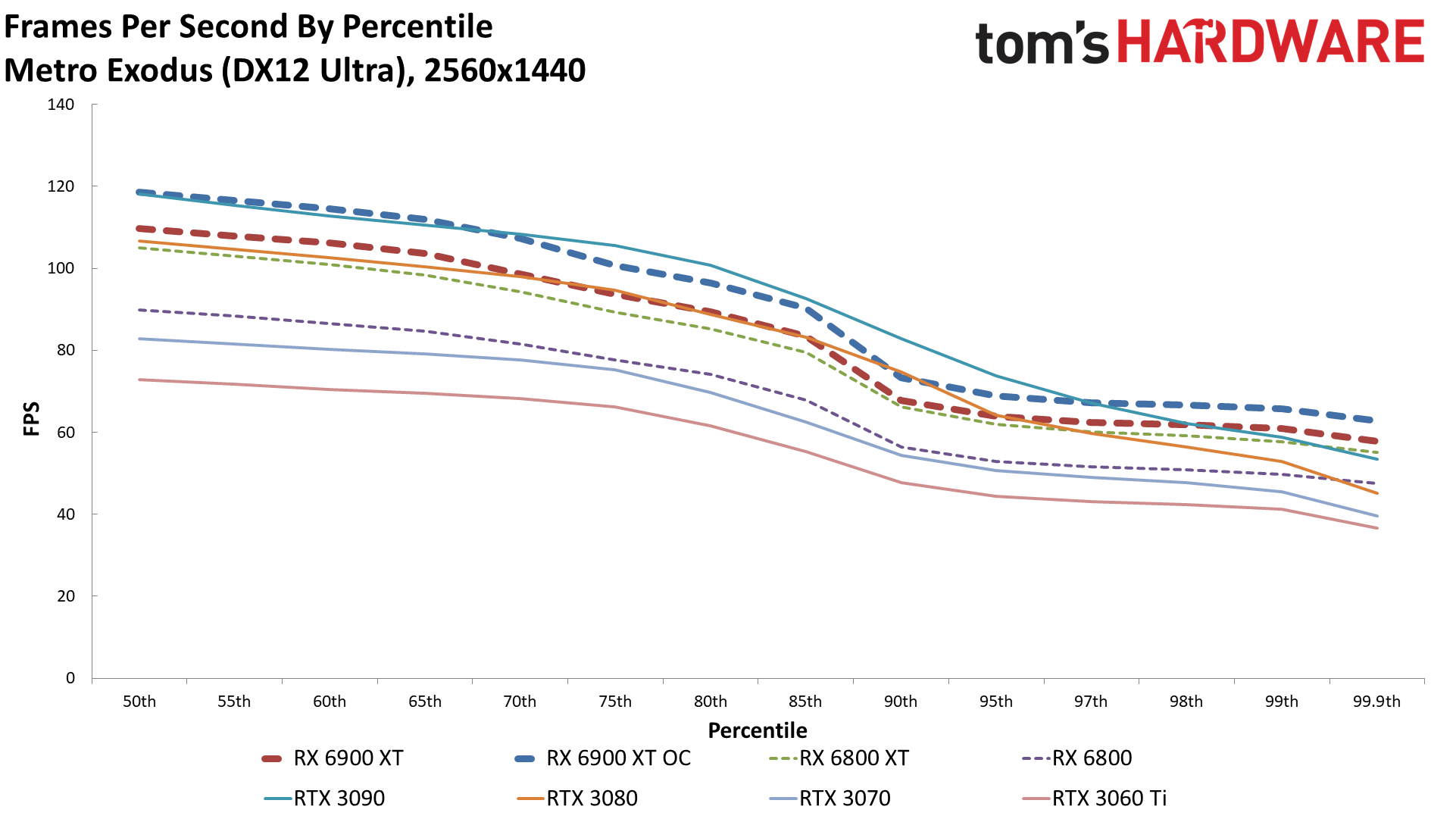
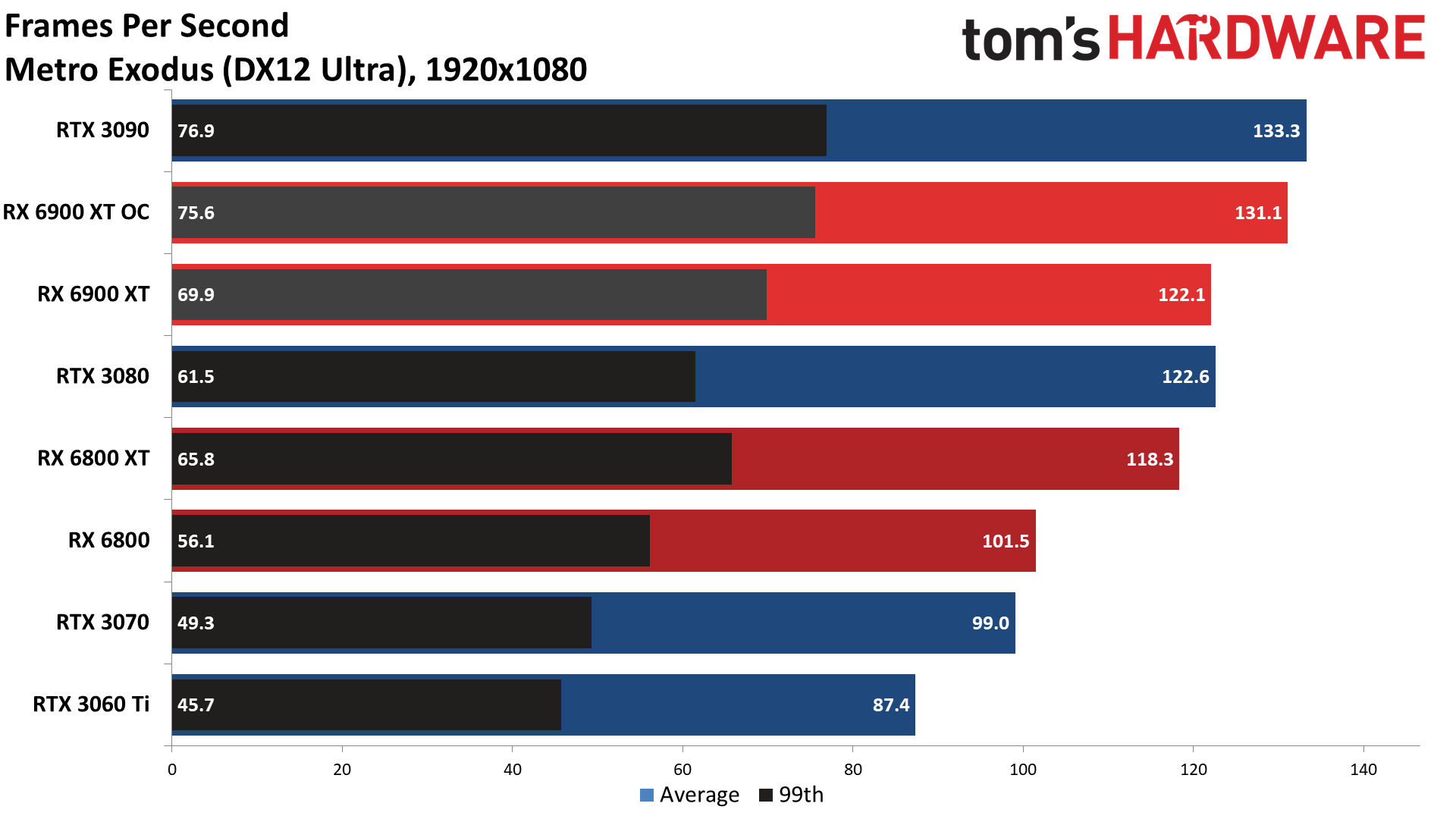

Nvidia redeems itself a bit in Metro Exodus, with the 3080 basically matching the 6900 XT (though with slightly lower minimum fps) and the 3090 taking the top spot. This is also one of the first games to support ray tracing, and we'll look at it again with DXR enabled below. As with most of the other games, even though the 6900 XT and 3090 are higher on the charts, the 6800 XT and RTX 3080 are the better values (provided you can find them at MSRP — or in stock at all).
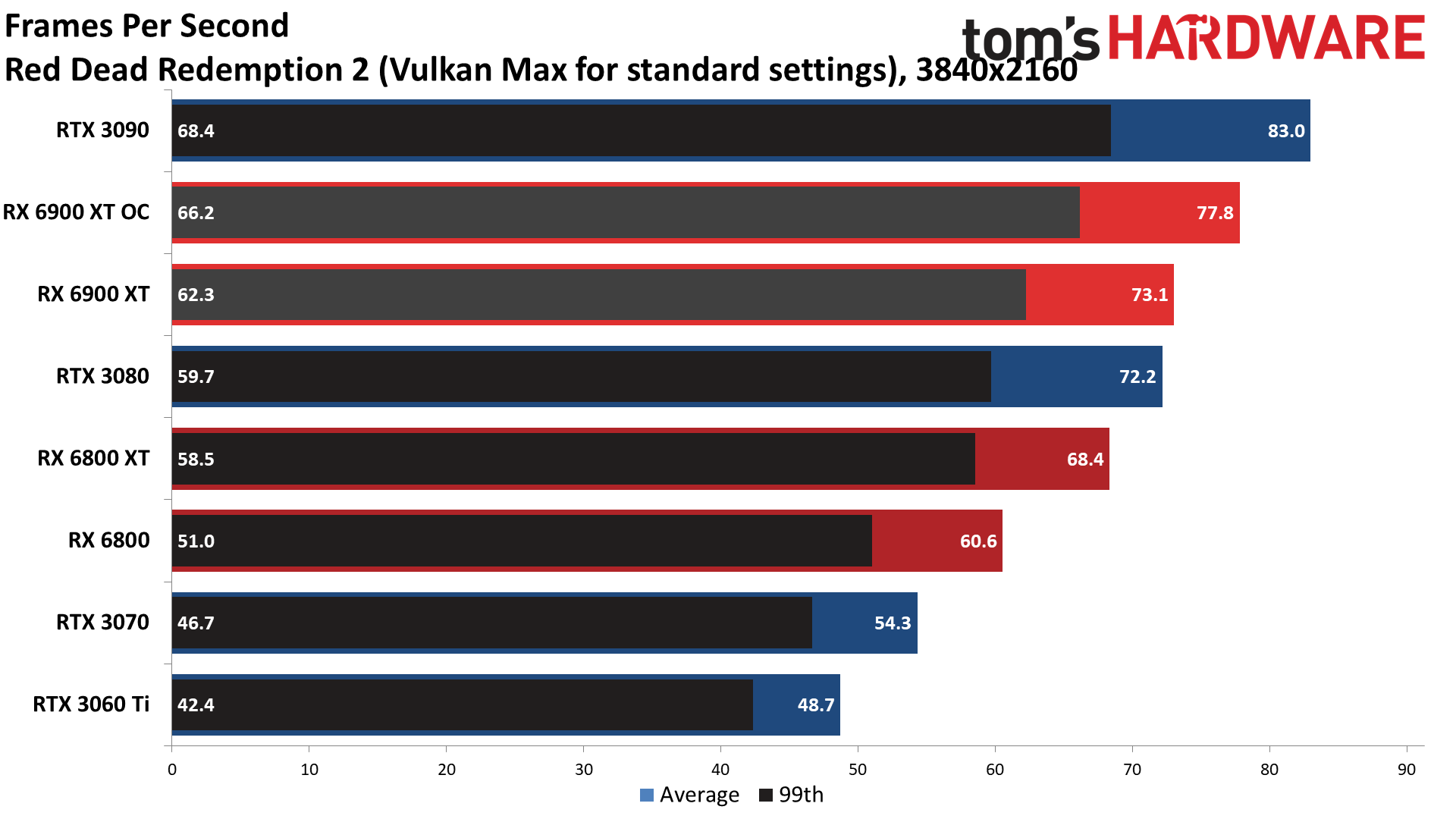
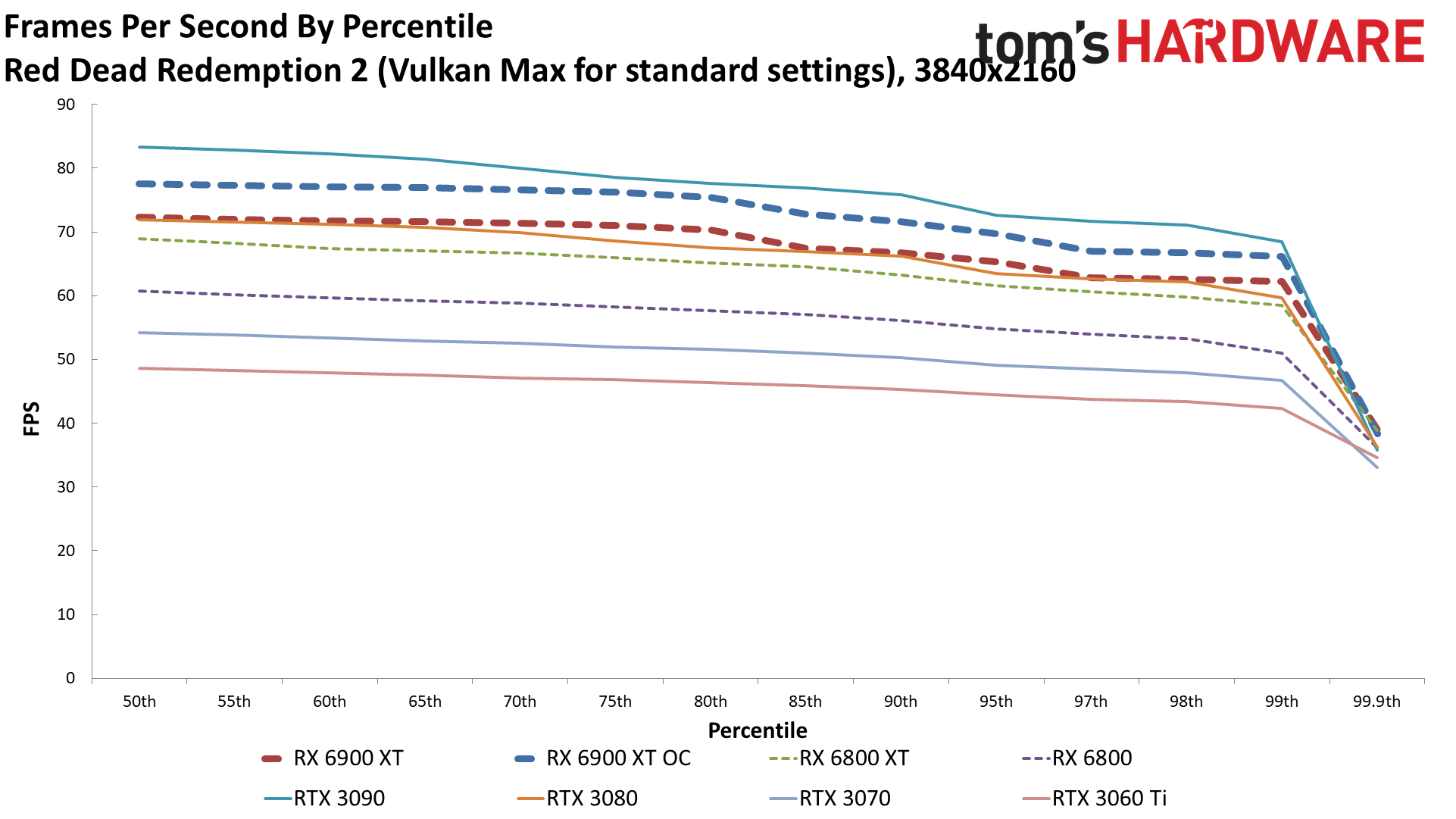
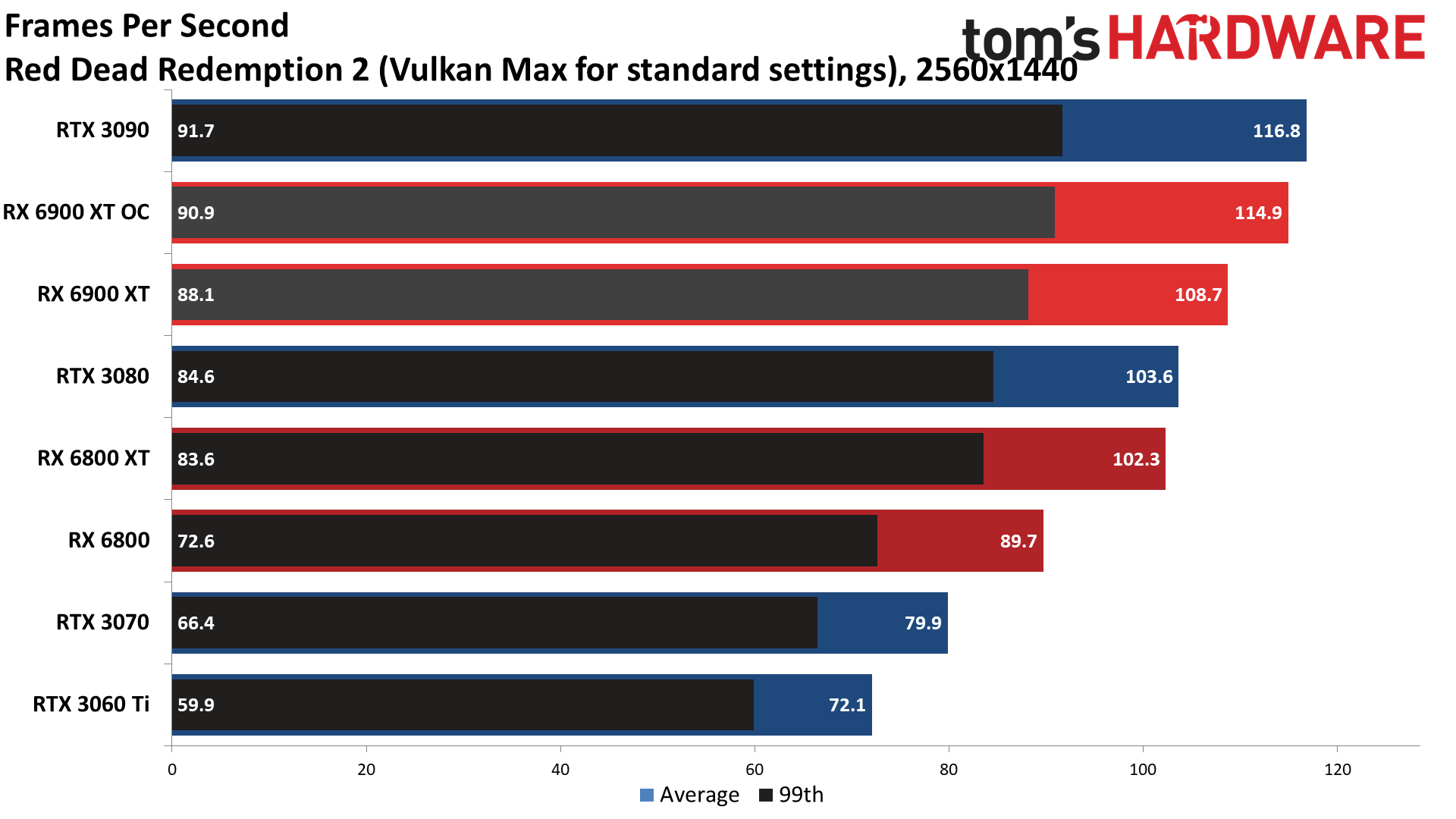
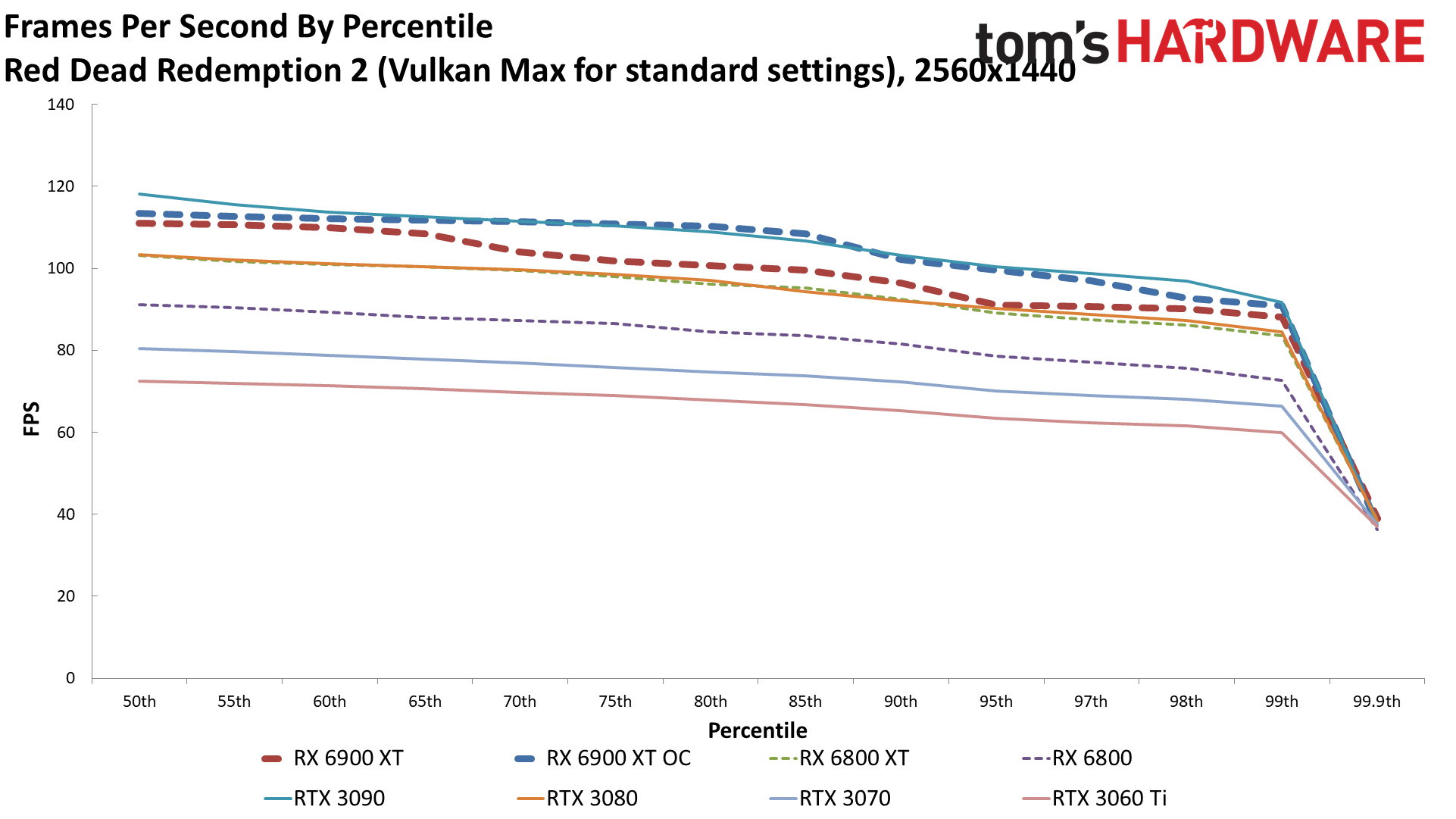
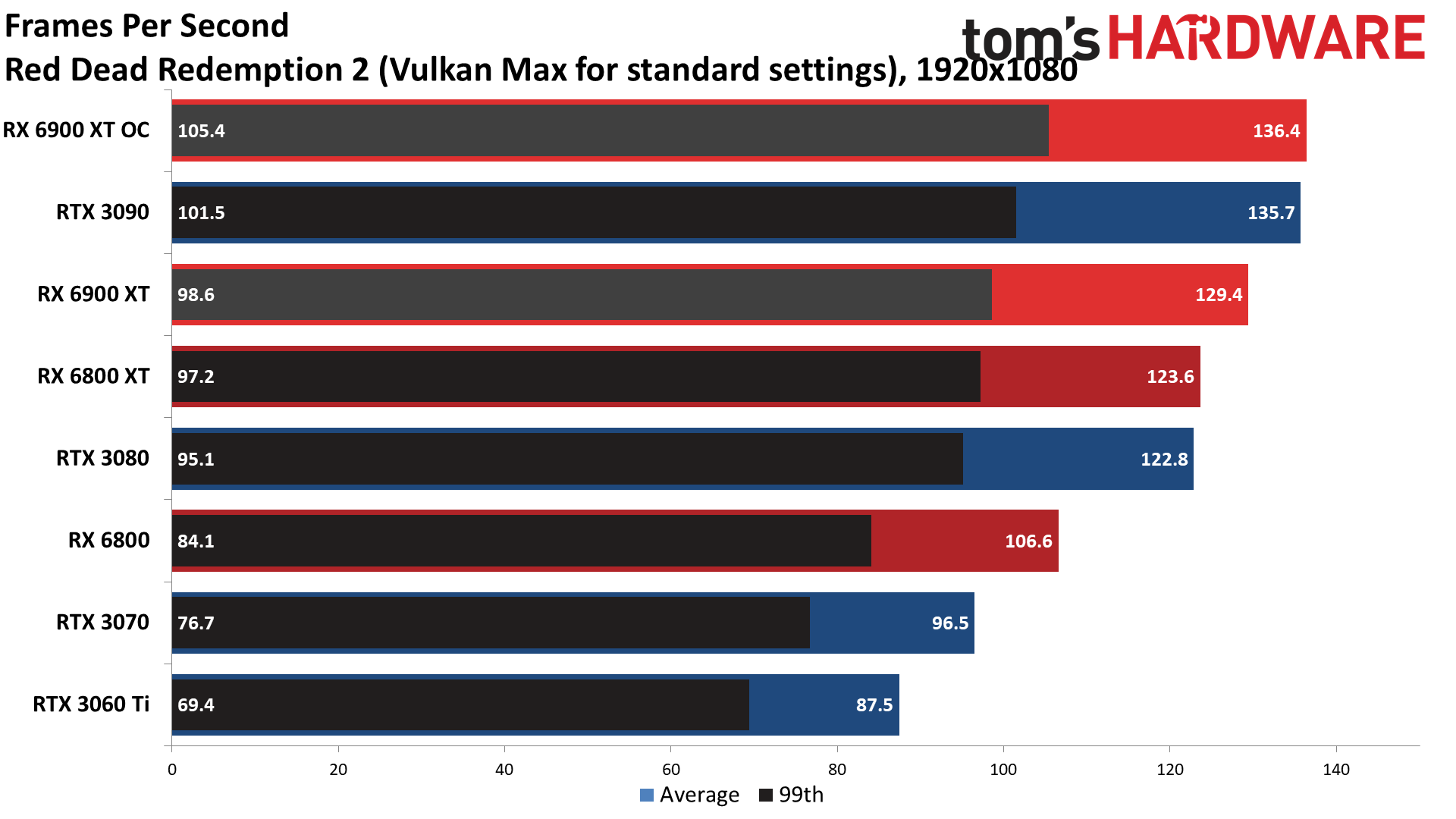
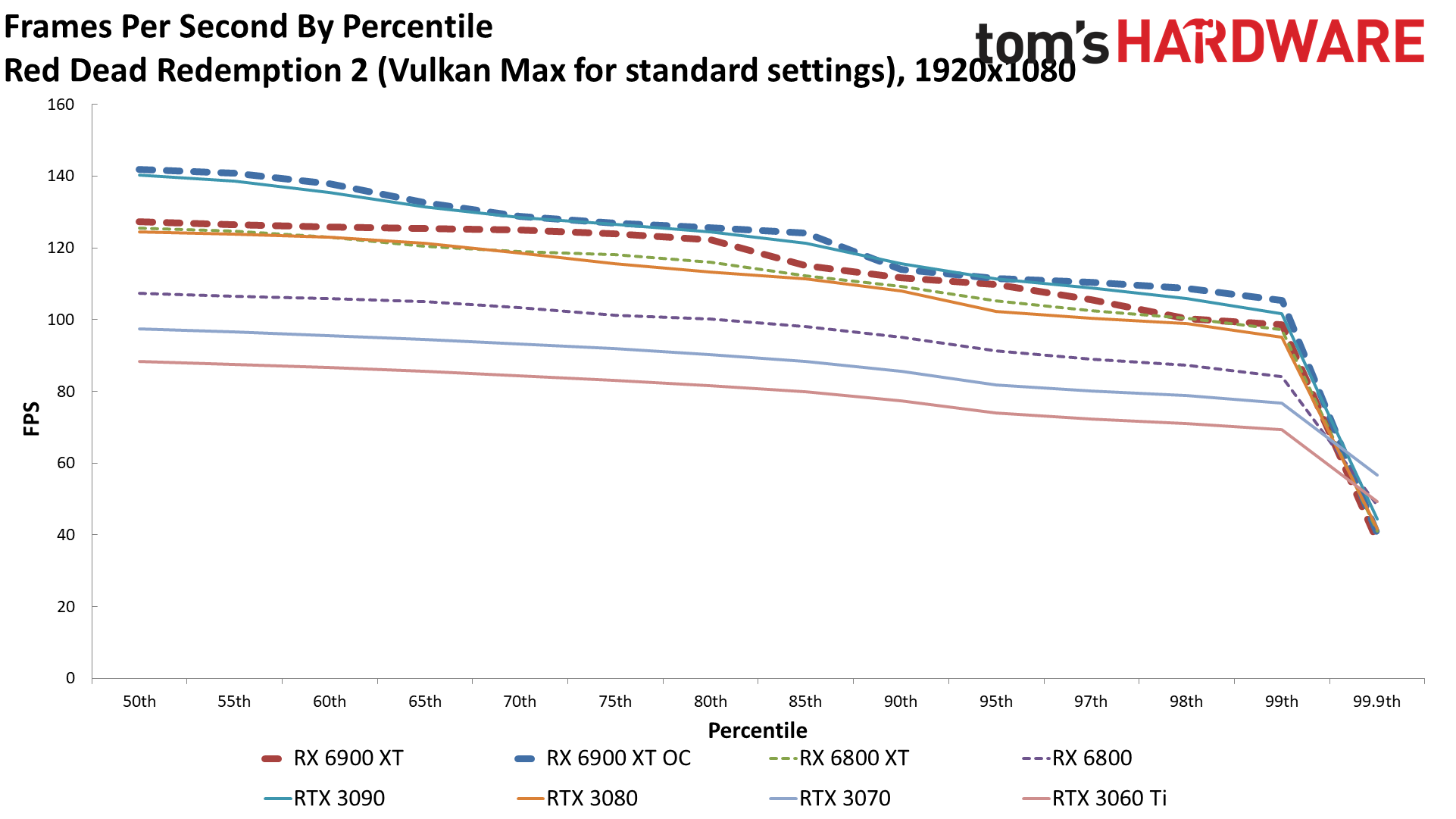
We didn't max out every setting in Red Dead Redemption 2, leaving the advanced options mostly at their minimum values. Still, as our first Vulkan API game, it's nice to see multiple cards now clearing 60 fps. The 3090 leads the 6900 XT again, though not by enough to warrant a 50 percent increase in price if gaming performance is your primary concern.
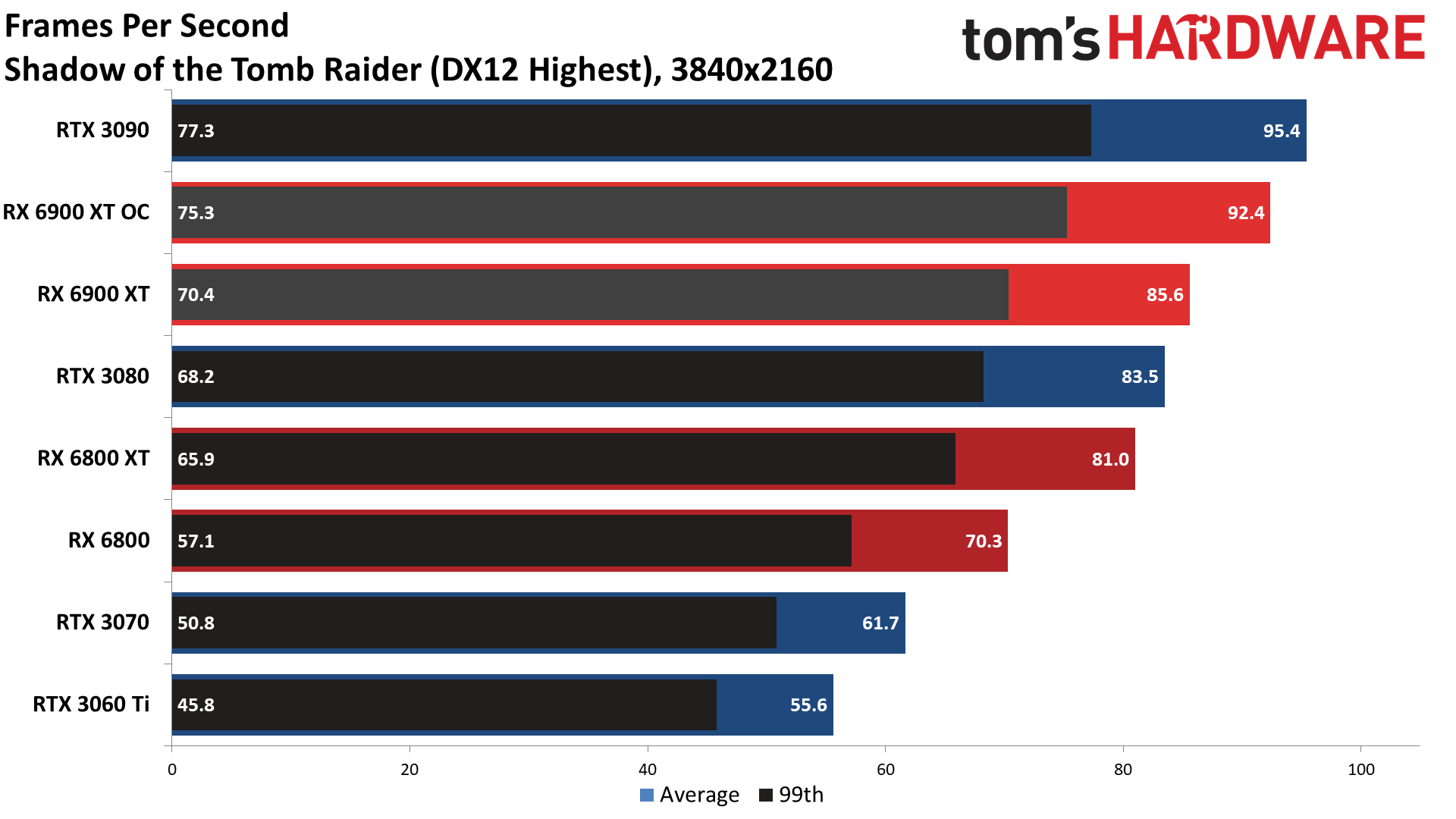
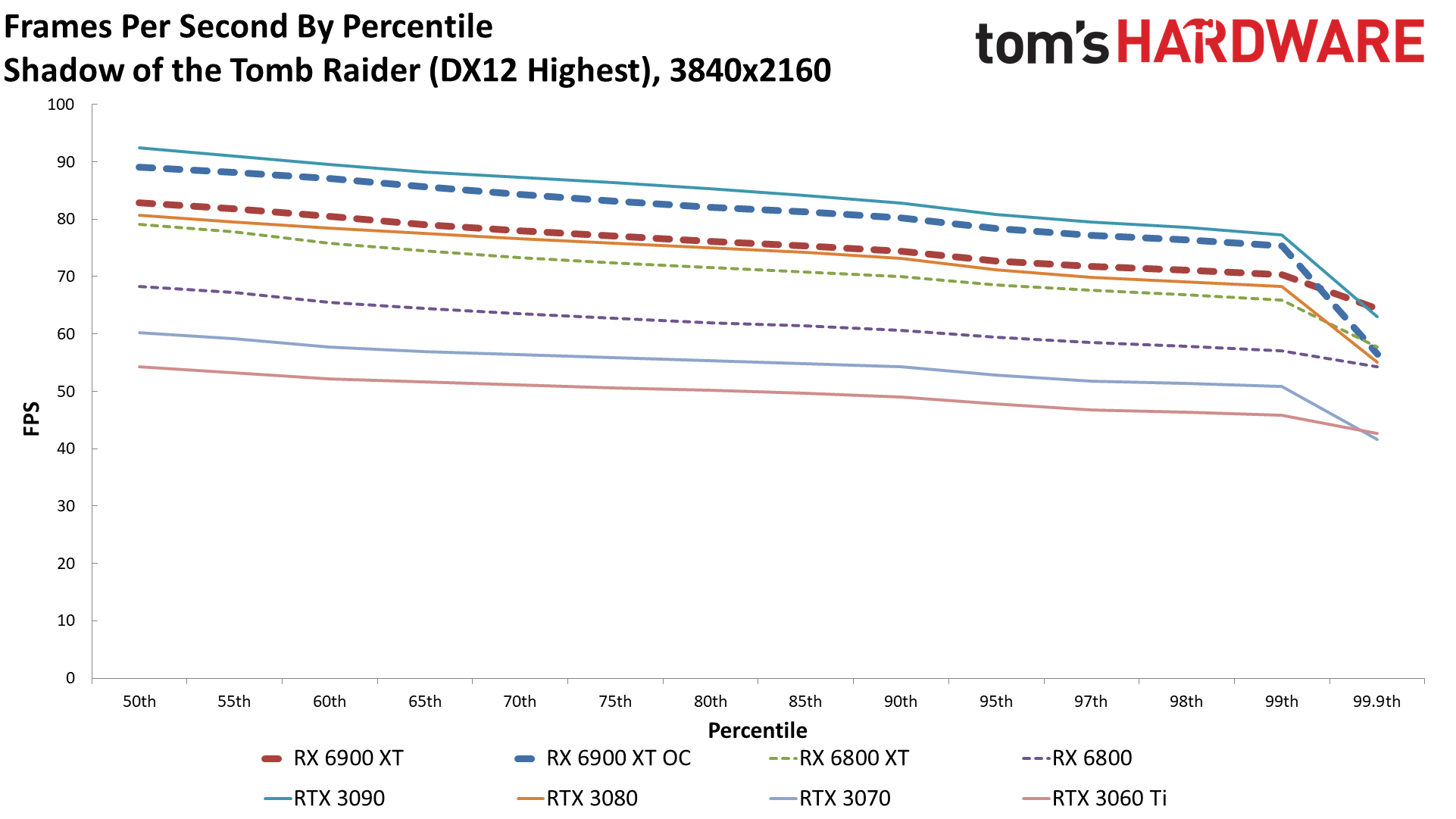

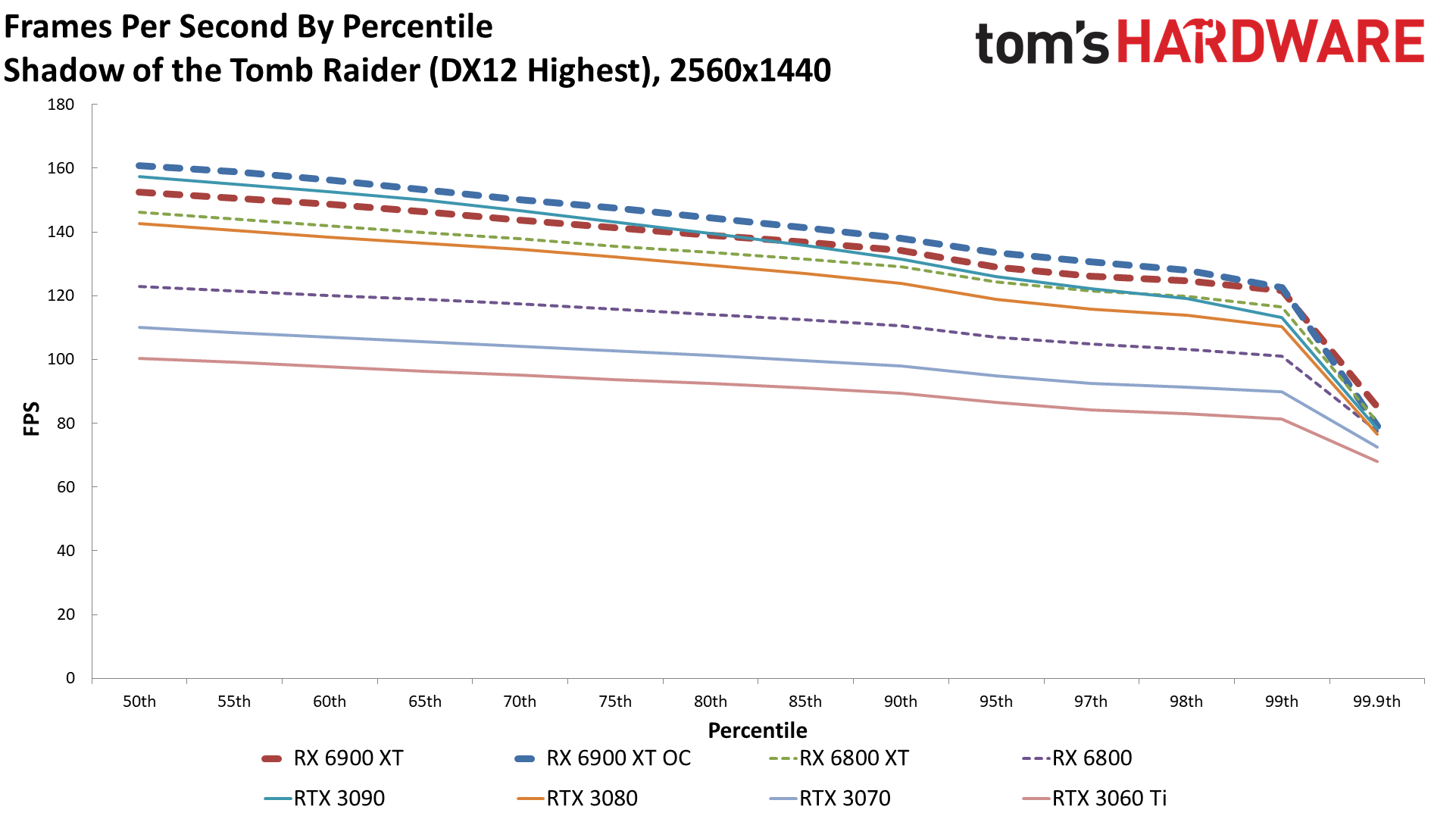
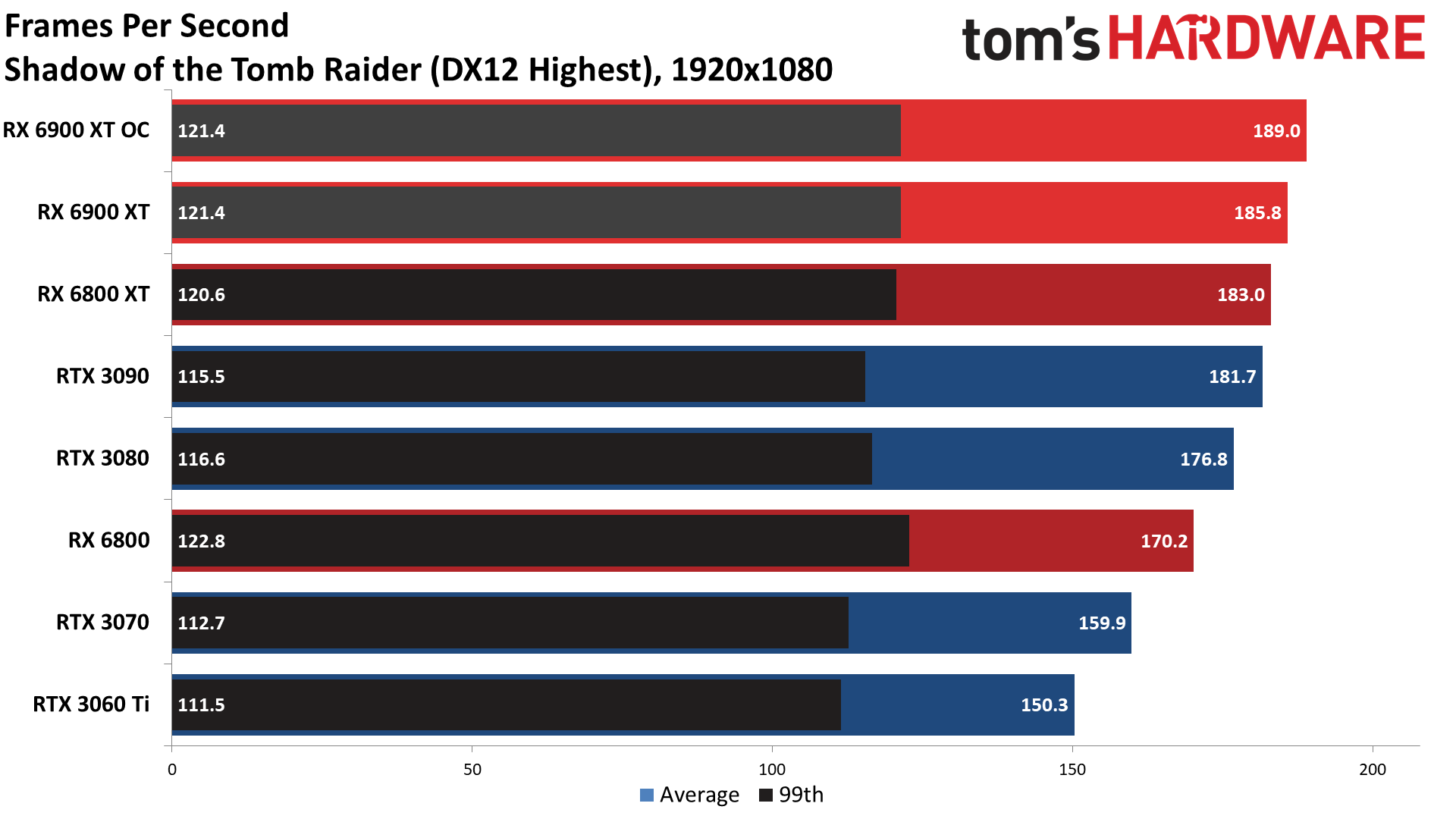
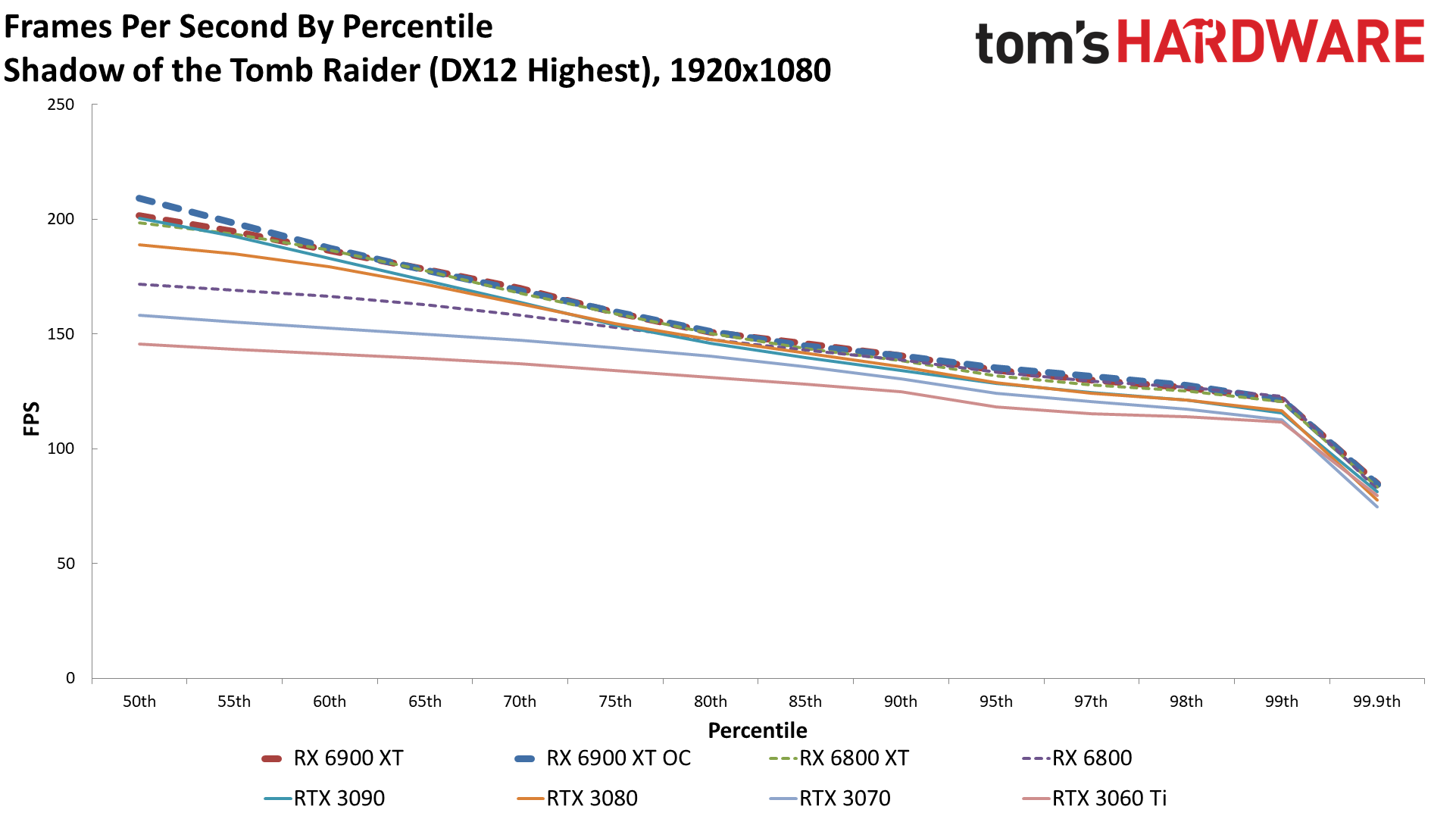
Another Nvidia game, the RTX 3090 leads at 4K in Shadow of the Tomb Raider. However, the 6900 XT delivers better minimum fps at 1440p and 1080p, with CPU bottlenecks becoming pronounced at the latter. This is another DXR enabled game that we'll look at again below.
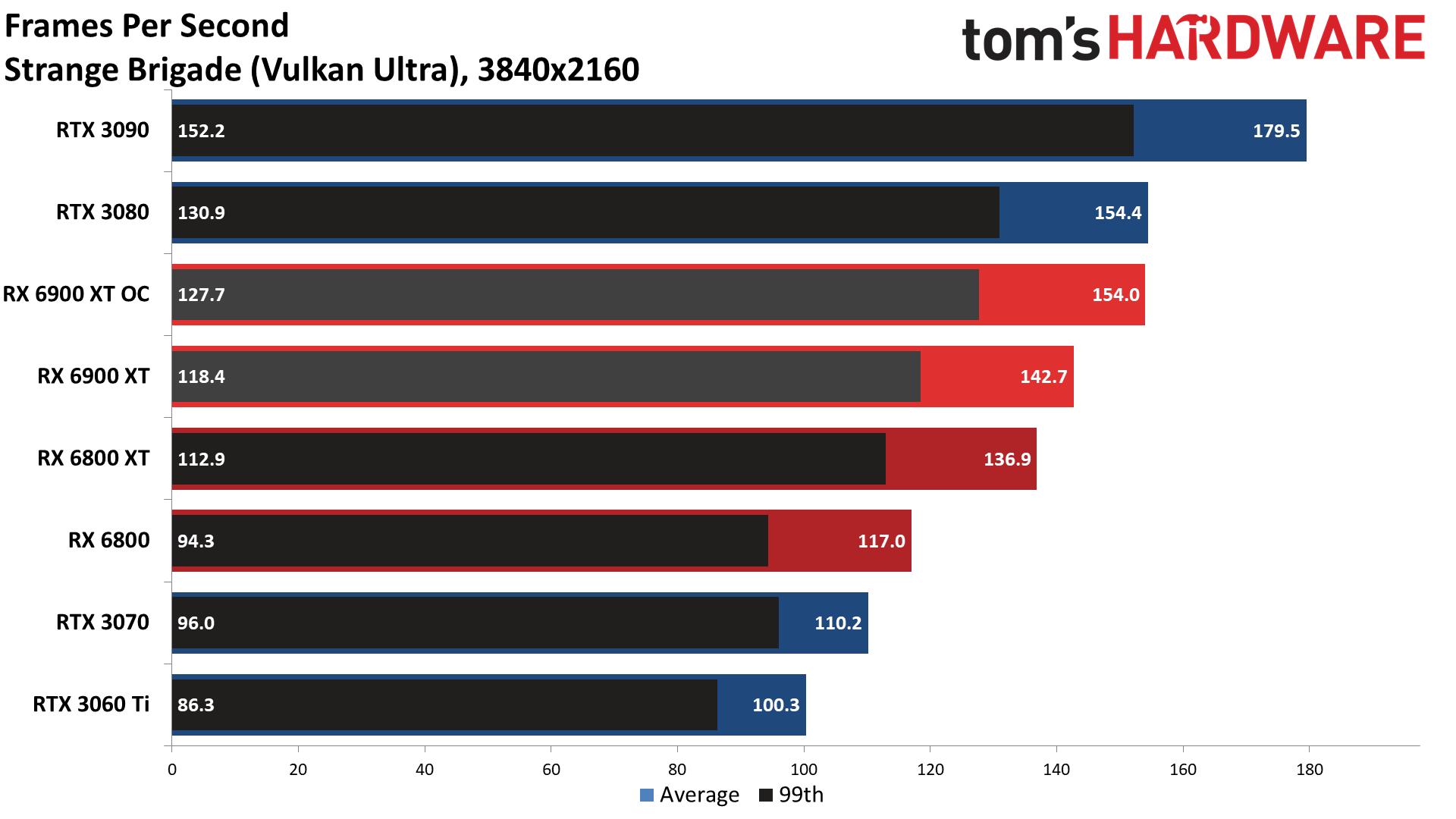
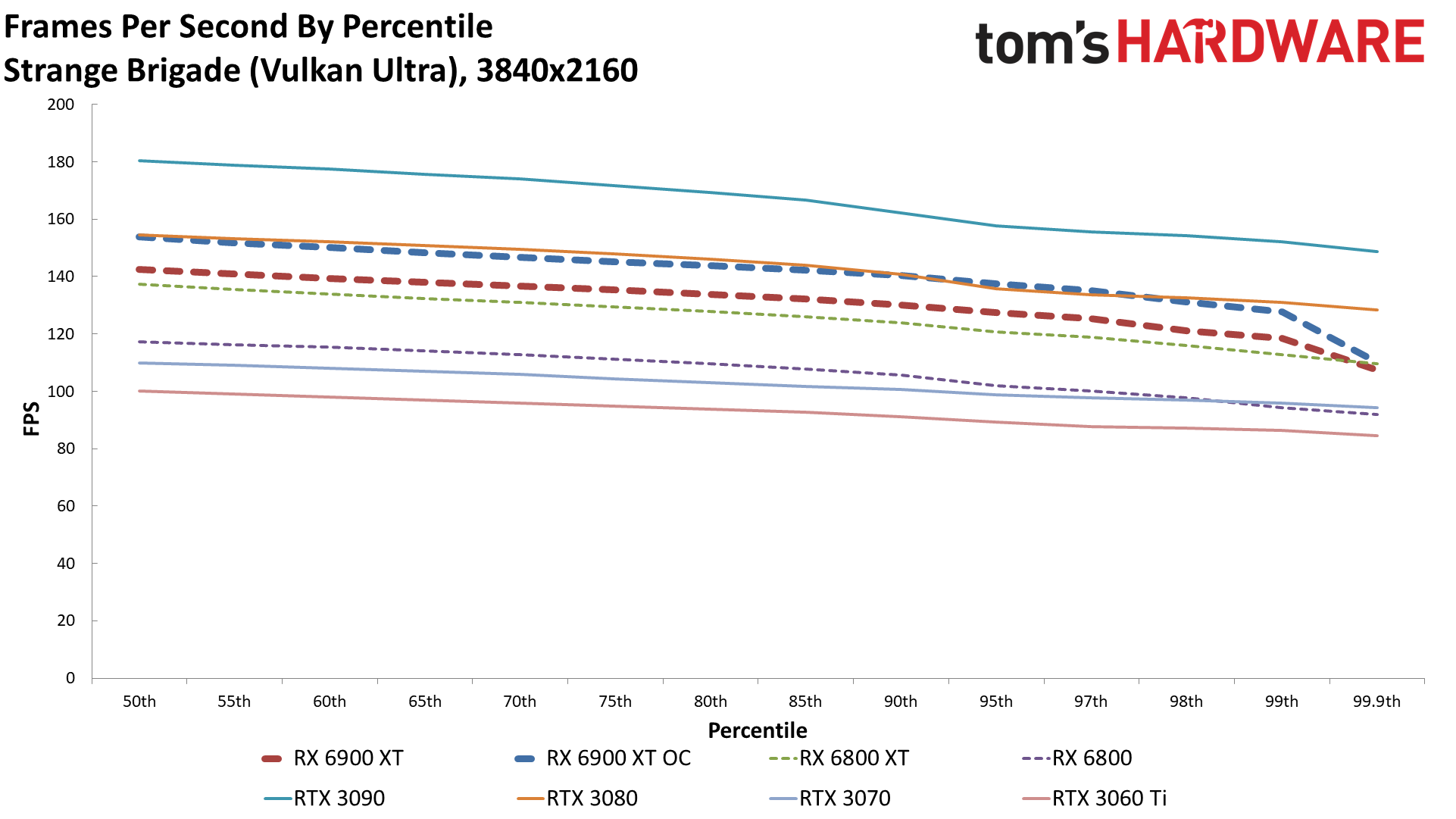
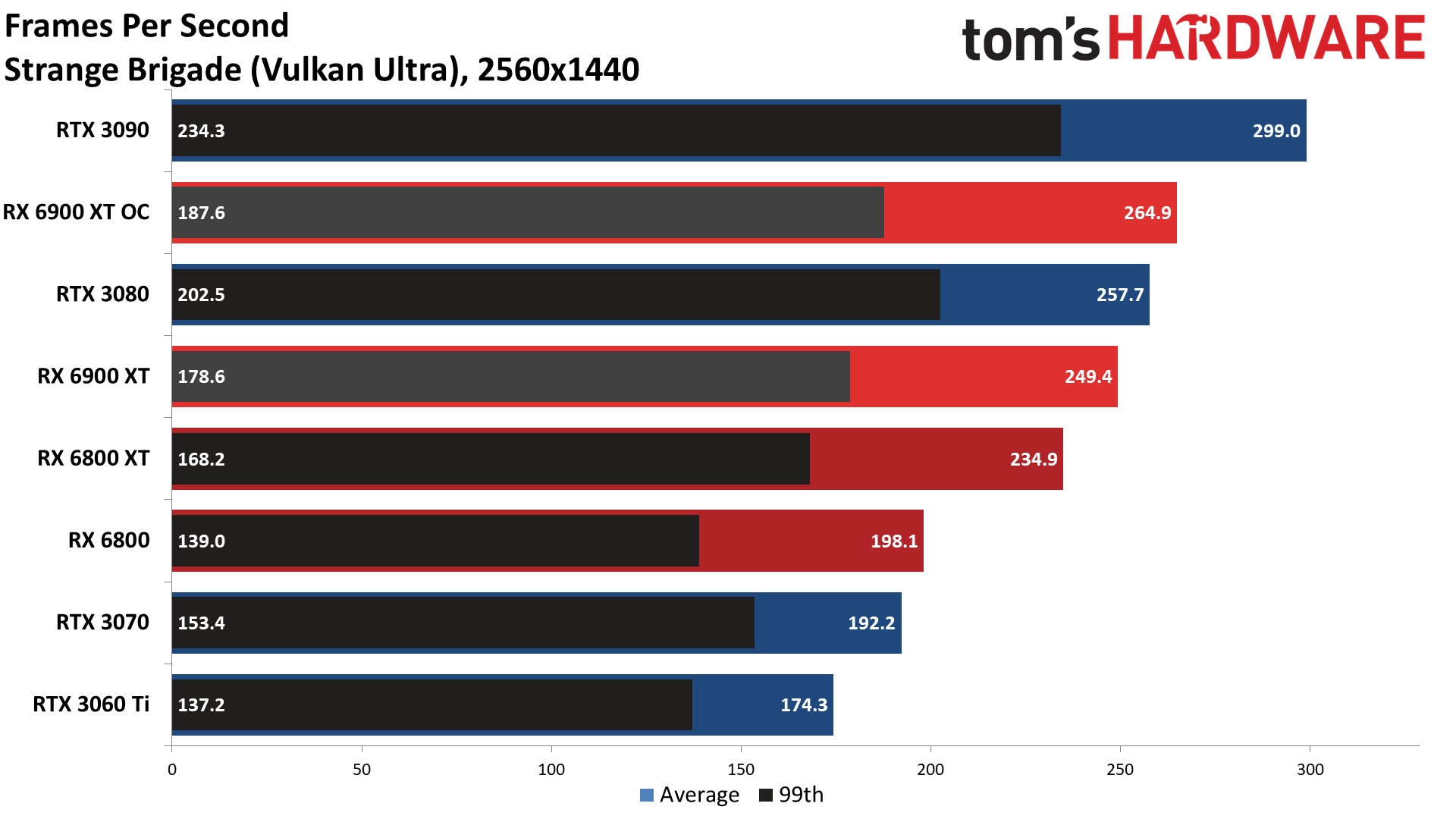
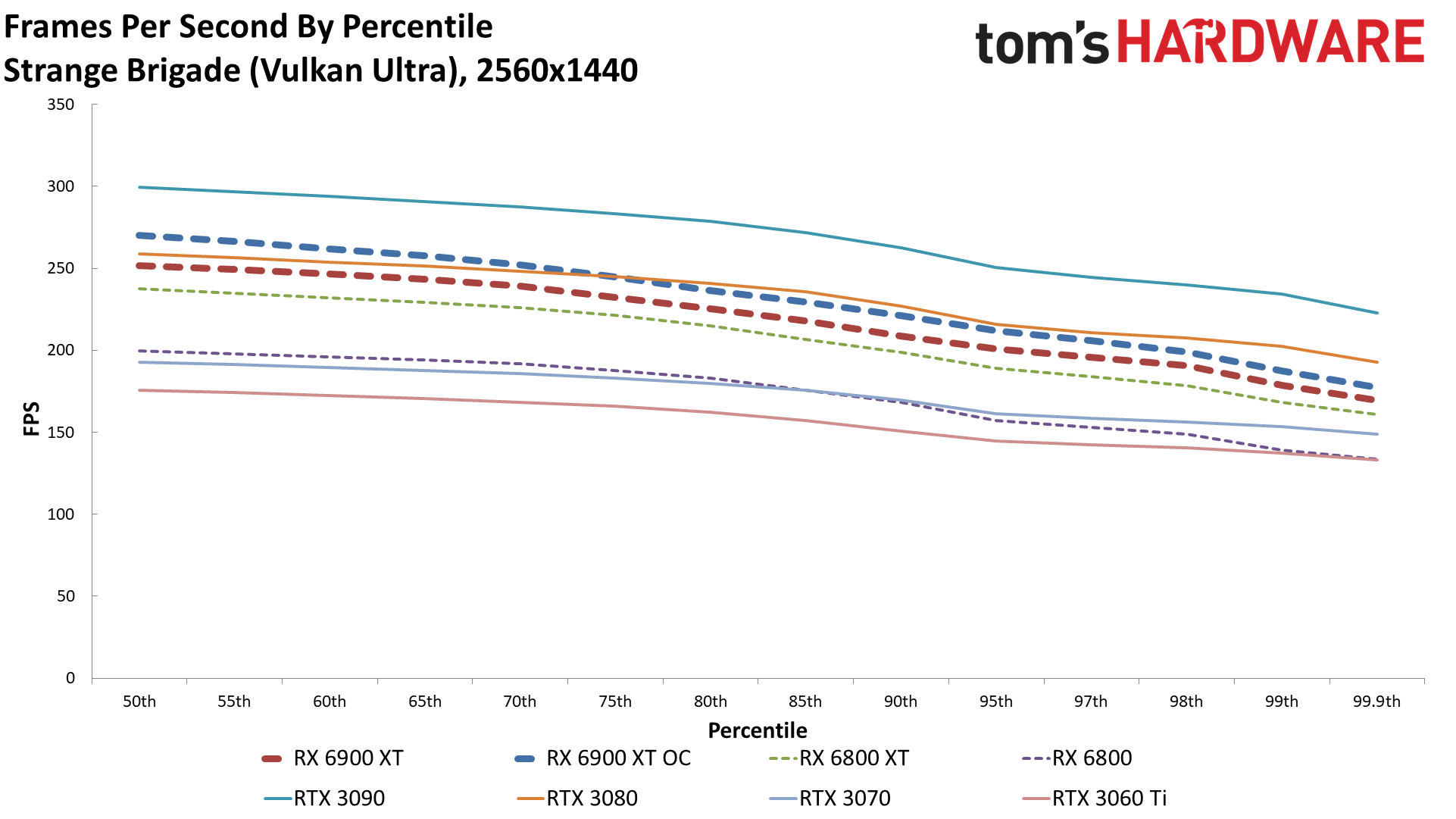
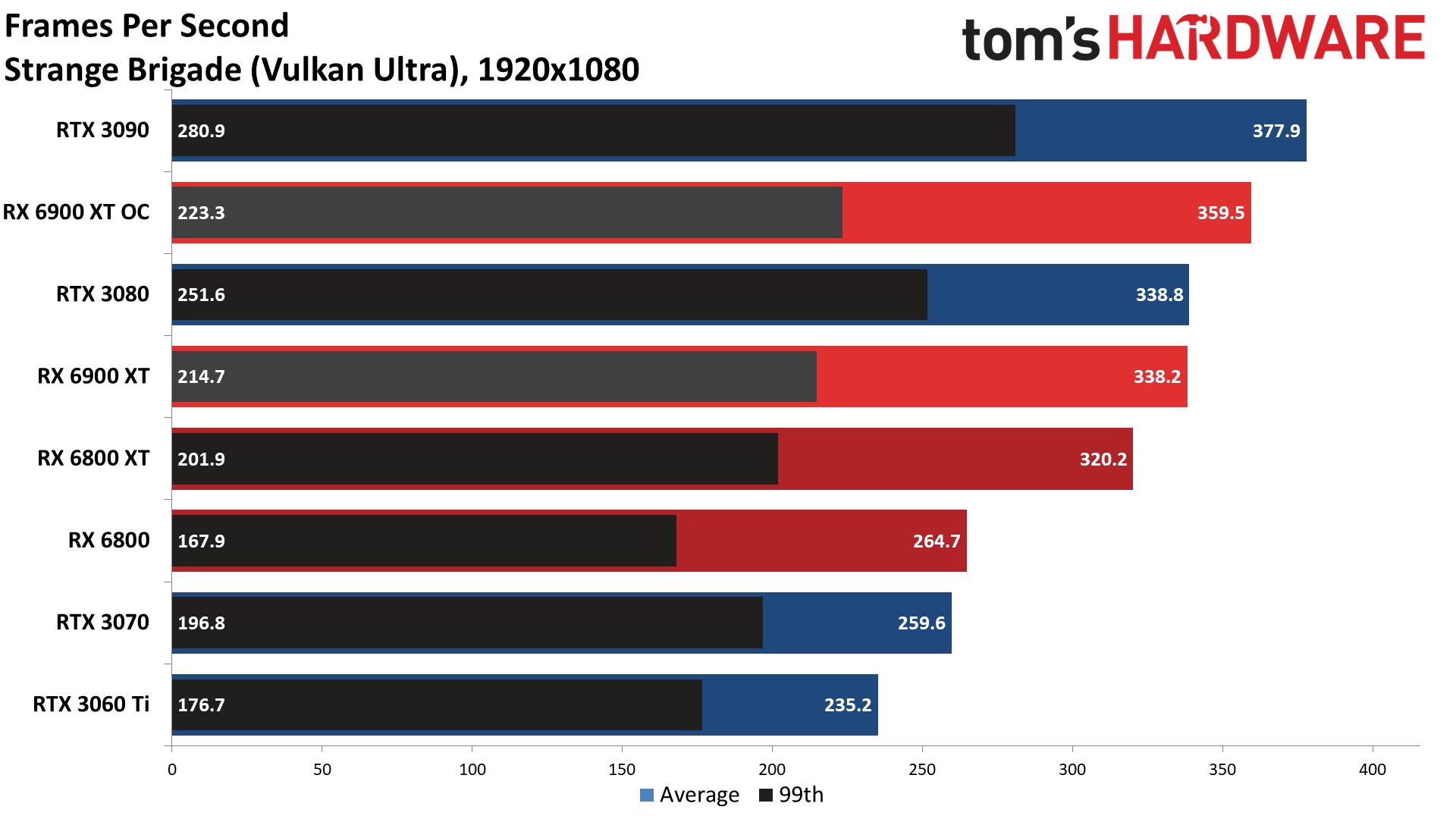
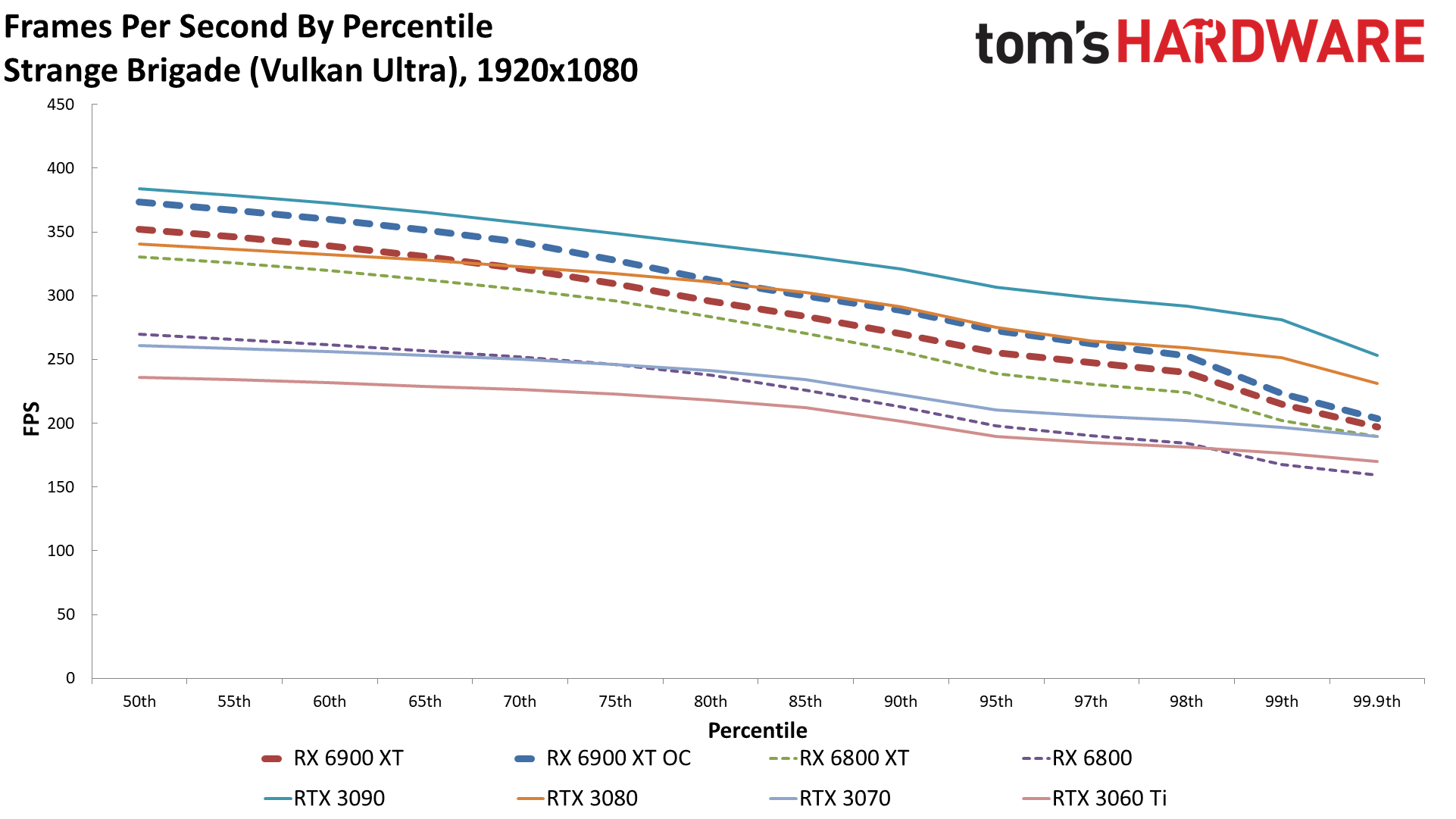
Strange Brigade is our other Vulkan API game, and it strongly favors Nvidia's GPUs, even though it was originally an AMD promotional game. Not that it matters too much, as it's not a particularly popular game, and all of the GPUs hit very high fps at 4K. If you have a 4K 144 Hz display, perhaps Nvidia's GPUs are the better choice. At 1440p and 1080p, where we see frame rates approach and then cross the 300 fps threshold, however, there are better tests of a GPU's capabilities these days.

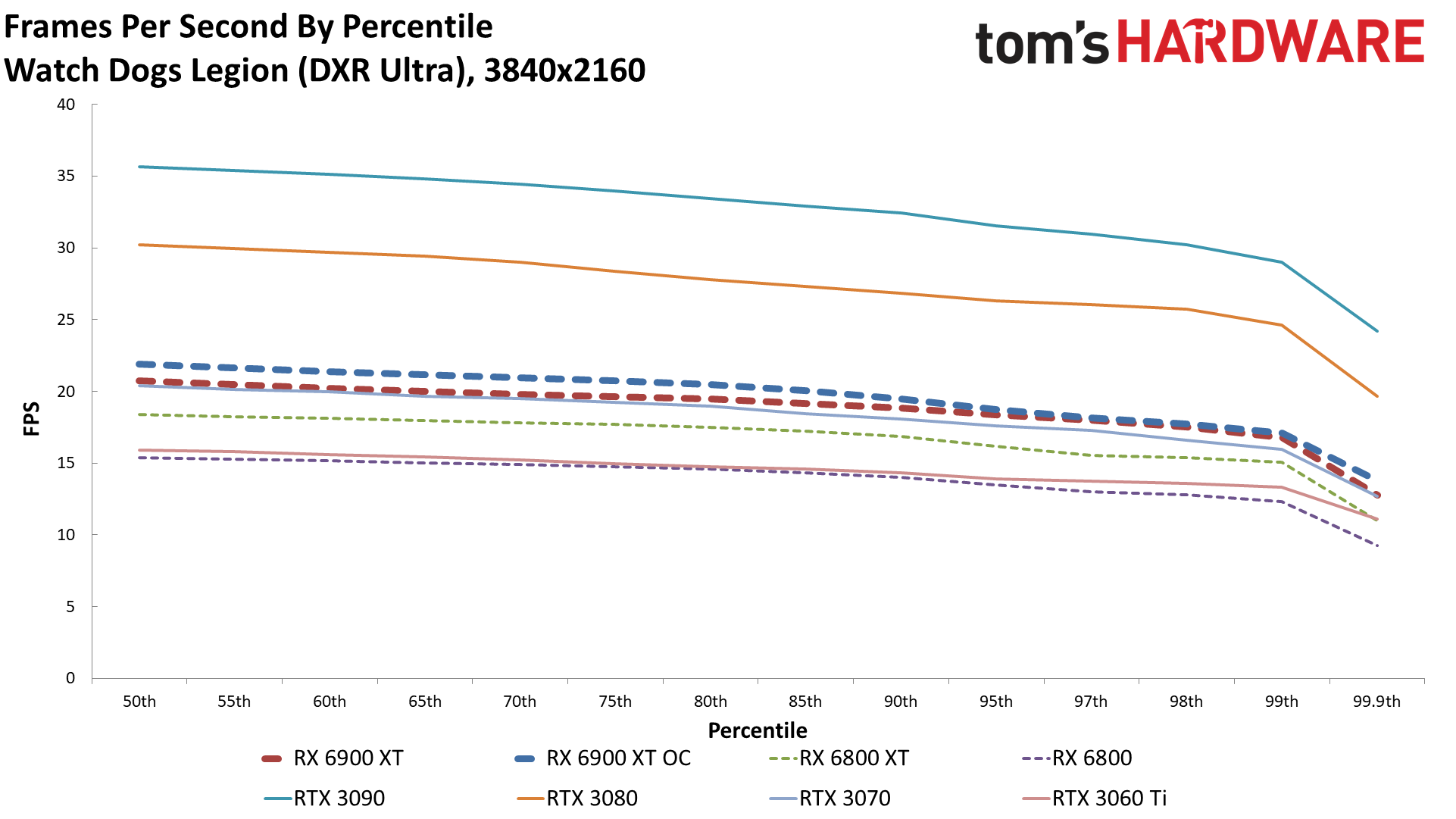
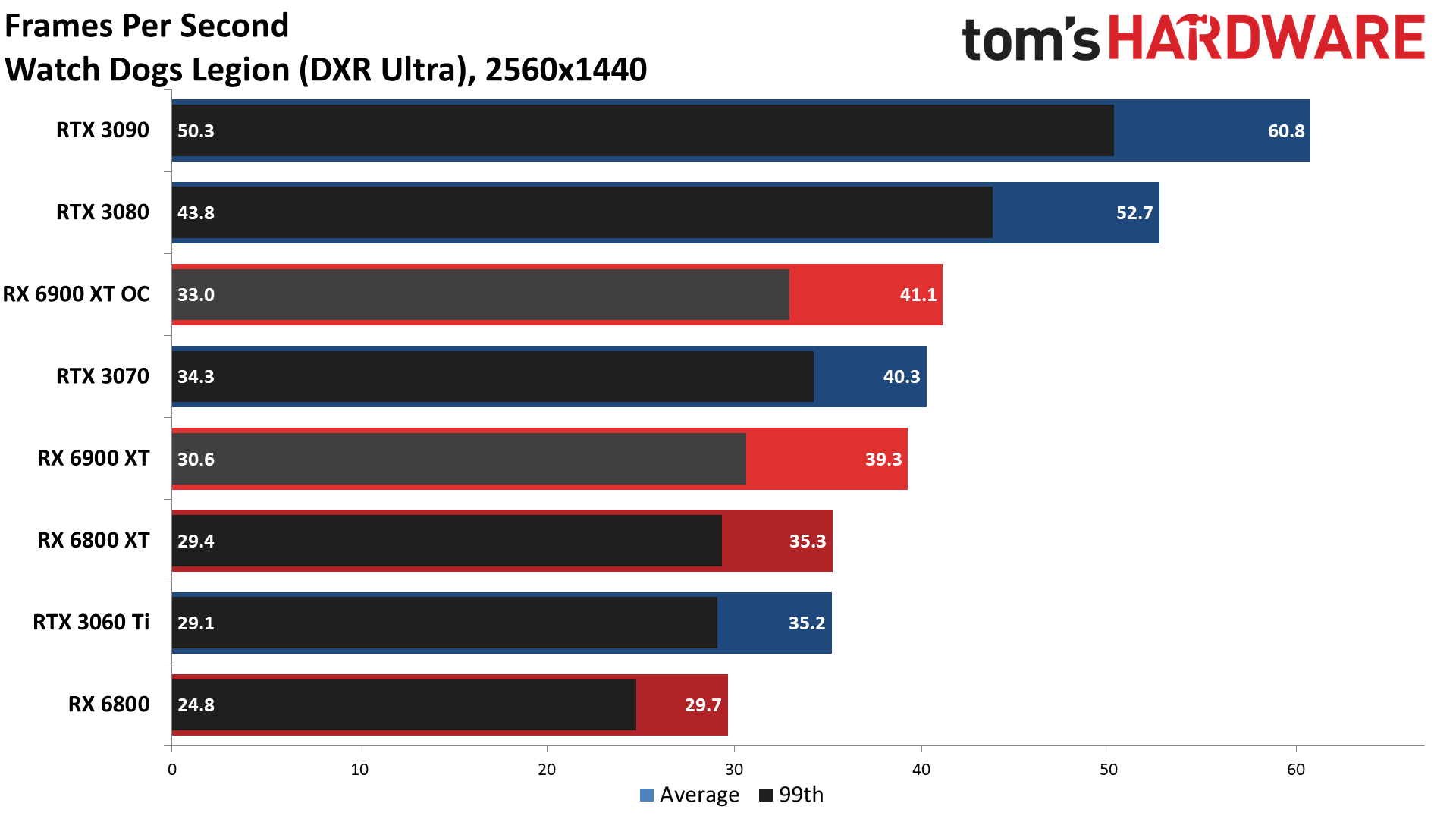
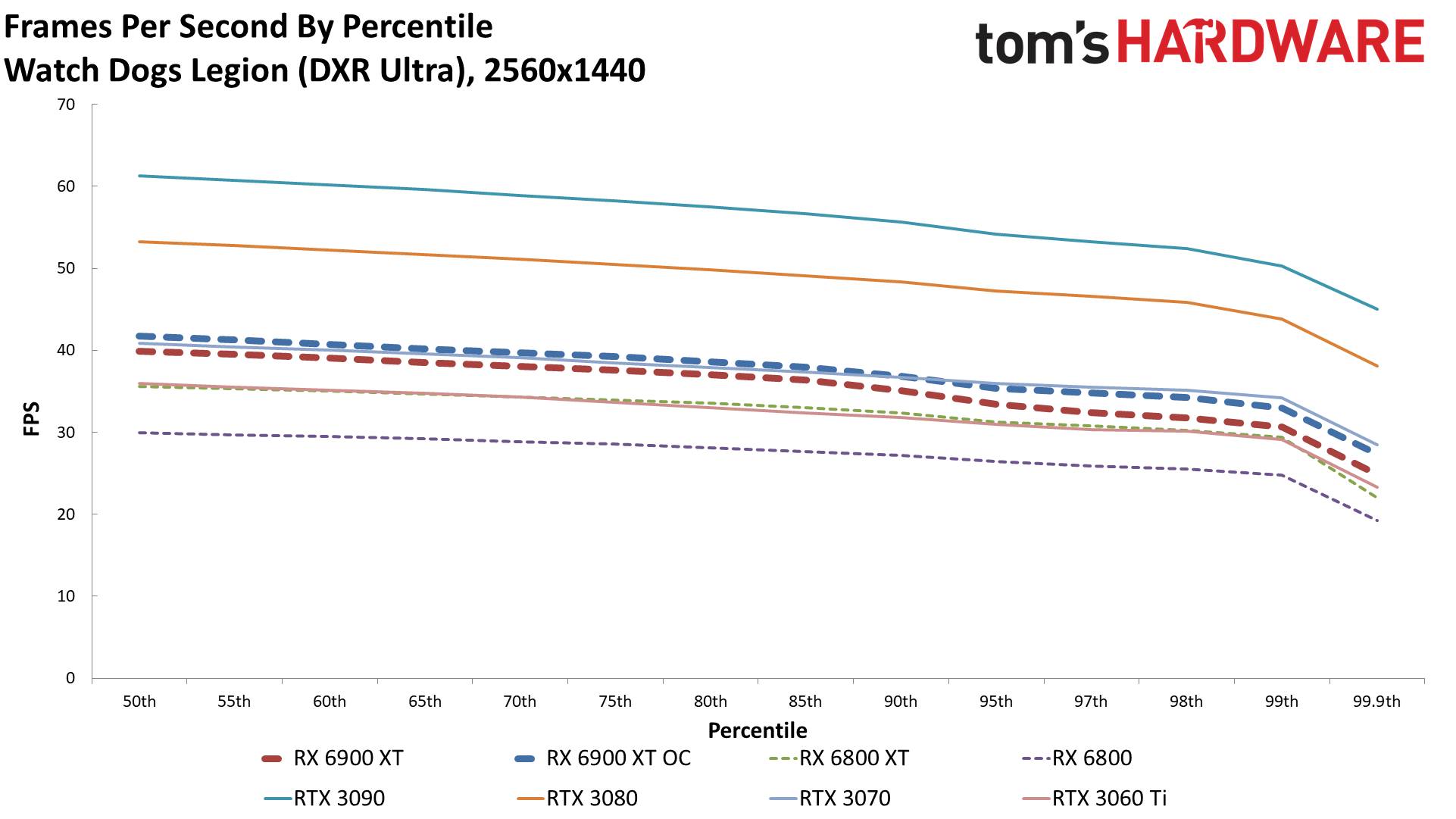
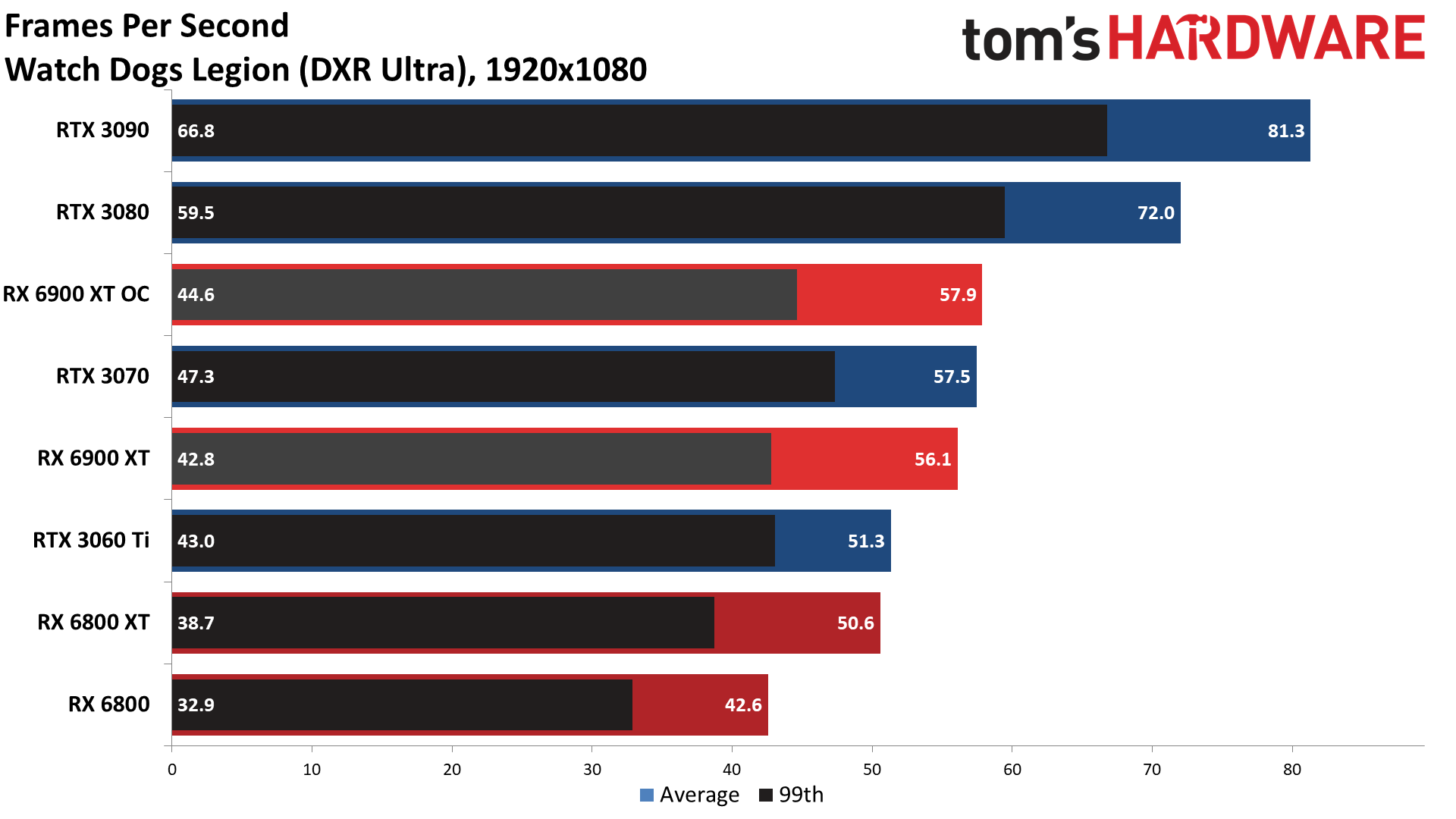
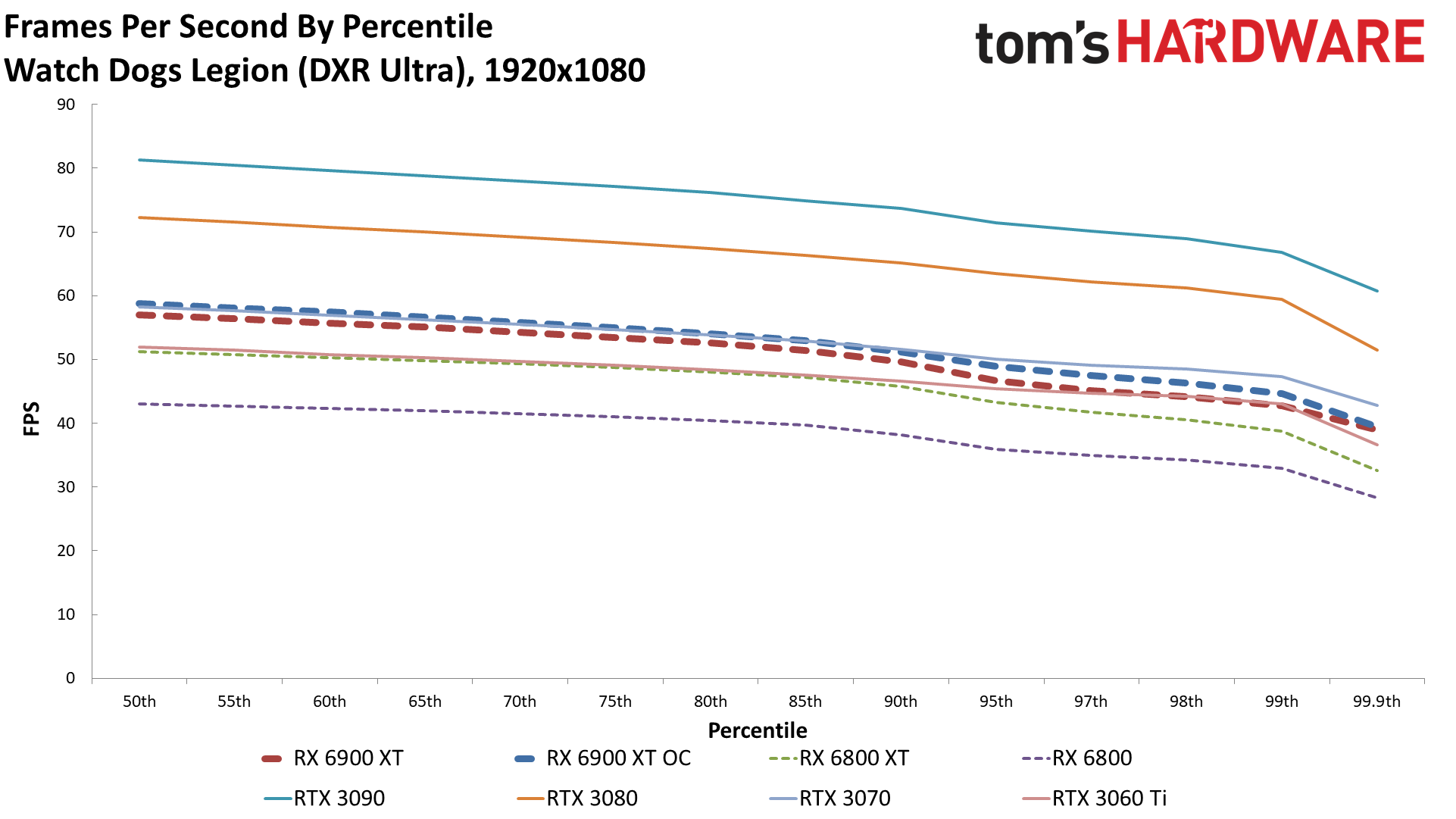
Our final game is the second with ray tracing. AMD's launch drivers for the 6800 series didn't render DXR effects properly in Watch Dogs Legion, but public drivers and 6900 XT launch drivers have fixed at least many of the rendering errors. As a result, performance has dropped by around 30 percent for the AMD GPUs, giving Nvidia it's biggest lead yet. The 3090 is 70 percent faster than the 6900 XT at 4K, 55 percent faster at 1440p, and 45 percent faster at 1080p — and that's without enabling DLSS! Even the RTX 3080 crushes AMD's top GPU by 30-45 percent in this game when using ray tracing. Turn on DLSS Quality mode, and the Nvidia GPUs can extend their lead by another 20-30 percent.
MORE: Best Graphics Cards
MORE: GPU Benchmarks
MORE: All Graphics Content
Current page: Radeon RX 6900 XT — Test Setup
Prev Page Features and Specifications Next Page Radeon RX 6900 XT — Ray Tracing and DLSS Performance
Jarred Walton is a senior editor at Tom's Hardware focusing on everything GPU. He has been working as a tech journalist since 2004, writing for AnandTech, Maximum PC, and PC Gamer. From the first S3 Virge '3D decelerators' to today's GPUs, Jarred keeps up with all the latest graphics trends and is the one to ask about game performance.
-
Makaveli i'm confused is this an old review that was reposted?Reply
It mentions AMD's need a competitor to DLSS like FSR isn't already out, then there is mention of the 3080ti like it hasn't been confirmed yet. -
JarredWaltonGPU Reply
Yeah. For various reasons, our reviews were initially done as a single page in a different template (that doesn't show scores and other minor differences). One of the managing editors at Tom's Hardware is going back through some of my recent graphics card reviews and switching them to the review template. The text and content hasn't been changed, but I guess it posts with the new date.Makaveli said:i'm confused is this an old review that was reposted?
It mentions AMD's need a competitor to DLSS like FSR isn't already out, then there is mention of the 3080ti like it hasn't been confirmed yet. -
dunkyboy Reply
Wow. You are a tech website and you can't work out how to change the date of a post. This really doesn't do good things for your credibility.JarredWaltonGPU said:Yeah. For various reasons, our reviews were initially done as a single page in a different template (that doesn't show scores and other minor differences). One of the managing editors at Tom's Hardware is going back through some of my recent graphics card reviews and switching them to the review template. The text and content hasn't been changed, but I guess it posts with the new date.
You also then end up spamming my news feed with old irrelevant articles. -
NeoMorpheus Thanks for the review.Reply
I honestly wish that sites would stop being scared of nvidia marketing dept and place a disclaimer that all nvidia tech is really a lame way to lock the customer to their hardware, as proven by AMD FXR and the anti-consumer crap called dlss. -
Howardohyea Reply
one thing, coding and hardware isn't the same at all. Secondly, if you don't like their articles then go read another publisher's. Don't complain about it in the comments.dunkyboy said:Wow. You are a tech website and you can't work out how to change the date of a post. This really doesn't do good things for your credibility.
You also then end up spamming my news feed with old irrelevant articles.
Personally I like the formatting where it's divided into different pages, makes finding benchmarks easier.
Now here's my thoughts on the 6900XT: absolute joke, just like the 3080Ti and 3090.
If literally all you care about is gaming the 3080 and 6800XT are excellent cards (at normal pricing), and like the article pointed out, there's literally nothing different between the 6800XT and 6900XT except the cores. Memory and everything else is the same. Might save 50% price for 10% performance.
At least with 3090 you get 24GB of VRAM so content creators will love that. Plus it's faster than the 6900XT so people looking for the "absolute best" will go for the 3090 instead of AMD. -
JarredWaltonGPU Reply
I actually went through and reread the old review, then updated sections that were no longer correct and/or relevant. So, for example, FSR is now out, the RTX 3080 Ti is also here, prices are still fubar. But the review as it stands now should be generally correct in light of the current market situation.JarredWaltonGPU said:Yeah. For various reasons, our reviews were initially done as a single page in a different template (that doesn't show scores and other minor differences). One of the managing editors at Tom's Hardware is going back through some of my recent graphics card reviews and switching them to the review template. The text and content hasn't been changed, but I guess it posts with the new date. -
Kamikazekerr Personally Nividia is hitting it's marks there simple but effective I've had a 3090,80,70oc,3060ti and a 3060 junk and Personally I only play warzone prior to the dlss for cards like the 3070 even on custom cooling it struggled badly even turning it right up.with custom cooling, the 3080 vram took a big hit and aswell my personal favorite 3090 vram gauge looked like you threw 5 bucks in a Lincoln continental. LOL......Fast forward a few months I get an ASUS LC 6900XT it ran fine but warzone cranked up his hard on any card while the 6900 remained cool with all the buttons and dials and lack of software I found the card did not perform to my liking and sold it and jumped back into a rog 3070...but then I go and buy a refence amd 6900xt because of the look and ekwb water block. Getter plugged in and bam 100 degrees at the junction while I wait for my water block I've got 3 arctic fans force feedijg this thing air and still to high 80's and 90s which I do not like not to mention artifacting outta the box using only amd oc settings...so I pull it apart today no thermal anything under backplate..add my own from ekwb....then scrape the pad off the cooler side of the chip then watch the stock thermal pads almost Disintegrate under there own weight... replace them and repaste went fromReply
92 temp and 95 plus junction temp down to 75 to 82 ish temp and still a steady junction temp about 92 when working but still force feeding it air all around disappointment and the artifacting concerns me it's hit or miss now hopefully it comes around with the water. BUT all in all I would not recommend anything amd gpu related at this time...I hope to change that in the future but as of right now I'd take my Rog 3070 onwater over this 6900xt in performance for my needs and user friendly software and settings